|
MIGHTY OAKS FROM LITTLE
ACORNS GROW
|
IN THE BEGINNING - circa 1848
Early settlers in rural
Hillsborough County had to homestead their land just
like the pioneers of the West. And like the West,
Florida had an extensive Native American population long before
the first settlers arrived. Although historical records
are inconsistent regarding the degree of conflict
between the them and the early settlers, their presence did have a direct impact of the patterns
of settlements throughout the state and in Hillsborough
County. Due to the threat (or perceived threat) of attack, most of the
early settlements were located in close to forts such as
Fort Dade, Fort Pierce, Fort Meade, and Fort Brooke in
Tampa.
|
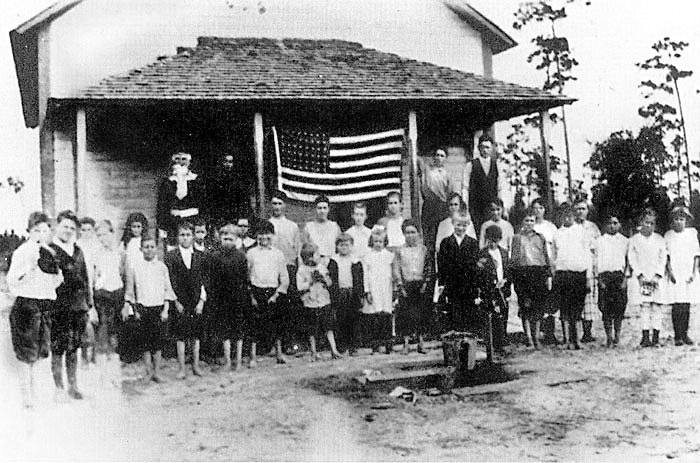 |
|
Santa Claus poses on the porch of Stemper
School A with faculty and students in the
early 1910s, where the teacher would ride
her white horse to the school every morning
from her home at Lake Magdalene. The first settlement in the area now known
as Lutz was originally a Catholic mission
started in the late 1880's by Luxembourg
Catholic priest Francis Xavier A. Stemper.
Stemper bought quite a bit of acreage on the
west side of Lake Bruing in section 13 of
township 27, range 18 east for the purpose
of starting a Catholic colony. Later,
the area on the north side of Stemper became
Lutz. Photo
courtesy of Nealie Squires from Citrus,
Sawmills, Critters & Crackers - Life in
early Lutz and Central Pasco County, by
Elizabeth & Susan MacManus, Univ. of Tampa
Press, 1998.
See History of Lutz at TampaPix.com
|
In the first
half-century or so after the establishment of a Hillsborough County Board of
Education and a Schools Superintendent, there were many
private schools being conducted in homes, churches, community buildings,
etc, scattered around the county. The teachers, if not volunteers,
and maintenance costs, were being
paid from tuition fees.
Most were one-room school houses with
children of all ages at various levels of achievement. Some had
very few students and were taught in private homes.
Many had students of any age, but could have all been on the same
or nearly the same basic educational
level, just starting to read and write, and understand math. Some may
have had a more advanced course being taught to the older students, but
in the same room (if only one teacher) or in separate rooms at the same
time, if more than one teacher was available. Many were
exclusively for females or for males.
The students
attending those schools became some of the first pupils under the
newly developing county education system; a system whose "seed" schools were
those private schools, from in the heart of
Tampa, to outlying areas of the county--and the county was much
bigger than it is now. It was
some of these very same private schools, which over a period of years,
appointed trustees, and petitioned the county for funding, and were approved by the County School Board.
They underwent a transition from private,
tuition-based funding to county funding. They went from privately
owned buildings, to county financed, newly constructed buildings.
They went from privately employed teachers whose pay came solely from
tuition, to partially or fully paid from the county payroll--and this
didn't happen at the same time.
Mention of
"public"
schools in Tampa exists in various records as early as the 1850s,
By 1848,
a school was in operation in the county courthouse. Counts of
the student population exist as early as 1866. In 1868, the
State of Florida's constitution provided for a board of public
instruction, and in the same year, Hillsborough County elected a
County Board of Public Instruction and a superintendent.
The first written
Hillsborough County record
of education held in a "public facility" was
established in 1848 when an educated Englishman, William
P. Wilson, opened a school and was allowed the use of the County Courthouse in
Tampa.
1850
Census of William P. Wilson, Tampa
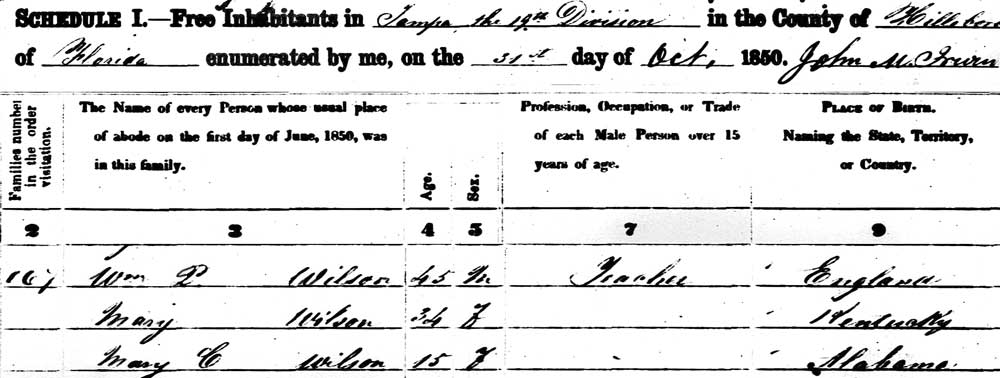
William P. Wilson was 45, occupation teacher, born
in England. His wife, Mary Wilson, was 34, born in
KY. Their daughter, Mary C. Wilson, was 15, born
in AL.
The courthouse
he would have used in 1848 was one built by Scotsman James McKay on the
property bounded by Franklin St, Lafayette (now
Kennedy Blvd.), Monroe St. (now Florida Ave.) and
Madison Street. This became known as "Court house
square" and the building referred to as the "McKay
courthouse." There are no known existing photos of this
courthouse. The
streets back then were no more than wide, sandy, cleared paths through the brush and palmetto scrub.
In
these years, the Hillsborough County Commission served
as the Board of Education until 1869. Unfortunately, shortly after
Wilson's school opened, instruction was halted by the
disastrous hurricane of Sept. 25, 1848 that destroyed
most of the buildings close to the bay.
Read about this hurricane at
The Final Battle for Fort Brooke and
This Old House - The Historic Stringer House
(in the process up being updated.)
|
|
|
THE FIRST TWO HILLSBOROUGH COUNTY COURTHOUSES
THE LOG CABIN COURTHOUSE
The first county
courthouse was built in Tampa largely by the efforts of
Judge Augustus Steele, soon after the County of
Hillsborough was organized
from Alachua and Monroe counties on January 25, 1834,
during the U.S. territorial period (1822–1845). The new county was named for
Wills Hill, the Earl of Hillsborough, who served as
British Secretary of State for the Colonies from 1768 to
1772.
That little log courthouse
was burned by the Indians at the outbreak of the Second
Seminole War (1835-1842). At that time, fewer than a thousand
people lived in Hillsborough County and cattlemen came
to the courthouse most often to complain about stolen
livestock. And, of course, judges and attorneys traveled
long distances by horseback or stagecoach to cover their
“circuit," a name still in use today.
THE "MCKAY" COURTHOUSE
When the first County Commissioners met in 1846, the
general topics were taxes, transportation, a new
courthouse and jail, and town development. The next
year, the Commissioners accepted the bid of Captain
James McKay to construct a courthouse, which
was 20 ft x 45 ft. at a cost to taxpayers of $1,358.
This is the courthouse most refer to as the "The McKay
Courthouse" or the "First courthouse"
although it was really the second one. No
photos have ever been found of this courthouse.
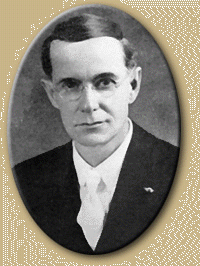 From
E. L. Robinson's History of Hillsborough County: From
E. L. Robinson's History of Hillsborough County:
This courthouse was completed and accepted
from James McKay on January 3, 1848 and his bill paid;
including ten dollars allowed for additional work.
This,
the "first court house" of Hillsborough County, was
erected on the block bounded by Lafayette, Franklin,
Madison and Florida (Monroe St. back then). The entrance was on the
south side and there was one large room for a court room
and two small rooms on the west side for offices and
jury rooms. The material for this building was brought
to Tampa from Mobile by Captain McKay who had come to
Tampa in 1846.
This building was soon
outgrown and no longer adequate for the increasing
business of the county. When a new building was ordered
this building was sold to John H. Redbrook** who moved it
to Franklin street. Later it was moved to the comer of
Zack street and Florida avenue and used as a store house
for the Peninsular Telephone Company.
**See correction to
this later, in the section on "WHERE DID THIS SCHOOL
MEET?"
|
|
About a year after the 1848
hurricane, Wilson was once again permitted to use
the courthouse for his school.
Nov. 20, 1849 -
Minutes of the County Commissioners meeting:
"Ordered
by the Board that W. P. Wilson be permitted to continue
his school in the courthouse (when not occupied for
public purposes,) until the first Monday in April, 1850,
which time the citizens of Tampa must furnish a
schoolhouse or be deprived of a school."
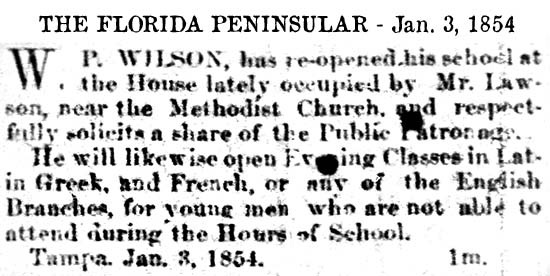 In
1854, Wilson reopened his school in Mr. Lawson's
house near the Methodist church. He also
offered evening classes in Latin, Greek and French,
or any of the English branches,, for young men not
able to attend during the normal hours. In
1854, Wilson reopened his school in Mr. Lawson's
house near the Methodist church. He also
offered evening classes in Latin, Greek and French,
or any of the English branches,, for young men not
able to attend during the normal hours.
Over the next
twenty years, small one-room schools sprung up around
the county in such remote areas as Safety Harbor,
Alafia, Plant City, and Socrum. W. P. Wilson's school program
was funded entirely by tuition fees. In this
sense, it was private. However, the County Commissioners
allowed Wilson to use the courthouse free of charge,
which constitutes the first use of public resources for
educational purposes.
|
|
THE FIRST REPORTED EXPENDITURES PROVIDED FOR
PUBLIC EDUCATION - 1853
Nov. 29, 1853
- From minutes of the County Commissioners meeting:
There were 560 children to be educated in the county for
which the State contributed $107.04. The
County Commissioners added $200 for a total of
$307.04 for the 1853-54 school year. This
worked out to 55 cents per pupil.
Assuming a public school can be any school
funded by the county, regardless of where it's
held,
then
the first public schools in Hillsborough County
were all located in public or private buildings
that had extra space available. All of the
limited funds were directed to teacher salaries
and expenses for operation. Although
Seminole War Gen. Jessie Carter constructed a
school building privately during this period,
the County Commission, and later, the Board of
Education, did not finance construction of a
building until 25 years later.
In 1853, Jasper K. Glover
opened a school known as the "Tampa Academy"
with 45 students on the first floor of the
Mason's Lodge at Franklin & Whiting streets.
Later, Emelia (?) Porter founded a private school
for girls in the same facility. According
to a legend, children from both programs
feared the goat that reportedly lived upstairs
in the Lodge room.
THE FIRST SUPERINTENDENT OF PUBLIC INSTRUCTION -
SIMON TURMAN, SR.
Prior to 1869, there was no official Board of
Education in Hillsborough County. The schools
were scattered throughout the county and were
under the supervision of the Board of County
Commissioners.
On Oct. 29, 1853, Simon Turman was appointed
duties of a superintendent of public
instruction, being the President of the County
Commission. In 1854, Mr. Turman earned $33
for his duties in overseeing the schools of
Hillsborough County.
|
WHO WAS SIMON TURMAN, SR?
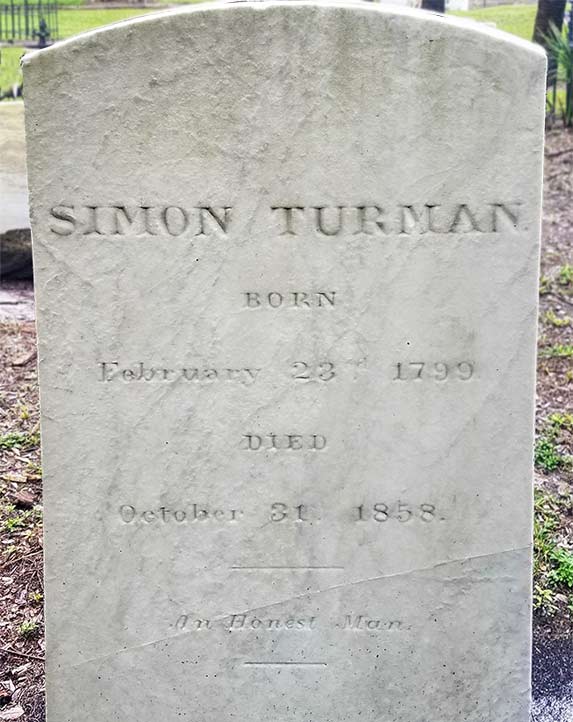 Simon Turman
Sr. was born Feb 23, 1799 in Champaign County,
Ohio. He was a son of Benjamin Turman, Jr.
(ca. 1762-1818) and Sarah Harbour (ca.
1762-1814). When he was a youth his
family moved to Indiana. In 1843 he promoted the
migration of a group of Ohio and Indiana
families,
including Ezekiel Glazier, Mortimer Bright, William Lockwood, and Asa J. Goddard,
to Florida. Coming first to New
Orleans, the colonists met John Jackson, a native
of Ireland, who was assistant city engineer of
New Orleans. They persuaded Jackson to join
them and chartered a sailing vessel to make the
journey. Arriving at Manatee Settlement in July, 1843, they
immediately filed applications for homesteads
along the Manatee river and were granted permits
in August. Turman built a house at the river, at
what later became known as Turman's Landing, and
was living there when elected Hillsborough County
commissioner in 1845. The commission hired
John Jackson in 1847 to survey the 140 acres set
aside by the Federal government as the county
seat, and lay out the streets of Tampa in 1848. Soon afterward, he and
Jackson moved to Tampa. Simon Turman
Sr. was born Feb 23, 1799 in Champaign County,
Ohio. He was a son of Benjamin Turman, Jr.
(ca. 1762-1818) and Sarah Harbour (ca.
1762-1814). When he was a youth his
family moved to Indiana. In 1843 he promoted the
migration of a group of Ohio and Indiana
families,
including Ezekiel Glazier, Mortimer Bright, William Lockwood, and Asa J. Goddard,
to Florida. Coming first to New
Orleans, the colonists met John Jackson, a native
of Ireland, who was assistant city engineer of
New Orleans. They persuaded Jackson to join
them and chartered a sailing vessel to make the
journey. Arriving at Manatee Settlement in July, 1843, they
immediately filed applications for homesteads
along the Manatee river and were granted permits
in August. Turman built a house at the river, at
what later became known as Turman's Landing, and
was living there when elected Hillsborough County
commissioner in 1845. The commission hired
John Jackson in 1847 to survey the 140 acres set
aside by the Federal government as the county
seat, and lay out the streets of Tampa in 1848. Soon afterward, he and
Jackson moved to Tampa.
Each built a Tampa home,
Turman at Lafayette and Ashley St. and Jackson
on lower Tampa Street where he built
and opened his general store.
Judge Turman and his wife, Abijah
Cushman Turman, had four children: Solon, born in 1825; Nancy
(Turman) Cunningham Haygood, born in 1826; Simon Turman,
Jr., born about 1829, and Mary, born October 81,
1843, at Turman's Landing on the Manatee River.
Judge Turman was
stricken with yellow fever during the 1858 epidemic and
died October 31. His widow Abijah died January 3, 1864.
They are buried in Tampa's first
city cemetery, Oaklawn.
Photo at right from Find-A-Grave
by
Jamay
|
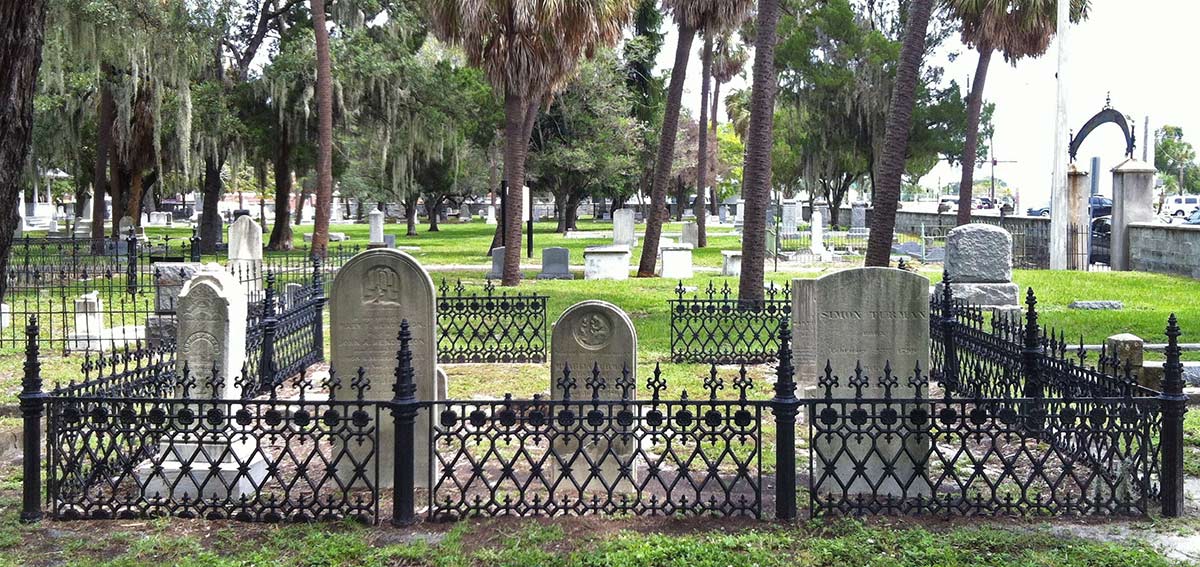
Photo from Find-A-Grave by
Vero DeSpirito
In 1854, the
County Commission approved schools to be placed
in the following ten districts. This was
only an approval, not all districts were able to
establish their schools, some would take years.
|
1.
Old Tampa (Safety Harbor) |
6. Itchepucksassa (Plant City) |
|
2.
Edward's school house
|
7. Soak Rum (Socrum, N. of
Lakeland) |
|
3.
Spanish Town (Hyde Park) |
8. Peas Creek (Ft. Meade-Peace
creek) |
|
4.
Three schools in Tampa proper |
9. Alafia |
|
5.
Sparkman (near Sydney--SW of Plant
City |
10.
Manatee |
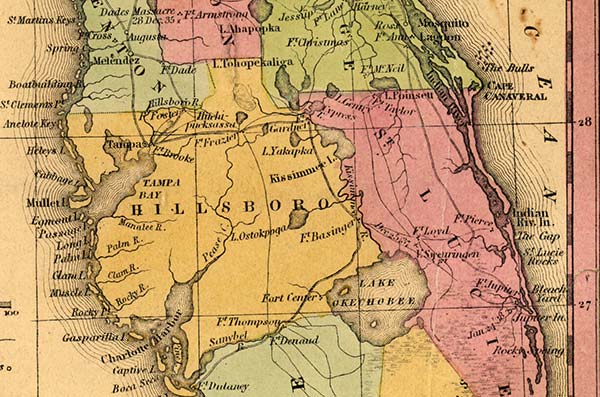
According
to Tampa historian Tony Pizzo, the County
Commission "boasted of three approved schools"
under its jurisdiction, each receiving $33 for
its term of operation. Due to the vast
size of Hillsborough County in the 1850s, the
Commission provided little supervision of the
schools.
Crop of Copperthwaite's Florida 1850 county map
from Florida Memory, State Library & Archives of
Florida
|
|
THE THIRD COUNTY
COURTHOUSE
A third county courthouse
was built in 1854 by John Breaker (sometimes referred to as
"the Breaker courthouse") at a cost of $5,000
and was used until 1891. Of course, it also had a
picket fence to keep the animals out of the courtyard.
Tampa historian
Tony Pizzo stated in his article "James McKay, the
Scottish Chief": In 1870, a visitor commented:
"The first building
to attract my attention was the courthouse, a frame
building set in a clearing in a big scrub. It had a
cupola or belfry, and was the first house I had ever
seen built of anything but logs."
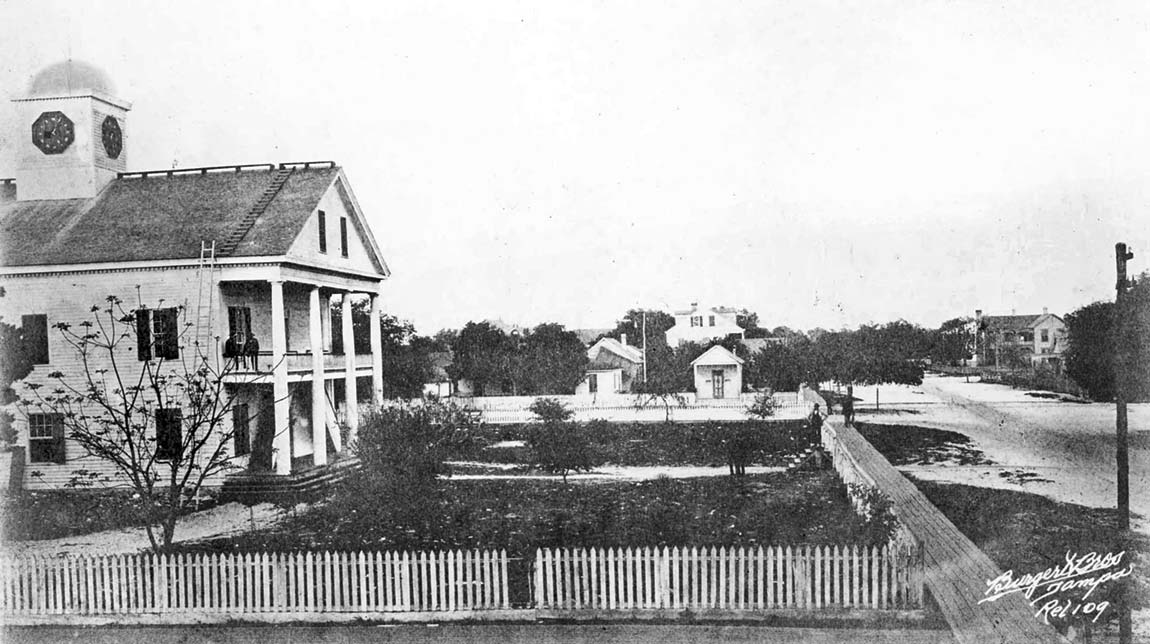
Hillsborough County Courthouse, Lafayette Street
entrance, looking east from intersection with
Franklin Street, 1886.
This is the courthouse that would have held school
classes during the late 1860s and 1870s for
Hillsborough County.
Burgert Brothers photo from University of South
Florida Digital Collection
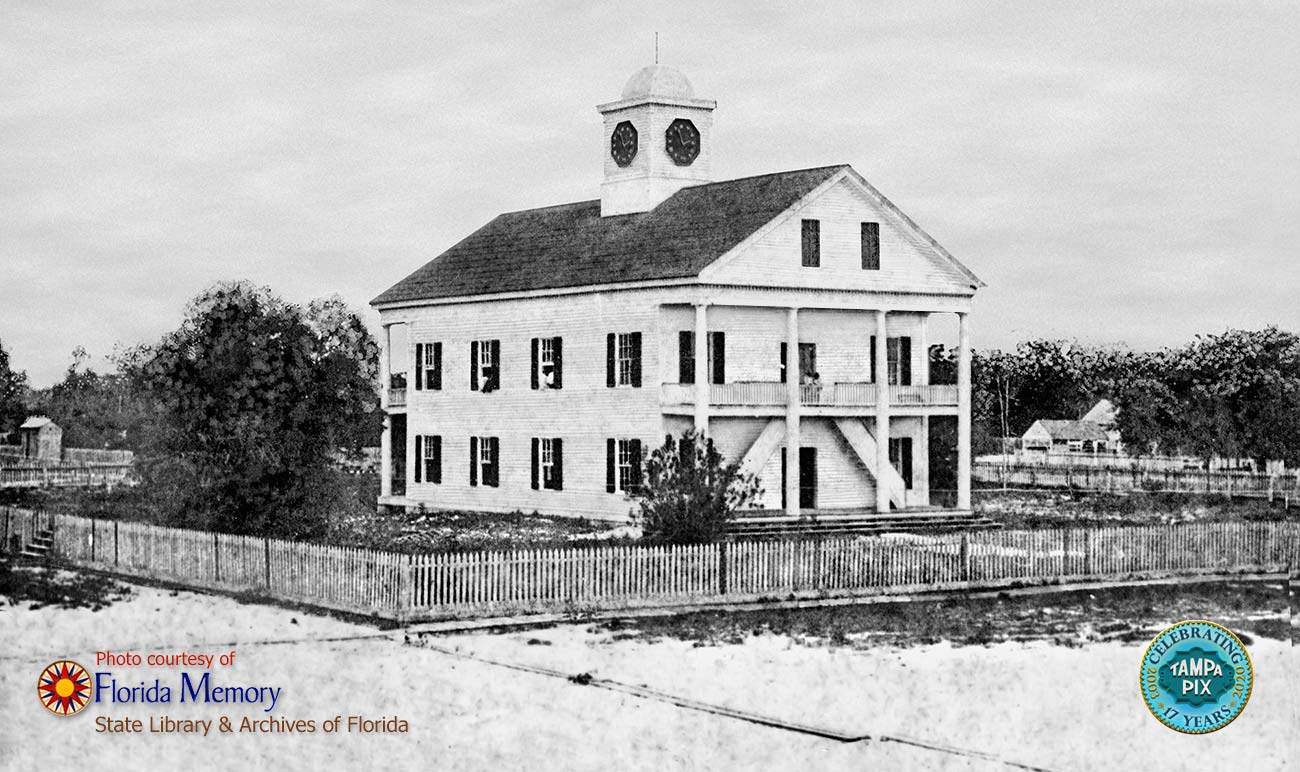
State
Archives of Florida
This view of the courthouse was
probably taken from 1882 to 1891
|
|
THE TAMPA HERALD -
WEDNESDAY, JUNE 7, 1854. |
Our Court House |
|
Through the kindness of
Mr. [John H.] Breaker, contractor and builder of
this magnificent Court House, we are enabled to furnish
our readers with a full description of its order, size,
various offices, etc. etc. The building is 76 ft. long,
by 45 wide, and two stories high. The 1st. story is 12
ft. between joints; the second is 14 1-2 ft. On the 1st
floor is the City Hall, Judge of Probates, Clerks’, and
Sheriff Offices, and Grand Jurors’ room. A spacious Hall
extends from the Southern entrance of the building,
between the four offices to the City Hall.
On the 2nd floor is the
Court Room, 42 by 45 ft., and two spacious Jury rooms,
with a passage extending from the south entrance,
between the jury rooms to the Court-room. A projecting
Portico, an each end, the whole width of the building
supported by heavy Grecian Columns.
|
|
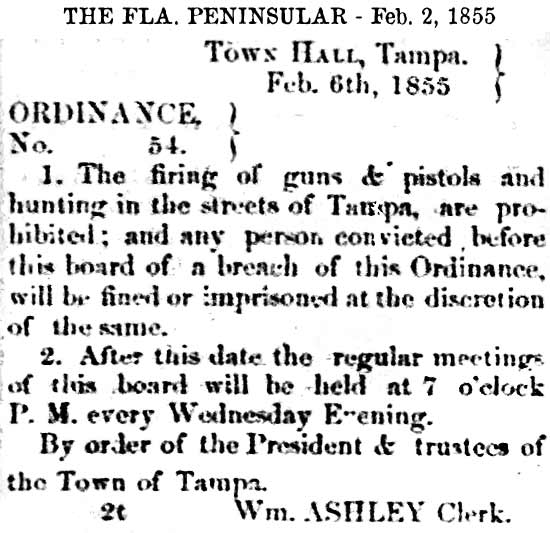 A double flight of
stairs ascends from each end of the building, landing -
on the 2nd floor of the porticos. The roof is mounted
with a dome and tower, 18 ft in diameter, and 24 ft
high, covered with tin, or zinc. A double flight of
stairs ascends from each end of the building, landing -
on the 2nd floor of the porticos. The roof is mounted
with a dome and tower, 18 ft in diameter, and 24 ft
high, covered with tin, or zinc.
The extreme height of
the building, from the pinnacle of the tower to the
ground is 68 feet; and the whole is being beautifully
finished in a combination of the Grecian, Ionic, and
Corinthian orders. The plan was drawn by the contractor,
Mr. Breaker, who has engaged to erect the building, for
a sum less than $5000. The execution of this contract,
we are satisfied, will be attended with considerable
loss to the builder, unless the generosity and
liberality of the County Commissioner’s shall interpose
to prevent it, for the credit of our Town and County, we
hope they will, and not in any stingy manner.
NOTICE THE ARTICLE
DESCRIBES THE ROOF-MOUNTED TOWER WITH DOME BUT DOESN'T
MENTION A CLOCK.
The clock was added in
1882 during a renovation.
Read about the purchase of this clock, and what happened
to it after the building was sold. No, not in
City Hall. You will be surprised.
Tampa had no City Hall
building, it had "Town Hall" which was located in this
courthouse.
This old courthouse
was sold and moved to Florida Ave between Polk & Cass St, then
converted into the Magnolia boarding house. The new brick courthouse
was built in its place in 1891
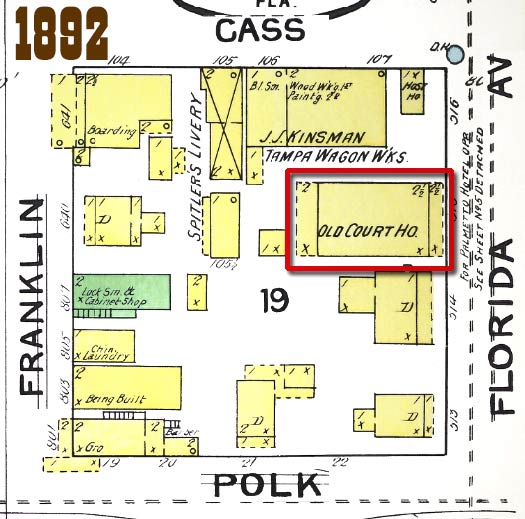
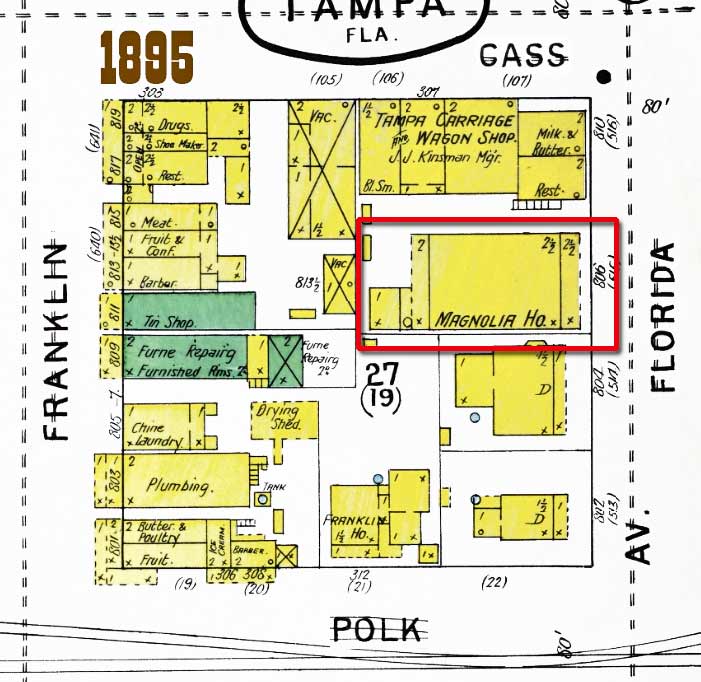 |
"The History of Hillsborough
County Public Schools" shows an image
(below, left) described as "Courthouse built in
1855" which is from Yesterday's Tampa
by Hampton Dunn. But the photo is actually
one of the old Palmetto Hotel at the
northeast corner of Florida Ave. and
Polk St.. Due to
the way the images were arranged
across the page spread in
Dunn's book, the authors of the
school history book misinterpreted
the image descriptions.
|
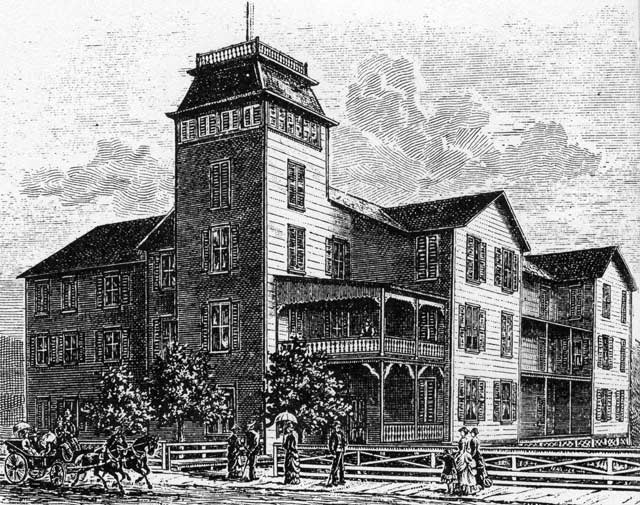 |
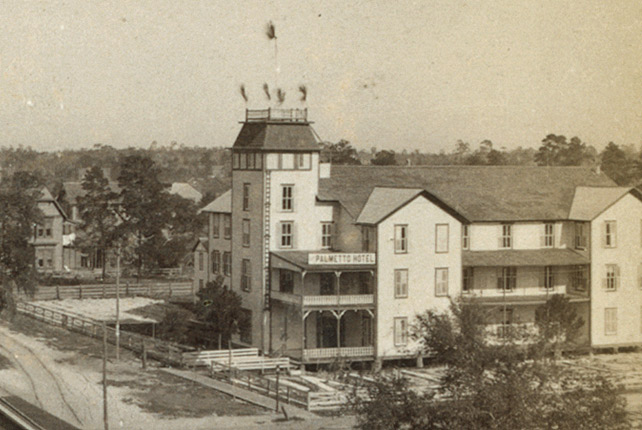 |
|
At
right is a
crop of a photo of the
Palmetto Hotel from the ROBERT N.
DENNIS COLLECTION OF
STEREOSCOPIC VIEWS (filtered
for Tampa) at The
New York Public
Library Digital
Collections.
See the whole picture. |
As it
did in 1848, the courthouse served
as the primary public school for the
students in Tampa. It is probable
that the students paid tuition as
they did at the courthouse before
the hurricane.
However, some historians viewed the
use of a public building for
educational purposes as "public
education."
1855 - THE STATE APPROPRIATES FUNDING FOR
SCHOOLS
Three schools offer a tuition-free four week term
In 1855 the state appropriated $239.71 to the
Hillsborough County Commission and the County
Commission added $160.29 for a total funding of
$400 for the 1854-55 school year. The funds were
divided among the schools with each school
receiving between $36 and $40. Districts
throughout the state were permitted to charge
tuition if their schools and teachers required
additional funds for salaries and operations.
This Jan. 20, 1855 article in the Tampa Herald
announced the funding of three schools by the
County from the public school fund. J.K.
Glover, James Petty, and W.P. Wilson offered a
4-week period of free schooling to children over
5 to under 18. The Herald hailed this as "the
first step in the practical commencement of the
Public School system..." and urged parents who
could not afford to pay for their child's
education not to delay in sending their children
to school now. Similar arrangements were
to be made in other parts of the County.
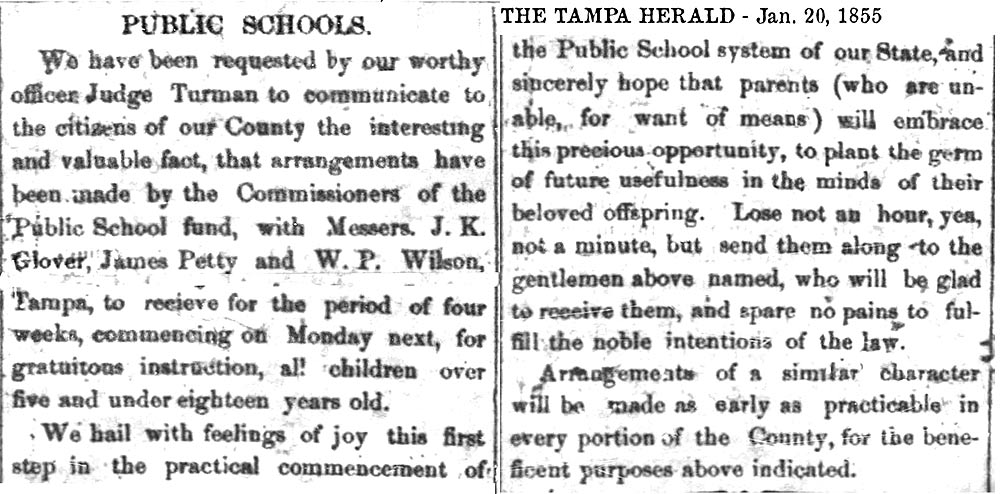
The four weeks
having expired, these 3 schools were back to
tuition-based funding.
THE PERIOD OF THE THIRD SEMINOLE
WAR,
1855 to 1858
Interest in public education
decreased during the third Seminole
Indian War. The county contributed
some funds to the schools during
these years, but state funding was
allowed to accumulate. Most
teachers' salaries and school
expenses were provided totally
through tuition. In other districts,
teachers received $53 per year from
public funds, but also received
compensation from tuition. In
addition to poor pay, teachers were
faced with severe social and
behavioral restrictions. Reports
stated that teachers were not
permitted to go out on school
nights, nor were they permitted to
dance or play cards. Due to the
minimal pay, many teachers boarded
with families in their communities,
which further restricted the social
lives of the teachers.
During
the 1850s, it was difficult to
locate qualified teachers for these
new schools. For the most part,
individuals qualified to teach if
they could read and do basic
arithmetic. However, there were a
few exceptions of quality teachers
with good credentials. Francis
C. Boggess was remembered as an
outstanding schoolmaster who taught
at Alafia, Fort Dade, and Fort
Meade. W.P. Wilson, the
Englishman who founded the 1848
school at the courthouse, became so
popular that he later opened a private
school of higher studies known as
the "Wilson Academy."
|
This
ad in early 1855 announced that Mary
Griffin had opened a school for
females with all the "ordinary
branches of an English educations."
She also offered courses in music,
if enough students enrolled, on the
piano-forte, which was the
predecessor to the modern day piano.
The school was located in a house
formerly occupied by Mr. Alexander. |
March
3, 1855 Job Wanted ad by two
graduates in
S. Carolina looking for teaching
positions. |
|
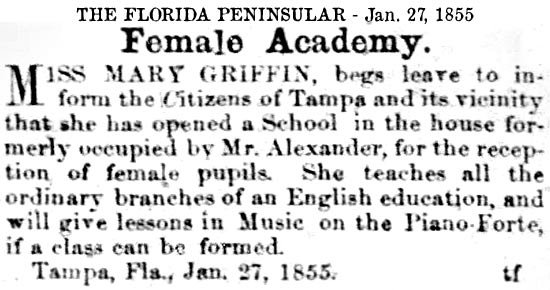
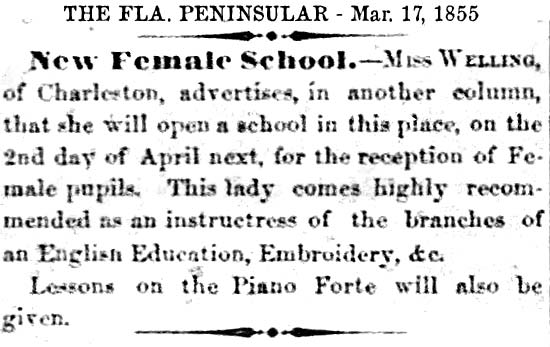
J. K.
Glover had another profession,
probably a
bit more lucrative than teaching,
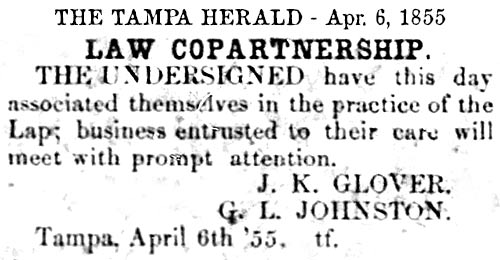
This
Jun. 30, 1855 ad by J.K. Glover
indicated that the Tampa Academy was
financed by tuition and was teaching
high school level courses--Grammar,
Geography, Philosophy, Algebra,
Chemistry, Ancient Geography and
Geometry. His was a 3-month
course--at least.
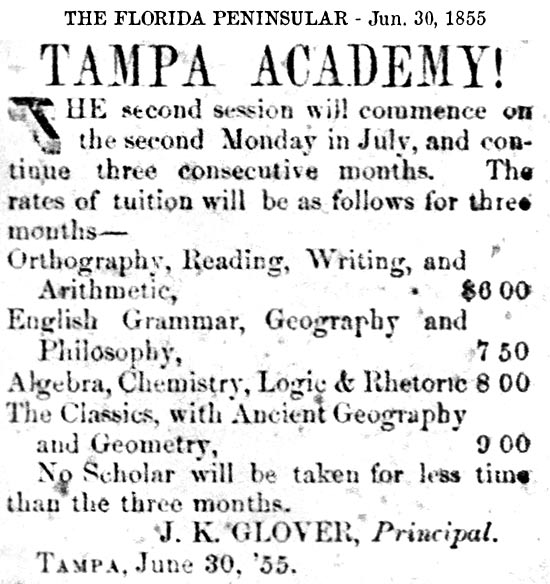
In
Sep.1857, Mary McAuley announced
that her "Tampa
School for Young Ladies" would
be held in the "Addition to Tampa
Lodge Building" starting Oct. 5.

Very
few ads for private schools were
published in 1857.
|
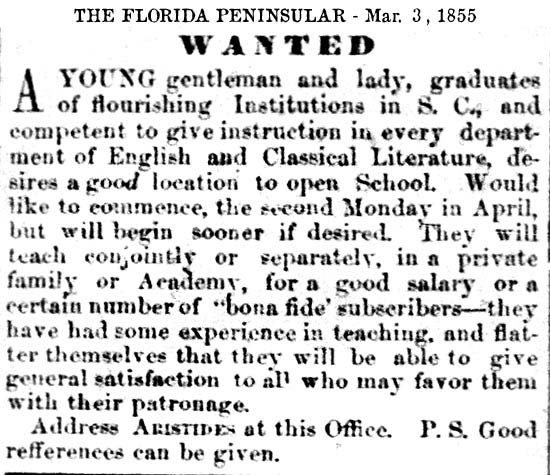
Anna
Welling opened her private school
for girls in Tampa in April 1855,
in the residence of Mr. T.C.
Andrews. She could be the
young lady looking for a teaching
job in the ad above.
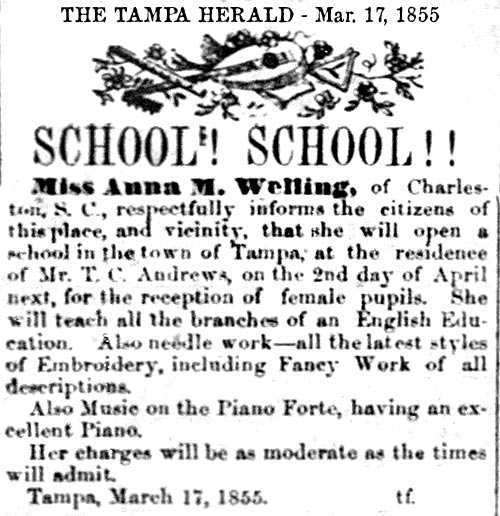
This W. P.
Wilson ad announced an 11-week term
would begin on Dec. 3, 1855 "at the
school house near the Methodist
Church."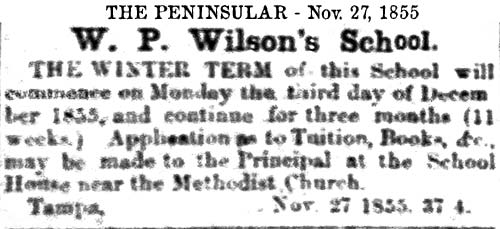
On
Jul. 19, 1856, a public meeting of the Tampa
Precinct for the "American Party" was held
in the courthouse. John Darling acted as
the Chair and Ed A. Clarke the Secretary. Their
purpose was to choose delegates for the County
Convention of the party, to be held in Tampa on
the first Monday in August, to nominate a
candidate for an Assemblyman, and to elect
delegates to the district convention of the
party, to be held at Desoto in Hernando Co on
the first Monday in September, the purpose of
that convention being to nominate a candidate
for Senator. J. K. Glover was among the
County delegates chosen.
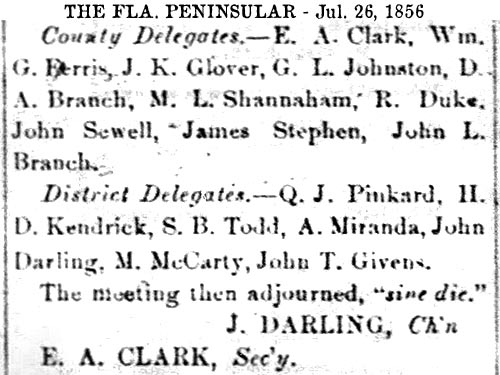 |
|
|
|
JESSIE CARTER'S SCHOOL FOR GIRLS - 1858
Seminole
wars Gen. Jesse Carter built a schoolhouse in early 1858 on the west bank of the
Hillsborough River.
It was located on
what would become the
grounds of the Tampa Bay
Hotel, now the
University of Tampa. Some writers cite a circa
1855 date or even as early as 1850, but the
wording in an 1858
newspaper ad for the
school implies a Feb.
1858 completion date.
JESSE
CARTER
On January
25, 1849
Tampa
elected five
trustees in
what is
considered
Tampa's
first City
Council,
with M .G .
Sikes
serving as
president of
the
governing
body. The
trustees
were Thomas
P . Kennedy,
Jesse
Carter, C .A
. Ramsey,
and William
Ross; James
Gettis,
first town
clerk.
A
Florida native,
Jesse Carter
resided where
the University
of Tampa is now
located. He
served as a
State Militia
Colonel and
General in the
2nd Seminole
Indian war, as
well as
Florida's
special agent on
Indian affairs
to Gov. Broome.
In 1853,
Tampans were
able for the
first time to
travel north by
stagecoach, a
line being
established then
by Jesse Carter
who got the
contract for
bringing in the
mail from the
nor them part of
the state.
Carter's line
ended at
Gainesville
where
connections were
made with other
lines running to
St. Augustine,
Jacksonville and
Tallahassee.
(Grismer,
History of
Tampa)
Carter served
repeatedly in
the legislature
in Alachua
County. In 1850
he joined other
Freemasons in
creating
Hillsborough
Lodge No. 25, F.
& A. M. Charter
members
included, among
others, James T.
Magbee, Joseph
Moore, Jesse
Carter and M. L.
Shannahan.
Carter also
operated a
boarding house.
An advocate for
transportation,
he was elected
in October 1854
as Hillsborough
County’s
Democratic
representative
in the General
Assembly. The
railroad issue
was preeminent
to Carter. Carter
served as a
ferryman for
ferry service
across the
Hillsborough
River. He also
worked to
establish
schools in
Tampa, and had a
key role in the
construction of
Tampa’s first
school building
in 1858.
(Info from The
City Council of
Tampa, etc)
|
The beautiful
photo of the school below is from the
Historical Marker Database website.
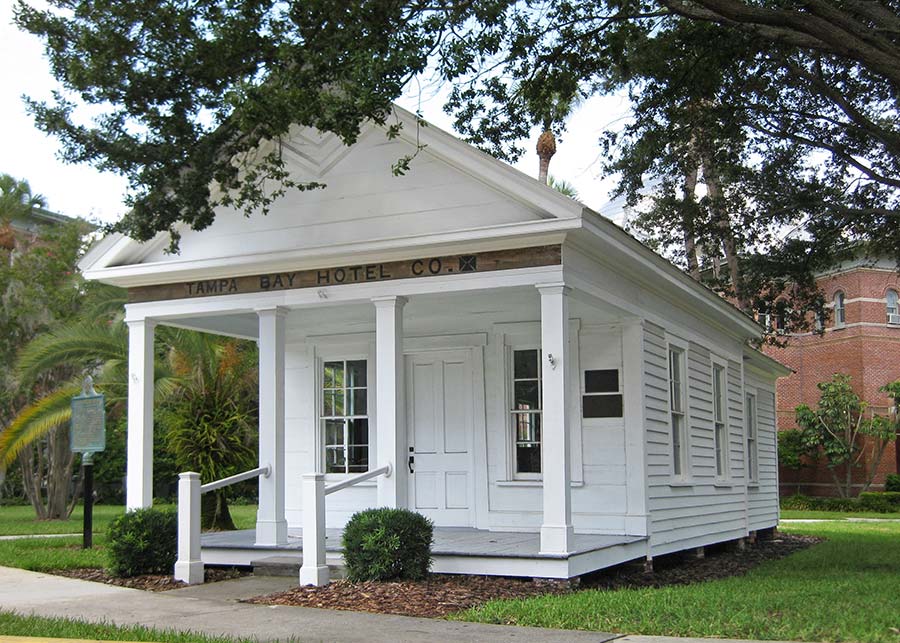
Photographer: AGS Media Taken: July 31, 2010
Caption: Old Schoolhouse and Marker. Submitted:
August 2, 2010, by Glenn Sheffield of Tampa,
Florida Photo from the
Historical Marker Database website
|
JESSE CARTER'S SCHOOL FOR GIRLS AND
TEACHER
LOUISA PORTER
The
History of Hillsborough Co. Schools
and the
historical marker placed at the
school, state
that
General Carter built the school because he
intended to provide an education for his
daughter, Josephine.
To do this, he paid
for the construction
of a small, one-room
schoolhouse and
hired Mrs. Louisa
Porter, a teacher
from Key West.
Although this school
could be classified
as a "private
school," General
Carter opened the
school to the public
free of charge.
READ MORE ABOUT CARTER'S SCHOOL AND
ITS TEACHERS:
This breakout page contains quite a
bit of interesting history
surrounding this school, Jessie
Carter, Louisa Porter, and Ossian
Hart (the 10th governor of Florida,)
as well as Tampa's first mayor,
Joseph B. Lancaster.
More photos of this school and
the historical marker.
Don't miss it!
DID LOUISA PORTER REALLY TEACH HERE?
|
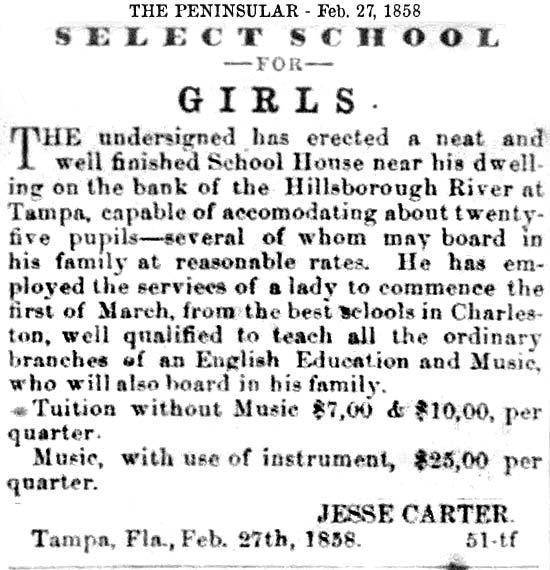 |
|
SCHOOLS SCATTERED AROUND THE COUNTY, MEETING IN
PRIVATE HOMES OR BUILDINGS
Throughout this
period, population directly determined the need
for public school in the most rural areas of the
county. In the early 1860s, it was estimated
that there were only 867 "schoolable children"
throughout the county. It was required that an
area had at least 10 children of school age
before a school could officially be sanctioned
in that area.
The County Commission did not own
any school buildings specifically designed for
instruction. All buildings used for
schools were owned and constructed by private
citizens to serve as schools in their
neighborhoods. Although the schools were
private, most were open to other children in the
immediate area who wanted to attend. Some of the
earliest construction of one-room schools
originated in areas of present-day eastern
Hillsborough County. Early pioneers in the Plant
City area such as George Hamilton, Elijah Byrd
Sparkman, and Joseph Casey were believed to have
opened schools as early as the late 1860s. Both
Sparkman and Casey later petitioned the Board of
Education and were sanctioned as schools #5 and
#7 respectively. As in Tampa, some early rural
schools were also held in churches or other
public buildings such as churches.
|
|
|
|
This ad
below
for a boys school at "Mr. Petty's
School House" was offered by W. P.
Wilson. His school had primary
level classes as well as higher
classes for English, Greek, Latin,
French, and a business course in
stenography.
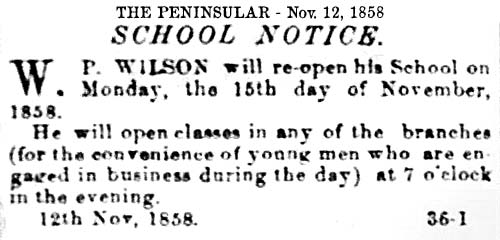
Six months afer Miss
McAulay started a school
in Mr. McNabb's house,
it appears that Mr.
McNabb has passed on and
William T. Coons has
replaced her school
there, "assisted by a
competent Lady" (who
would probably have been
Miss McAulay.)
Perhaps Mr. McNabb was
assisting Mary and now
couldn't do it all on
her own.
But Mr. Coon's can't
guarantee the term will
be more than 3 months,
and the full amount of
tuition was expected at
the close of the term.
The only exception was
in cases of "protracted
sickness."
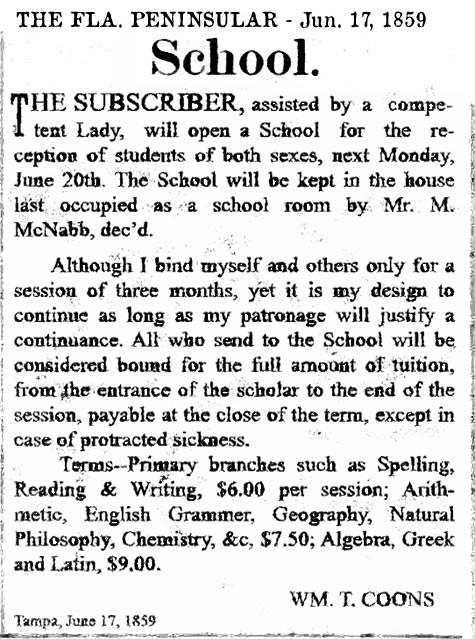
It is
never a good thing to
misspell "Grammar" in a
school ad.
Below, Wm. P. Wilson offers
a night school in his
home, for young
men.
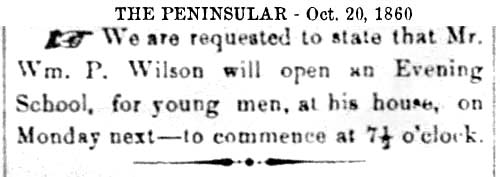
|
In this
ad, Miss Mary McAulay
announced the start of
her winter term for boys
and girls would begin
Jan. 3, 1859, "in the
Points House lately
occupied by Mr. McNabb"
She assured parents she
would "give her
undivided attention to
the intellectual
improvement of
pupils..." and
"watch, with parental
solicitude, their moral
deportment.
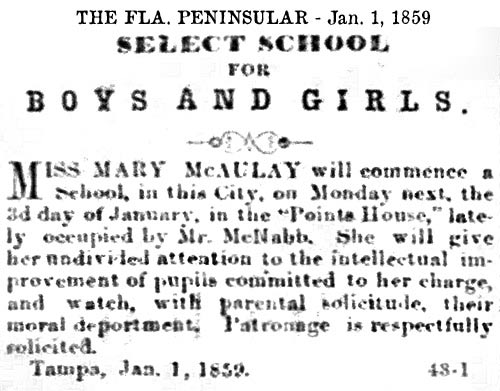
Wilson offered primary and high
school courses located in
Mrs. Petty's school house.
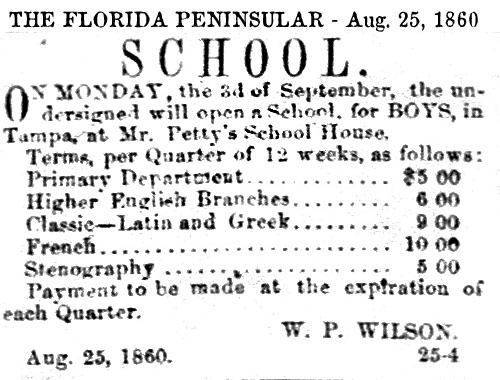
Wm. P. Wilson announced
the reopening of his
boys school for the
winter term, starting on
Jan. 7, 1861.

The legal notice below
is the last we hear of
Mr. Wilson in the Tampa
papers. Mary
Wilson was his wife,
according to his 1860
census record, and it
appears Mr. Wilson has
been made the
administrator of her
estate.
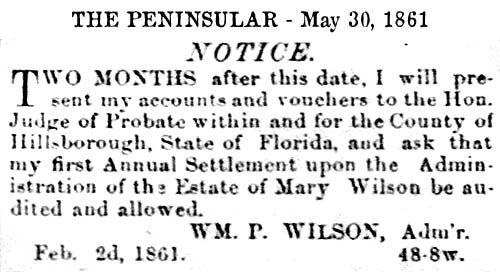
|
|
|
|
|
HAYDEN'S
FERRY CROSSING
Students living in Tampa
would have taken the
ferry to get to Carter's
school house.
1846: The
earliest
existing
records of
Hillsborough
Co.
Commissioner
meetings
History
of
Hillsborough
County,
Florida, Narrative
and
Biographical,
1928" by
Ernest L.
Robinson,
Director of
High Schools
of
Hillsborough
County,
Formerly
Principal
of Hillsborough
County High
School.
1846 -
Jan. 5: The
board
members, the
lost book of
1845, pay
and taxes
The first
meeting (for
which
records
still exist)
of the
Hillsborough
County
Commissioners
was held.
The board
consisted of
William
Hancock, M.C.
Brown,
Benjamin
Moody, Simon
Turman, and
James A.
Goff (not
present).
Simon Turman
was Judge of
Probate and
President of
the Board.
At this
meeting, a
small record
book of the
previous
year's
proceedings
was turned
over to the
board by
Manuel
Avilla,
former Clerk
of the
County
Court. This
book has
never been
found. Also
at this
meeting, pay
was
established
for the
board at $2
per day
while in
session.
The county
tax for 1846
was
established
at 50% of
the amount
assessed for
the State.
S.L.
Sparkman was
the tax
assessor and
John Parker
the tax
collector. |
|
1846 -
April 7:
Treasury
balance,
build a
courthouse
At this
meeting,
Thomas P.
Kennedy was
the
Treasurer of
the County
and reported
the balance
to be
$267.63. The
commissioners
were
appointed to
"superintend
the building
of a court
house and
other public
buildings in
the Village
of Tampa"
and
instructed
to "select
the spot of
ground for
the said
public
buildings,
make a plan
to start the
building and
finish them
as soon as
practicable
taking into
consideration
the funds on
hand..." |
|
1846 -
May 23:
Establish a
ferry, build
a road
At this
meeting,
Thomas Piper
was
granted "the
privilege of
establishing
a ferry
across the
Hillsborough
River at
Tampa." The
grant was to
last four
years and he
was to pay
five dollars
per year for
the last
three
years. The
ferry fees
were fixed
at five
cents per
man and
proportionately
higher for
vehicles. A
road was
authorized
to be
extended as
well. |
|
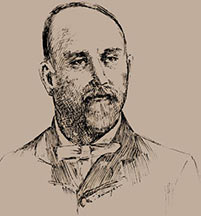
By James McKay, Jr. in "Reminiscences - History of Tampa in the Olden Days" Dec. 18, 1923
In 1852 we opened a ferry at the foot of Jackson street, so as to cross the stage with the mail. It was also used by the public. Ponds that were located on the east end of Jackson street caused the city officials as well as the people, considerable annoyance, especially during the rainy season. One of these ponds at the corner of Jackson and Marion street would take in all four corners and prevent pedestrians from passing in that direction. I have skated rocks over ice on this pond when it was frozen over during the winter.
The authorities dug a ditch in the center of Jackson street to drain these ponds, and in some places it was 12 feet deep. Across Franklin and Tampa streets small bridges were placed so as to permit passage of teams and the public. This did not accomplish what was desired so the ponds were filled in later on. |
|
|
|
READ ABOUT HAYDEN'S
FERRY AND WHO OPERATED
IT BEFORE AND AFTER
HAYDEN.
SEE actual PHOTOS TAKEN
FROM THE LOCATION OF
HAYDEN'S FERRY WHILE IT
WAS STILL IN OPERATION!
Here, at WHERE WAS
HAYDEN'S FERRY?
|
|
|
CIVIL WAR
On January 10, 1861, Florida became the third state
to secede from the Union ushering in the beginning
of the Civil War. During The Civil War years, there
was no mention of the schools in the records of the
County Commission. It is thought that most schools
closed during these years. Those that remained open
operated on a minimal budget with funds provided
completely through tuition. According to historian
Canter Brown, even W.P. Wilson had to plead with
parents for tuition payments.
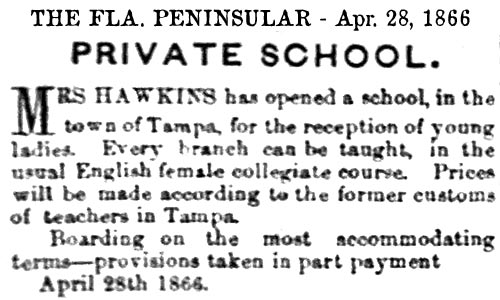
AFTER
THE WAR
Some
private schools
opened
within a year
after the war
ended, such as Mrs.
Hawkins' Private
School for Girls
and Samuel C.
Craft's Private
School for Boys.
Both Craft and
Mrs. Hawkins
charged tuition
fees of $8 per
term, when paid
in advance, and
$12 when paid in
installments.
SAM C.
CRAFT'S SCHOOL FOR BOYS |
|
In 1866 Samuel Craft returned to Tampa to open a
school at the Baptist Church initially known as the
"Select and Limited Male School." Craft had
conducted a school earlier in Tampa, but was forced
to relocate to Bartow in 1863 due to a controversy
over misuse of county funds. At one point during the
war, Craft was paid for his services in "bacon,
potatoes, sugar, syrup, and other commodities".
After the war, Craft had a definite effect on the
educational philosophy in regard to discipline
within the Tampa schools. His influence was greatly
magnified by the fact that, besides being the head
teacher of the school, Craft was also the editor of
the local newspaper, the Florida Peninsular. In
addition to arithmetic and English Grammar, Craft
focused on lessons geared to developing the
"character" of the child. Initially, his school was
well received and several dozen students were
enrolled. However, Craft's rigid and harsh methods
caused many students to drop out.
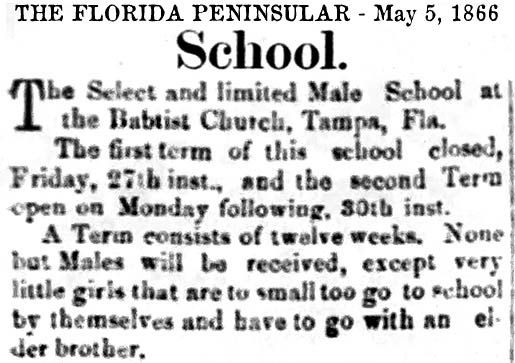 The
first term had already closed and the second term
was due to start next Monday, May 30th, when Sam
Craft placed an article in Tampa's Florida
Peninsular newspaper. Craft routinely placed
ads in the Peninsular concerning his school's
offerings, tuition and schedule. The
first term had already closed and the second term
was due to start next Monday, May 30th, when Sam
Craft placed an article in Tampa's Florida
Peninsular newspaper. Craft routinely placed
ads in the Peninsular concerning his school's
offerings, tuition and schedule.
His
school's terms were for 12 weeks and only for boys,
but with one exception--"very little girls that
are too small to go to school by themselves
and have to go with an older brother." Only
elementary classes would be taught, such as
spelling, reading, writing, arithmetic, English
grammar, geography, history, with emphasis on
arithmetic & grammar.
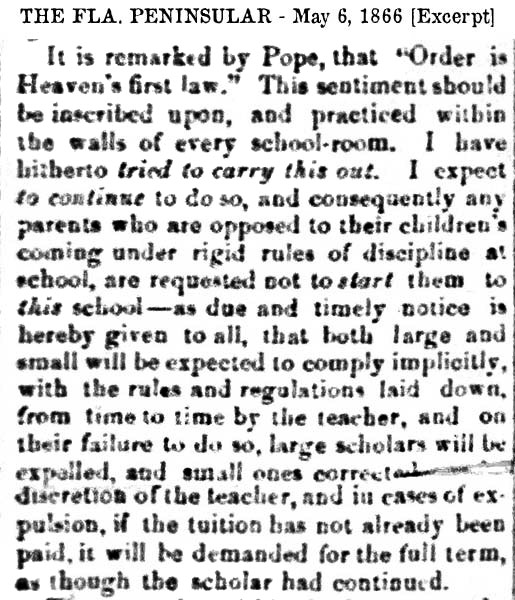
Craft had over 25
years of experience, with testimonials of success.
He believed that "Order is Heaven's first law."
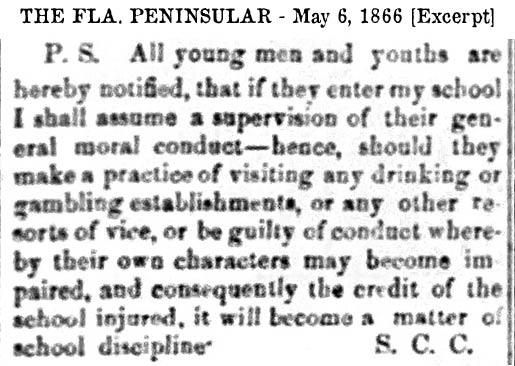 Craft laid down strict rules
regarding the conduct of the boys sent to him for
instruction.
There
would be no deduction of tuition for sick days
except in cases of protracted illness. He ends with
a specific warning: Entering this school puts Mr.
Craft in supervision of the students' moral conduct.
He warned that all those who
"make a practice of visiting any drinking or
gambling place or other resorts of vice would be
promptly expelled." Craft laid down strict rules
regarding the conduct of the boys sent to him for
instruction.
There
would be no deduction of tuition for sick days
except in cases of protracted illness. He ends with
a specific warning: Entering this school puts Mr.
Craft in supervision of the students' moral conduct.
He warned that all those who
"make a practice of visiting any drinking or
gambling place or other resorts of vice would be
promptly expelled."
See the whole article.
SAM CRAFT HAD THREE OCCUPATIONS
BUT NOT ENOUGH INCOME
Besides being proprietor of the school, Craft also
was pastor of the Baptist Church, editor of the
PENINSULAR newspaper. Despite this multiplicity of
jobs, he had a hard time making ends meet.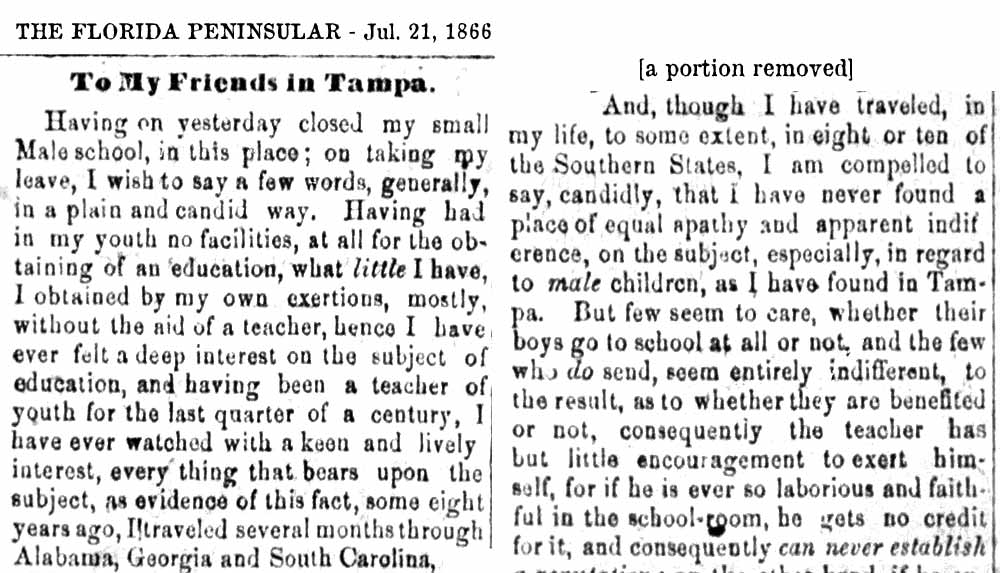
On July 21, 1866
Sam
Craft placed another lengthy article announcing the closure of his school due to lack of
income caused by lack of enrollment, which he in
turn
attributed to apathy.
"I have never found
a place equal of apathy and apparent indifference on
the subject...as I have found in Tampa. Few
seem to care whether their boys go to school or not,
and the few who do seem entirely indifferent..."
He reported that his income from
all sources for the first six months of the year had
been just $149. "That's not enough to live on," he
moaned, "particularly now that we have to pay l0
cents a pound for beef."
Craft's editorials in the Peninsular had an
impact for many years on the disciplinary practices
that existed in the district, especially in rural
schools. Craft's philosophy of strict order and
discipline was the cornerstone of many small smaller
schools for decades after Craft left Tampa.
Unfortunately, Craft's philosophy was sometimes
carried to extremes by overzealous educators. A
historian from Hernando County reported the
following disciplinary practices used in rural
schools in the late 1860's and 1870's: "The severity
occasionally reached draconian levels. Flogging was
an everyday occurrence as punishment for offenses of
all kinds. There was little regard for age or
sex in such punishment."
Craft did have some positive influence
on the development of schools. He was one of the
leaders of school reform and called for more
uniformity in textbooks and procedures in local
schools. In an editorial in his Florida Peninsular
on February 2, 1867, Craft wrote,
"Teachers are not alone, however, interested in this
enterprise. By adopting a uniform standard of school
books throughout our country, a vast amount would be
annually saved to parents.

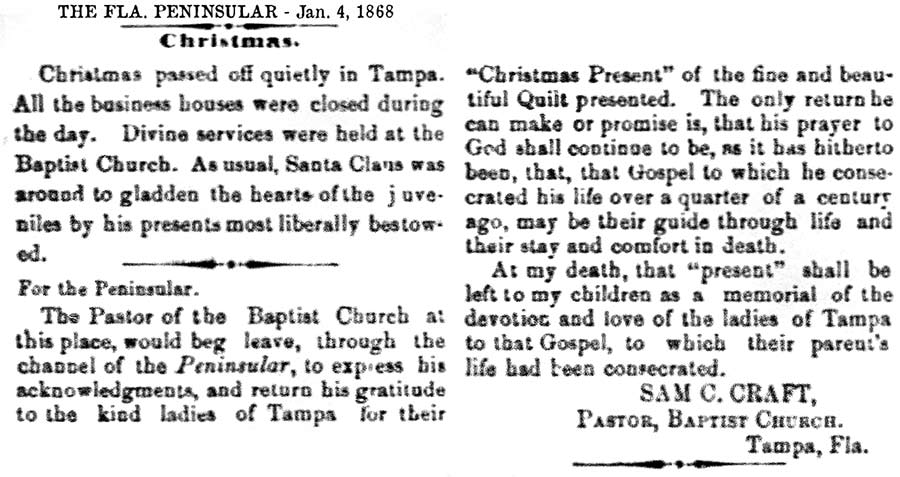
THE BEGINNINGS OF THE HILLSBOROUGH COUNTY BOARD OF INSTRUCTION
Dec. 3, 1866 - The first known report of school age
children by race and gender, minutes of the County
Commissioner's meeting.
Boys: White 251, colored 63
Girls: White 235, colored 51
In 1867 the federal government's
Freedmen's Bureau
agreed to erect a school for African Americans,
which was completed in 1871. Historian Canter Brown
described a visit to Tampa from Rev. Duncan, State
Superintendent of Colored Schools to plan for the
construction of the first "colored" school in Tampa.
Records indicate that this early school probably was
Tampa School #2. This school was replaced by a new
two story building known as the "Harlem Academy" in
1889.
|
Mrs. Glover's school opened the same day
Louisa Porter's school opened. The article stressed
the importance of sending their children to a good school
and supporting the schools regularly, and to "PAY THEIR
TUITION PROMPTLY. An education is the best legacy you can
leave them..."
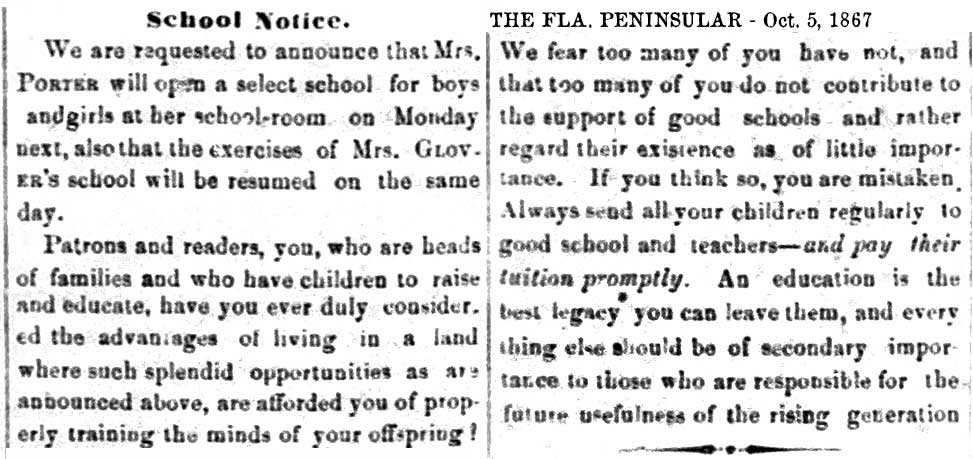
| |
|
|
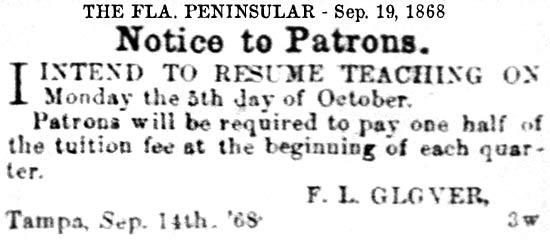 |
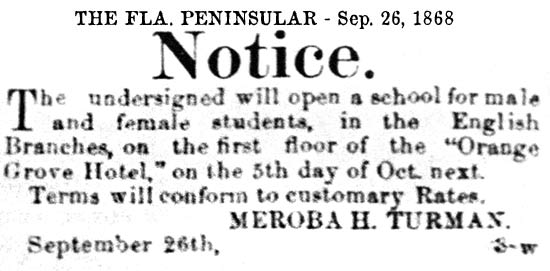 |
|
WHO WAS MRS. F.
L. GLOVER?
She was Frances Livonia (Branch)
Glover, b. 1835-36 in S. Carolina. She first
appears on the 1850 census of Tampa at age 14, a
daughter of Dr. Franklin Branch and his wife
Matilda. On Oct. 31, 1852 she married Jasper K.
Glover, lawyer and founder/teacher of the
private school Tampa Academy in 1853. His ads
for his school in the 1850s can be seen earlier in
this feature starting here.
See their marriage license. |
WHO WAS MEROBA
H. TURMAN?
She was Meroba H.
Hooker, b. c1843-44 in FL, one of several children
of Tampa cattle baron William B. Hooker and his wife
Mary. On Sep. 20, 1869, Meroba married Simon
Turman, Jr, early editor of the Fla. Peninsular and
son of Judge Simon Turman. Turman Jr. was
killed in the Civil War in 1864. Meroba then
married Judge Henry L. Crane, also editor of the
Peninsular. They also managed the Orange Grove
Hotel which was originally the Hooker's home built
by Wm. B. Hooker. See section on Henry Crane
below. |
|
|
|
|
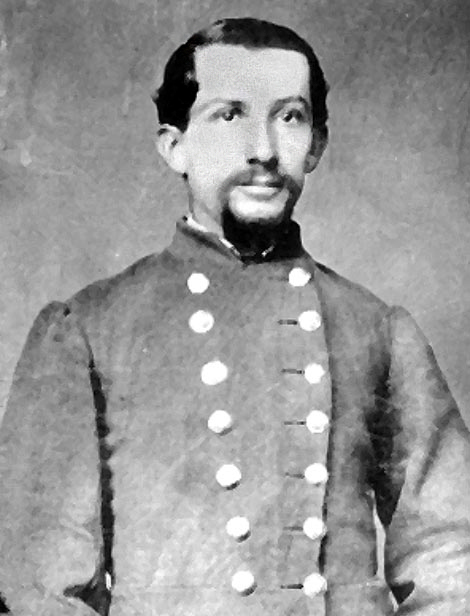 |
|
Simon Turman, Jr.
c.1855
Photo courtesy of
The Sunland Tribune, Volume XXII
November, 1996, Univ. of S. Fla.
Scholar Commons. |
Simon Turman Jr. (1829 –
May 22, 1864)
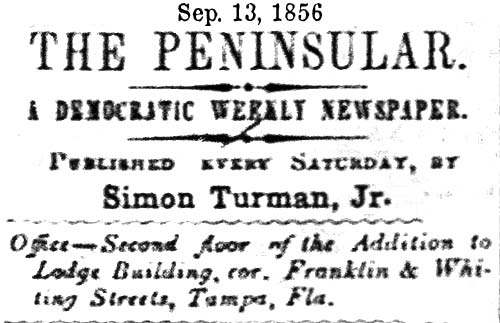 Simon Turman, Jr. was an early resident of Tampa,
coming as a young teen with his family from Indiana
to Florida in 1843, and to Tampa in 1845.
Simon Jr. was a
merchant and publisher/editor of the Tampa newspaper
"The Florida Peninsular" in the mid-1850s.
His father was a county probate judge and President
of the first Board of Hillsborough Co.
Commissioners.
On the
eve of the Civil War, Turman Jr. attended the
Florida Secession Convention as a representative of
Hillsborough County along with James Gettis; both
signed the Ordinance of Secession. Simon Turman, Jr. was an early resident of Tampa,
coming as a young teen with his family from Indiana
to Florida in 1843, and to Tampa in 1845.
Simon Jr. was a
merchant and publisher/editor of the Tampa newspaper
"The Florida Peninsular" in the mid-1850s.
His father was a county probate judge and President
of the first Board of Hillsborough Co.
Commissioners.
On the
eve of the Civil War, Turman Jr. attended the
Florida Secession Convention as a representative of
Hillsborough County along with James Gettis; both
signed the Ordinance of Secession.
On
May 14, 1862, Turman Jr. joined CSA Co. E, 7th Fla.
Infantry, a unit known as the South Florida
Bulldogs. He rose to the rank of first
lieutenant on Nov. 20, 1863 and was wounded in the
lungs at Resaca, Ga., May 14, 1864. He died
eight days later on May 22 and was buried in
Atlanta’s Oakland Cemetery.
|
|
READ THIS INTERESTING BIO ON MEROBA,
SHE IS FEATURED ON THE TAMPA RIVERWALK HISTORIC
MONUMENT TRAIL OF BRONZE BUSTS
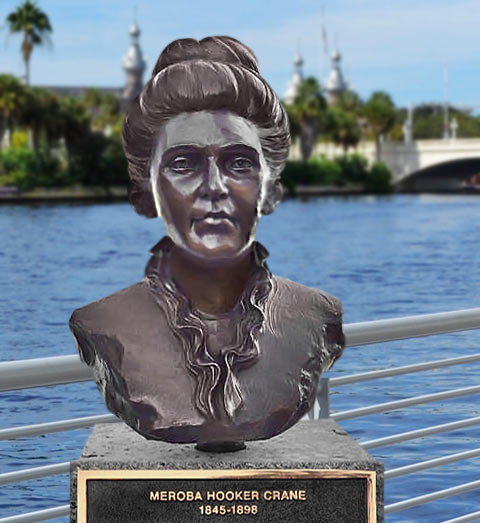 |
|
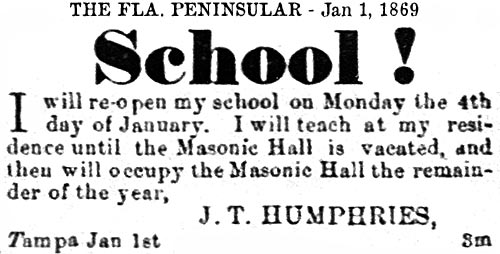
J.
T. Humphries had some impressive
course offerings, references, and
prices to match. But they were
for a whole year. However, as
far as having any degree in
education, it amounted to "having
had some experience as an
instructor..."
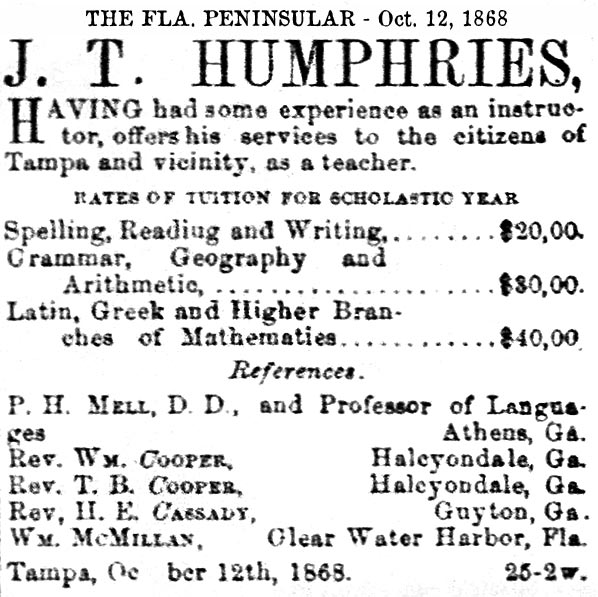
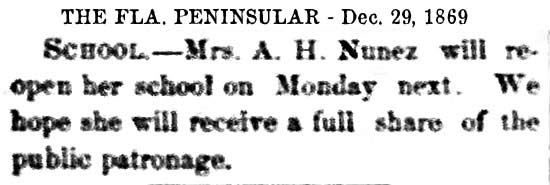
Mrs. Nunez was
popular enough to where she could
reopen her school the next Monday in
January of the new year. |
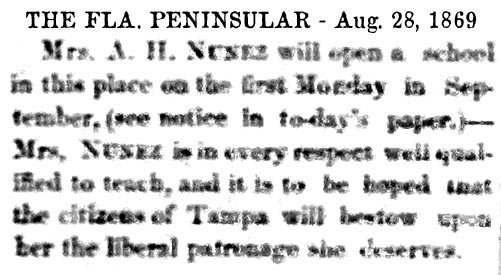
When
Mrs. A. H. Nunez decided to open a
school, the Peninsular added their
own
recommendation: "Mrs.
Nunez is in every respect well qualified to teach..."
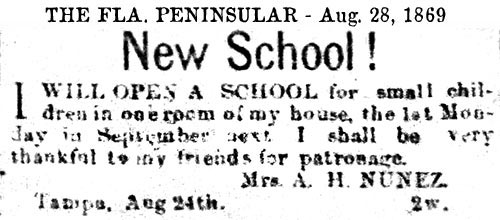
Mrs.
Nunez taught small children in one
room of her house.
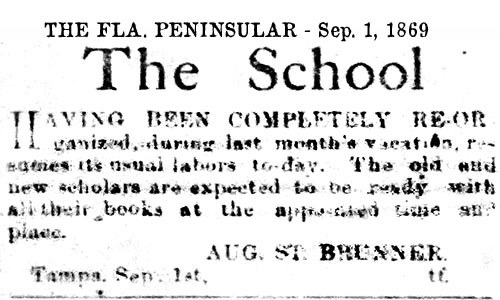
This Sep. 1, 1869
announcement by August Brunner
informs his scholars that "The
School" has been completely
reorganized during last month's
vacation. Old and new scholars
were to report with their books at
the "appointed time and place."
Apparently Mr. St.
Brunner felt that such details as
time and place were so well known he
didn't need to include that in his
ad.
No other reference
to Mr. St. Brunner's school can be
located in previous newspapers. |
|
|
THE STARTING OF THE HILLSBOROUGH CO. BOARD OF
PUBLIC INSTRUCTION & ITS FIRST SUPERINTENDENT,
ANSEL WATROUS
Prior to 1869, there was no official Board of
Education in Hillsborough County. The schools
were scattered throughout the county and were
under the supervision of the Board of County
Commissioners. Due to this, the first
on record
who assumed duties of a superintendent of public instruction
was Simon Turman in 1853,
being
the
President of the County Commission. In 1854, Mr.
Turman earned $33.00 for his duties in
overseeing the schools of Hillsborough County.
In 1868 the
Florida Assembly provided for a "unified system
of public education" to include:
-
All counties
to provide a public education for all
children in the county
-
A state
superintendent of education
-
Each county to
have a School Board and Superintendent
-
The
establishment of a state school fund
The following
year, additional state legislation mandated
"public instruction, open without charge, to all
youth in the state between the ages of six and
twenty-one." There was no requirement for
racial segregation in state legislation.
RELUCTANCE TO SERVE ON THE SCHOOL BOARD
With the new federal and state legislation of
1868 the first official local Boards of
Education were established in 1869 in the more
"progressive" counties including Hillsborough.
However, establishing a Board of Education was
not an easy task. Much of public opinion
at that time was in opposition to public schools
and education in general. Finally, after
several prominent community members refused to
serve as Board members, Hillsborough County
formed its first Board of Education under the
leadership of Ansel Watrous who
served as the Board's first superintendent and
chairman
in 1869.
But
the School Board of Hillsborough County did not
become a credible entity until late in 1871,
under the leadership of John Givens and William
F. White. Tampa was little more than a village
surrounded by smaller communities. The existence
of a local Board of Education provided a means
for small, one-room schools throughout the
county to become recognized as public schools.
In 1870 a school was operated with public
funds in the City Hall of Tampa (in the county
courthouse.**) It is believed that this school was
again referred to as Tampa School #l. Also
in 1870, the Florida Peninsular documented the
existence of School #3. The article stated:
"Pleasant Hill School will open in September for
10 months, two miles northeast of Tampa." Joseph Robles was a trustee of this school,
which later became "Nebraska Ave. School".
**This school was held in what was in the old
"McKay courthouse" which had been moved when the
newer "Breaker courthouse" was built in 1854.
See section later about "Where did this school
meet?" and Jackson S. Redbrook.
 Between 1868 and 1871, the Hillsborough County
Board of Education was in operation. Records and
minutes from these early Board meetings,
however, have never been located. It was
reported that the records from this period were
"removed" from the county by Ansel Watrous when he
moved out of Hillsborough County. Between 1868 and 1871, the Hillsborough County
Board of Education was in operation. Records and
minutes from these early Board meetings,
however, have never been located. It was
reported that the records from this period were
"removed" from the county by Ansel Watrous when he
moved out of Hillsborough County.
Two public schools
were reported in Tampa (#1 and #2). Their location was
not provided. Six schools were reported in
Hillsborough County. Later Board minutes
(September 26, 1876) identified Tampa School #2
as a "colored" school. This would
corroborate Canter Brown's report that the
Freedmen's Bureau assisted in erecting a school
in Tampa "for the colored people" sometime in
1870.
Despite the laws
passed mandating that counties provide public
education, state funding was grossly inadequate.
During this period, few of the residents of
Hillsborough County possessed enough assets to
generate a sufficient, local tax base necessary
to establish the system mandated by the
legislature.
|
WHO WAS ANSEL WATROUS? |
Ansel
Watrous Jr.
was a native New York. He served in the Union Army during the
Civil war, initially as a Private
and ultimately as a First Lieutenant
in the 137th Regiment of the New
York Infantry, Co. D under Capt. Redfields.
The family of our Ansel
Watrous Jr. was quite large. His father, Maj. Ansel Watrous (Sr.)
was one of 13 children. Ansel
Jr. was the youngest of at least nine children of Maj.
Ansel Watrous and his wife, Demis Luce.
Ansel
Watrous Jr.
came to Tampa between 1865 and 1868
with his wife and two young
children, first taking a position
with the
Federal Internal Revenue Department
as an
assistant assessor to Claiborne
Mobley.
In
1869, Watrous was appointed by
Republican Reconstruction Governor
Harrison Reed as Hillsborough
County's Superintendent of Public
Instruction. Despite his
Northern affiliations, it appears
that Watrous was well-respected in
Tampa. He served on various
committees such as a committee to
draft a constitution and bylaws of
Tampa's first hook & ladder
volunteer fire company., and one to
plan Tampa's Fourth of July
celebration in 1869.
Watrous was instrumental in
obtaining the first Peabody funds
which enabled the county to reduce
or eliminate (for a short time)
tuition fees for the earliest
schools sparsely scattered around
the county.
Learn more about the life of Ansel
Watrous, before, during, and after
Tampa, at this breakout page:
WHO WAS ANSEL WATROUS?
This
page also gives some history of Gov.
Harrison Reed, and his controversial
appointment of Florida's first
African-American to serve as
secretary of state in Florida’s
cabinet, Jonathan C. Gibbs.
Reed also commissioned Gibbs as a
lieutenant colonel in the Florida
State Militia and Superintendent of
Public Instruction.
|
PEABODY FUNDING
One source of funding in the latter half of the
1800s was the Peabody Educational Fund
established privately by northern financier
George Peabody, but this only provided a small
proportion of the necessary funding.
Consequently, by 1871, the Board of Education
still had not purchased any building or property
or property for school construction. Education
continued to be provided in churches, public
buildings, rented buildings, and private homes.
In contrast to Hillsborough, Polk County was one
of the richest counties in the state due to
lucrative cattle trade. Despite their resources,
Polk's educational system remained private for
the most part. |
| |
|
THE PEABODY
EDUCATION FOUNDATION -
From Wikipedia
Founded of necessity due to damage caused largely by
the American Civil War, the Peabody Education Fund
was established by George Peabody in 1867 for the
purpose of promoting "intellectual, moral, and
industrial education in the most destitute portion
of the Southern States." The gift of foundation
consisted of securities to the value of $2,100,000,
of which $1,100,000 were in Mississippi State bonds,
afterward repudiated.
In 1869 an additional
$1,000,000 was given by Mr. Peabody, with $384,000
of Florida funds, also repudiated later. The main
purpose of the fund was to aid elementary education
by strengthening existing schools. Because it was
restricted from founding new schools, it did not
benefit freedmen in the South, as there were no
established schools for blacks. "The fund introduced
a new type of benefaction in that it was left
without restriction in the hands of the trustees to
administer. |
|
Power to close the
trust after thirty years was provided on condition
that two-thirds of the fund be distributed to
educational institutions in the Southern states.1
"The rules of the
Peabody Education Fund were strict, allowing for the
distribution of about $80,000 per year over a period
of thirty years. By the time of the termination of
the fund in 1898, about $2,500,000 had been
distributed. In 1875, the trustees of the Peabody
Education Fund founded the Peabody Normal School of
the South which promptly became the Peabody Normal
College (1875-1911). It was maintained in connection
with the University of Nashville and supported by
annual donations from the Peabody Education Fund. In
1910 the Peabody College for Teachers was organized.
Placed adjacent to Vanderbilt University, the
college opened its doors on June 14, 1914 for summer
school. In September 1915, four new buildings had
been completed at a cost of $750,000. About 1915,
the Peabody Education Fund ceased to exist.
See also
The Creation of the Peabody Education Fund
1L.
P. Ayres, Seven Great Foundations (New York, 1911)
|
|
THE
SOUTH FLORIDA MALE & FEMALE INSTITUTE - Oct. 19,
1870
The board of trustees of
the South Florida Male & Female Inst. private school consisted
of well-known and successful businessmen of the
community. The ad even advised that good boarding could
be obtained in the homes of private families at moderate
rates. (Back then, "South Florida" referred to the
entire peninsula portion of the state, excluding only
the panhandle portion.) You will read about W. P.
Haisley a little further down in this feature.
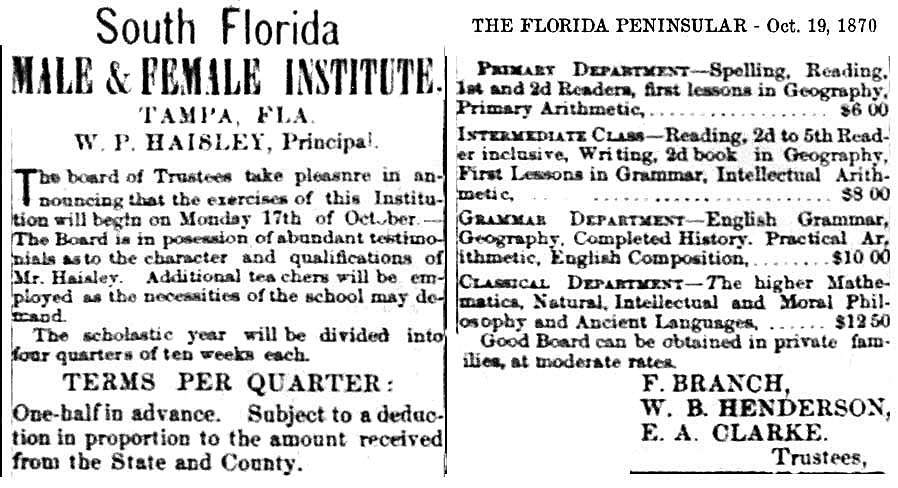
The same ad repeated Nov.
2, 1870 and every week through ---.
-
Dr. Franklin Branch (1802-1882) was early
druggist, SE corner of Florida and Washington, whose son
Harry was owner
of the Branch Opera House on Franklin St.; and son Dr. Darwin
Austen Branch was mayor from 1857 to 1858.
-
William Benton Henderson
(1839-1909), one of five children of Andrew
Hamilton Henderson who came to Hillsborough County in 1846. W.B was founder of an early store with Captain John
Miller, editor of the Florida Peninsular and developer
of Tampa Heights, Tampa's first suburb.
-
Edward Austin Clarke came to Tampa in 1853, was
married to a daughter of Dr. Franklin Branch, then
married to a daughter of Judge Perry G. Wall. Clarke was
first mayor of Tampa after the Civil War, a big investor
in real estate and was the Clarke in "Clarke & Knight"
hardware store until Perry Wall II turned 21 and took
his place as "Knight & Wall".
WILLIAM BENTON HENDERSON,
EIGHT-TIME TAMPA CITY COUNCILMAN
It was recognized in the county for many
years that two men could swing its
sentiment for a candidate and that their
approval was almost equal to election.
One was Col. Henderson.
Born on
September 17, 1839 in Jackson County,
Georgia, William B. Henderson came to
Tampa at the age of seven with his
parents in 1846. Alexander
Hamilton Henderson and Flora Olivia
McDonald arrived with their four young
boys, of which William was the
oldest. At the time, Tampa consisted of
the Fort Brooke military post and a
small trading station with a sparse
population of civilian settlers on the
north side of the post, most of whom
were merchants supplying the fort
personnel. In Tampa, Alexander H.
and Olivia had one more son, Wesley P.
Henderson, in 1848.
|
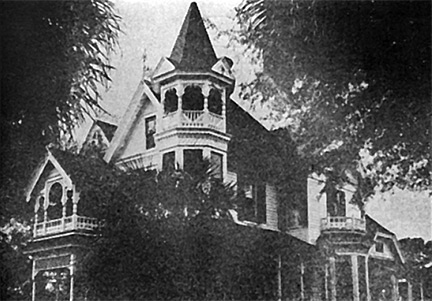 |
|
Henderson's home in Tampa
Heights on 7th Ave, in 1902
|
W.B.
didn't have the advantage of an early
school training. His father died in
1852, so being the eldest child of a
large family, he assumed the
responsibilities of self-support and of
making his own way at the early age of
twelve years. He took a job in
Kennedy & Darling's general store to
help support his mother and his four
younger brothers.
W.B became
a successful and well-respected
merchant, cattleman, civic leader, real
estate developer, and was the "father"
of Tampa Heights.
Upon
his death, it was said:
|
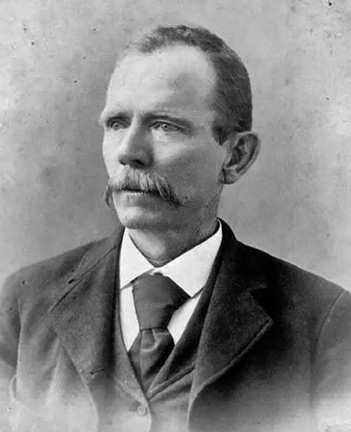
William Benton Henderson, 1891
Photo from Florida Memory,
State Library & Archives of Florida |
|
No man can write the history of Tampa or
of South Florida and leave his name out;
and it is equally true that the
biography of W. B. Henderson cannot be
truthfully written without writing a
large part of the history of the growth
and development of Tampa and of South
Florida."
Read about the amazing success of W.B.
Henderson and how he shaped the future
of Tampa, here at this breakout page.
Also on this page is a biographical
descendants list for Alexander & Flora
Henderson, |
|
|

THE "TAMPA SCHOOL"
The Tampa
School was a reference to Haisley's male & female
school; the terms were used interchangeably in the
newspaper. By Feb. 1871, this school had 55 pupils.

The
articles were a reference to the same school, the
South Florida Male & Female Institute. Their ad
below was the same one they ran in the previous year,
and it ran all year long in 1871, each week, even past
the Oct. 17 opening date. No articles could be found
about the progress of the school after opening, due to
the loss of newspapers from 1872 through 1876. The tuition per quarter was subject to a
deduction proportional to the funding it received from
the county and state school boards.
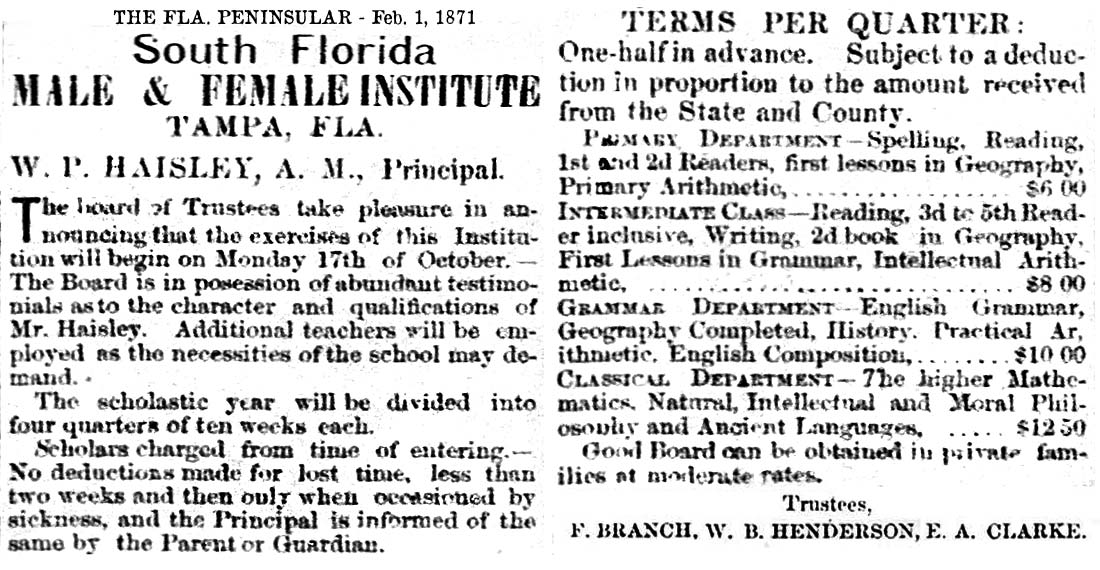
This school had the most
complete curriculum, especially for the intermediate and
higher level courses, but it was far from being a public
school, as the state and county funding would have been
minimal at best.
This school was the
most consistent over a period of several years in the
1870s, advertising in just about every weekly
issue of the Florida Peninsular.
|
|
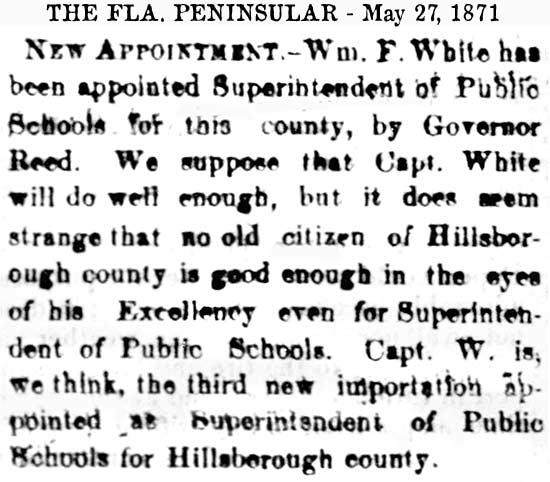 W.
F. WHITE SUCCEEDS A. WATROUS AS SUPERINTENDENT
OF PUBLIC INSTRUCTION IN 1871 W.
F. WHITE SUCCEEDS A. WATROUS AS SUPERINTENDENT
OF PUBLIC INSTRUCTION IN 1871
In 1871, William F. White was appointed to the
position of Hillsborough County schools
superintendent by Florida's Governor Reed.
It appears that
White was either a young man, or not a resident
of the county for very long, as the Peninsular
questioned the appointment by stating,
"...but
it does seem strange that no old citizen of
Hillsborough County is good enough in the
eyes of his Excellency** even for
Superintendent of Public Schools.
Capt. W(hite) is, we think, the third new
importation appointed as Superintendent of
Public Schools..."
**This is sarcasm by the
Peninsular. Reed was a Reconstruction
Republican governor, Tampa was a fervently
Confederate Democrat town, and the Peninsular
took every opportunity criticize Reed, who had
previously appointed Ansel Watrous.
READ MORE ABOUT WILLIAM F. WHITE AT THIS
BREAKOUT PAGE:
WHO WAS
WILLIAM F. WHITE?
|
|
THE
SCHOOL BOARD FORMS A COMMITTEE TO ESTABLISH
QUALIFICATIONS FOR TEACHERS
The first available minutes to exist from school board
meetings was one from Aug. 28, 1871. Continuous
records exist of the Board of Education's meetings, took
place in the county courthouse on Dec. 10, 1871, at
which time the Board recognized that a teacher must have
some sort of qualifications other than a willingness to
teach. The Board, consisting of Chairman
John T. Givens, T. K. Spencer , Dr. F. Branch, and W. F.
White, Superintendent and Secretary, appointed a
committee to examine and to "certificate" teachers.
SUPT. WHITE
REPORTS ON THE DEC. 10TH COUNTY SCHOOL BOARD MEETING
Male & Female Academy becomes Tampa School No. 1 with
change in one trustee
This
article in the Dec. 23, 1871 Fla. Peninsular published
the results of a Dec. 10th meeting as provided by W.
F. White, the county schools superintendent. Nine
schools and their trustees were approved, including
Tampa School No. 1 with Trustees E. A. Clarke, W. B.
Henderson, and D. I. Craft. These were the same
trustees as the Tampa Male & Female Institute except for
D. Isaac Craft in place of Dr. Franklin Branch.
The Board
decided to meet on the first of each month so that
teachers could be examined and trustees appointed.
Those who wanted a school in their neighborhood were to
submit the names of the trustees and teachers to the
Board for approval and examination. Supt. White
assured the public that the school funds had NOT been
expended in the Tampa Schools and would be distributed
among all nine schools. He was expecting the
funding for the next school term would be enough for at
least three months of free school in every neighborhood
of the county, as soon after Jan 1 as possible.
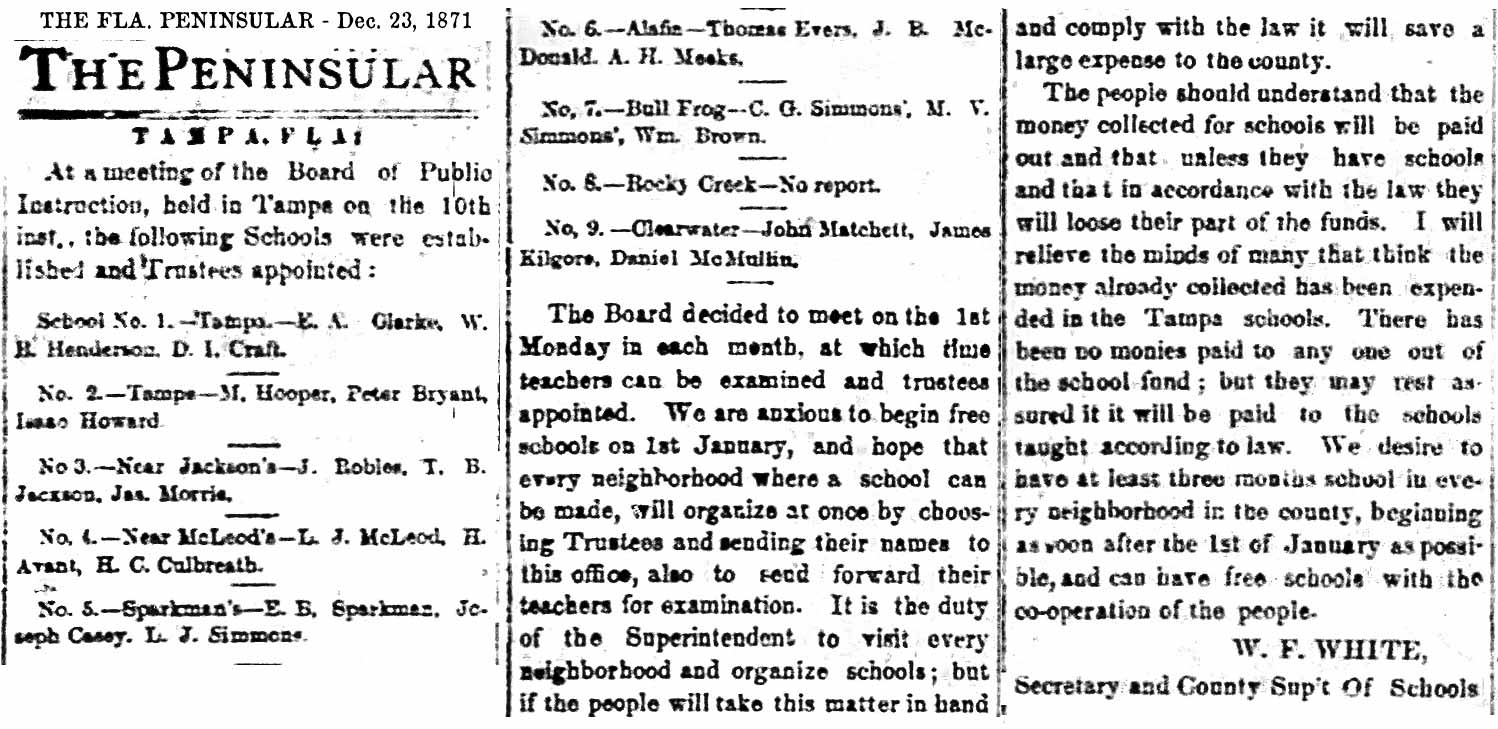 |
|
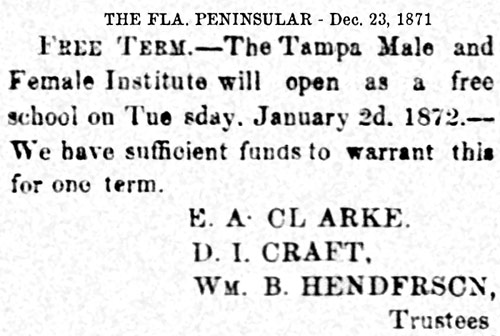
Franklin
Branch had probably resigned as Trustee and was replaced by D. Isaac Craft
as it became Tampa School No.1, maybe due to
Branch being appointed to
the School
Board.
In the next years of the 1870s into 1880, it is this
school that would grow in attendance and County funding,
and finally, move into a building specifically built and
paid for by the county and becoming Tampa's first graded
public school.
On the same page as the
above notice, the Tampa Male & Female Institute
announced that it was being funded enough to offer one
term for no charge, starting on Jan 2, 1872. This
was a reference to funding by the County and possibly by
the Peabody Fund.
|
WHERE DID THIS SCHOOL
MEET?
|
| |
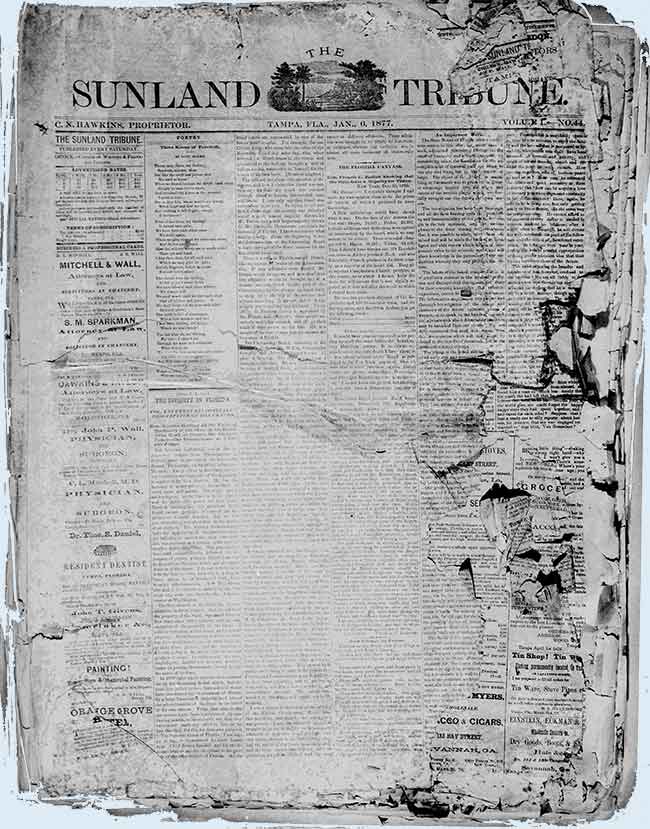 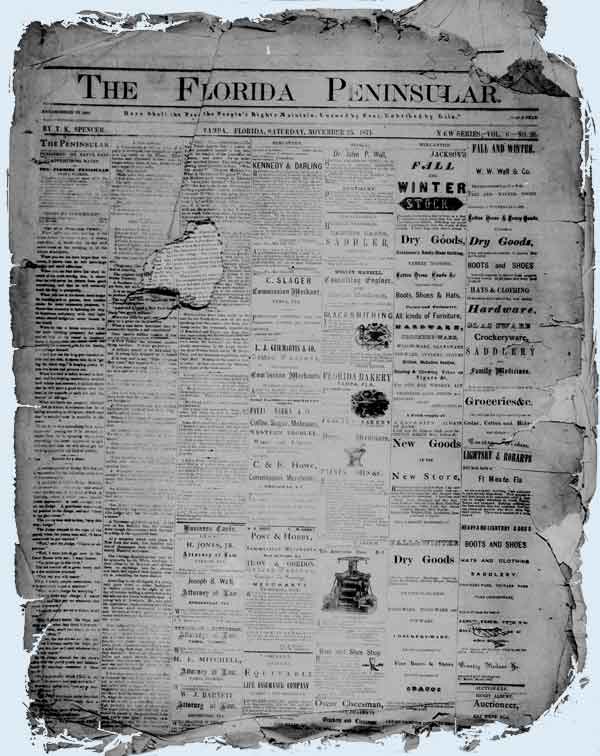 THE
GAP IN TAMPA NEWS HISTORY THE
GAP IN TAMPA NEWS HISTORY
There are no Tampa newspapers
online for 1872 through 1876. The
issues of the Fla. Peninsular leading
up the gap starting 1872 are in extremely
damaged condition. With the resumption of
newspapers in Jan. 1877 as Sunland Tribunes,
those too are extremely damaged for the
first few months.
These were the beginning years of a
well-organized school system, including the
construction of the first public school
building. But all the news of it has
be lost with the destruction of the
newspapers, leaving only the county school
board minutes. |
| |
TEACHER
QUALIFICATIONS AND FUNDING
During the 1870s, there were very few qualified teachers
throughout Florida. However, there is evidence that
there was some form of teacher certification at that
time. During a Board meeting in 1873, a Hillsborough
County teacher's certificate was revoked for cause. The
actual number of "certified" teachers in the district at
the time is unknown.
On
Jan. 6, 1872, the Board of Education passed its first
school tax of 5 mils. At this time, school taxes
were used only for the operation of schools. The primary
cost of operation was the meager salaries earned by
teachers and administrators. Communities typically paid
most of the cost of constructing their schools and
parents supplied most of the school materials for their
children.
The practice of charging tuition was still
permitted in most public schools and many did this to
supplement the limited funds they received from the
Board of Education. Taxing for the purpose of school
construction was still prohibited by law.
In
1872, schools were funded based on their enrollment. Although the minutes do not provide names, their
attendance and appropriations were reported as follows:
Tampa School #1 housed 147 students and received $331.74.
Tampa School #2 housed 39 students and received
$91.11.
School #4 (possibly Grange Hall) housed 12
students and received $28.00.
School #7 (Joseph Casey's
School) housed 31 students and received $72.44.
The
per pupil allocation in this early record is
interesting. Tampa School #I was allocated $2.26 per
pupil, while Tampa School #2 was allocated $2.37 per
pupil. The rural schools also received a higher per
pupil allocations.
|
|
|
MISS VERDIER'S SCHOOL |
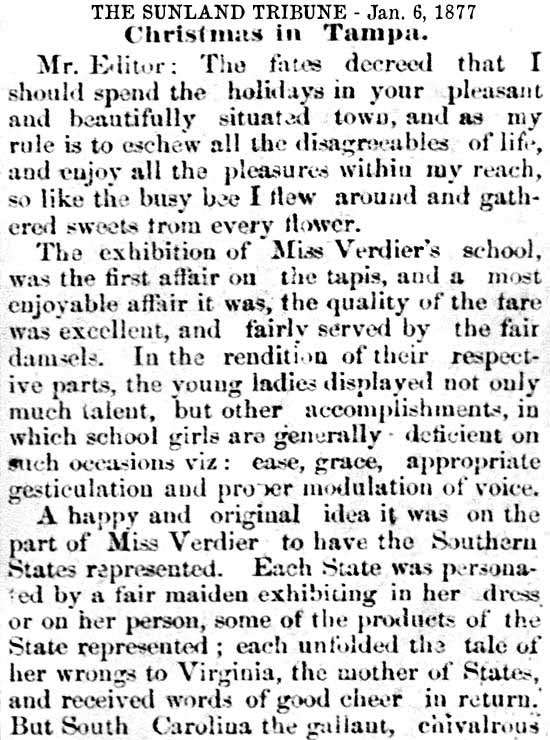
|
|
On Jan. 1,
1877, the Sunland Tribune published this
letter (at right) to its Editor from a
visitor to Tampa on the past Christmas.
The visitor, who only identifies themselves
as "VIATOR" relates various experiences of
their visit during the holidays, "Like a
busy bee I flew around and gathered the
sweets from every flower."
A large
portion of the letter is devoted to their
visit at Miss Verdier's school, apparently a
girls school, where the "young ladies
displayed not only much talent, but other
accomplishments in which school girls are
generally deficient...ease, grace,
appropriate gesticulation and proper
modulation of voice." The event
was apparently a play or skit. "A
happy and original idea it was on the part
of Miss Verdier to have the Southern States
represented. Each State was
personified by a fair maiden exhibiting in
her dress, or on her person, some of the
products of the State represented..."
So who was
Miss Verdier?
See this
breakout page:
The
Search for Miss Verdier |
|
|
JOHN GIVENS
BUILDS THE FIRST COUNTY-FINANCED SCHOOL HOUSE IN TAMPA
Between 1873 and 1875, the Board
struggled with finding funds for the construction of new
school buildings. There is no record of how the funds
were raised or of the actual cost of the first school
building in Tampa erected by the Board. However,
it would be known as Tampa School (i.e., School #I)
and would completed in 1876.
(But was it really? Probably NOT.)
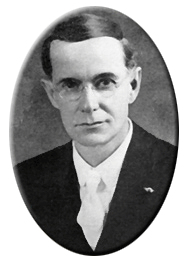 By
E. L. Robinson: By
E. L. Robinson:
In
1872 a tax of five mills for school purposes was
asked by the Board of Education. In March of that
year a committee was appointed to solicit stock for
building a school house and to determine whether it
was advisable to build. At a later meeting it was
voted to see if help could he obtained from the
Peabody fund. Evidently there had been some
difficulty in securing the funds for the school
building. There is no further record as to the
method of raising money for the building or how much
it cost. But in 1876 the first public school
building in Tampa was erected by Mr. John T. Givens
and his son, Darwin Branch Givens. This building
facing on Franklin Street occupied one-half of the
block between Madison and Twiggs Streets about where
the Shaw-Clayton book store now is in the "Sparkman
block."
(The
History of Hillsborough County Schools adds
that it was built on land sold to the County for
$400 by John Givens.)
This development was met with great dissent from
county
residents who felt that the Board had exceeded its
authority in constructing the school. The controversy
was finally settled through a statement from the
Attorney General of Florida, who reasserted the
authority of the School Board.
In 1888 the property
here was divided into lots and sold. The last three
lots were bought by Sparkman & Sparkman for $3,000.
John
T. Givens and his family came to Tampa on Dec. 25,
1848, to help rebuild two months after the
disastrous hurricane of 1848. He is credited by
some sources as having built Tampa's oldest and still
existing house, the old Dr. Stringer/Imboden Stalnaker
house.
|
It is the
opinion of TampaPix that the plans to build
the public school facility may have been begun in
1876, but it was not fully completed and
ready for use until Jan. 1878. This is
based on a Jan. 12, 1878 article by the
School Board in the Sunland Tribune.
See below. |
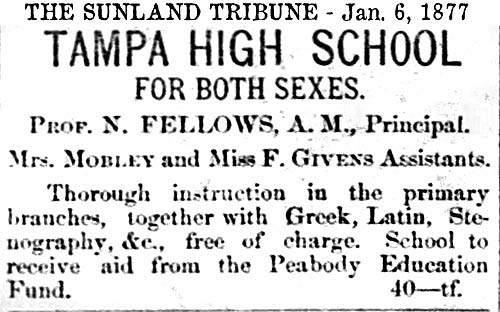
DR. JOHN P. WALL SUCCEEDS W. F. WHITE
AS SUPERINTENDENT OF PUBLIC INSTRUCTION IN 1876
THE
FIRST PUBLIC HIGH SCHOOL
(According to
"The History of Hillsborough Co. Schools)
The
first high school was opened in Tampa as Tampa High
School.
The advertisement in the Sunland Tribune, dated
1-6-1877, documented
the existence of the first public high school program
in the area**. "Tampa High School" operated
with only three instructors, including the principal.
The School Board
minutes concur with this newspaper ad. Board minutes
in 1876 appointed Professor Fellows as a teacher of
School # 1 and principal of all other schools in
Tampa. Later in 1877, Board minutes documented the
appointment of Dr. Fellows as the first principal of
Tampa School #1, also known as Tampa High School.
Perhaps the introduction of the name "Tampa High
School" was an effort to differentiate the
first
high school program** from
grammar school section of School #I. The high
school and elementary school shared the same
facility during these early years.
|
**The ad
specifies a thorough program in the
primary branches, but only three
classes apart from the primary branches:
Greek, Latin and Stenography. This
hardly constitutes a High School
curriculum, regardless of what it or the
county calls it. It also was meeting
in a privately owned facility due to not yet having
moved into the Givens-built public school
building, as you will see later in a Jan. 12,
1878 article by the School Board in the
Sunland Tribune. As Dr. Franklin
Branch was previously one of the school's
trustees, they probably met in Branch's
opera house. |
In 1877,
W. P. Haisley, who had been the principal at the Tampa
Institute, was appointed to the position of State
Supt. of Public Instruction.
This Apr. 28, 1877
editorial below by the Sunland Tribune expresses the
dissatisfaction with the current school funding system.
Apparently the whole county was treated as one big
school district resulting in the majority of taxes
raised in the denser population areas being appropriated
to the schools in the less populated areas. It
points to the successful application of individual
school districts in the North as an example, and
advocates dividing the county into school districts, letting each district be independent in regard to
levying taxes and appropriating them in support of its
schools.
It also speaks to the lack of a
free public
High School program.
"Unless it can be rendered more successful than it
has proven to be so far, it will continue to prove a
positive disadvantage by its debauching effect on a
large proportion of parents who depend solely on the
school authorities to educate their children...
Again, under existing laws, there is but one class
of schools, so that all farther advances beyond a
mere primary English education must be acquired at
private expense."
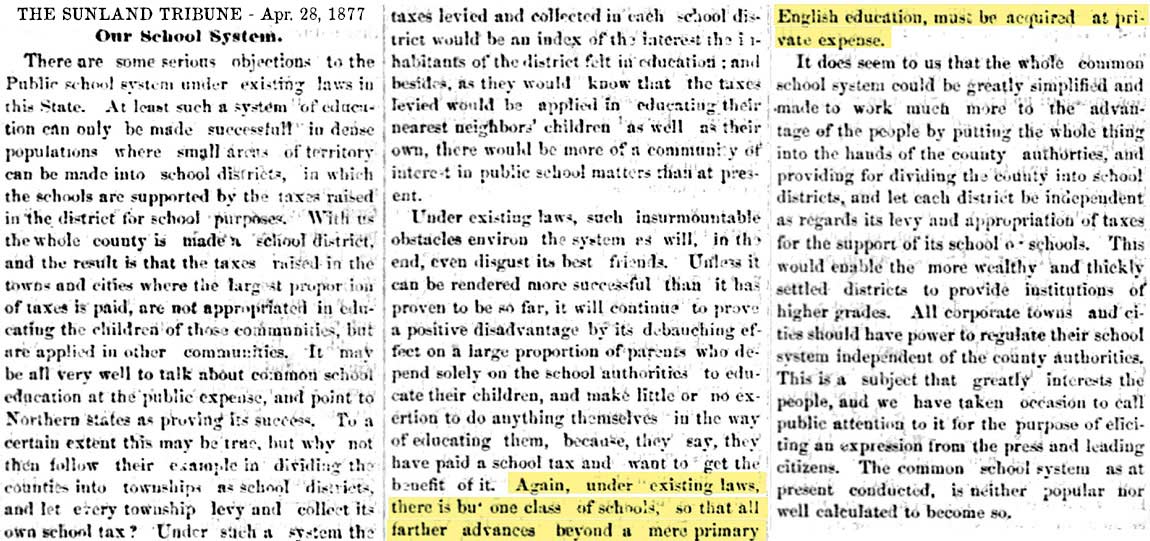
|
This is evidence that a
High School program in a free public school was still
lacking. |
WHO
WAS
W. P.
HAISLEY?
|
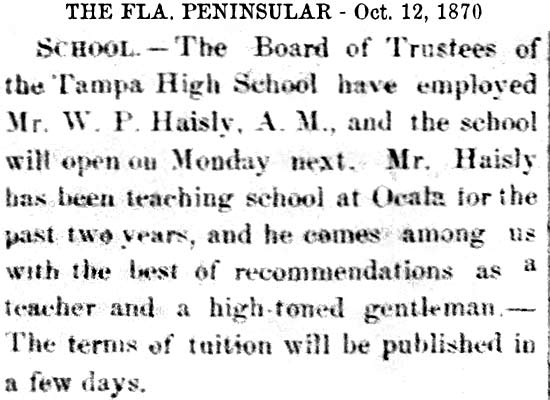 |
|
W. P. HAISLEY HIRED TO TEACH
IN TAMPA
|
|
Although William didn't have
an A.M. (Master of Arts), he
did have an A.B. (Bachelor
of Arts) and an LL.B.
(Bachelor of Law) from some
rather "high-toned"
institutions.
Learn more about W. P.
Haisley and see just how
"high-toned" he was.
See why he came, he taught,
he left and returned.
|
|
THE BUSY LIFE OF WILLIAM
PENN HAISELY |
|
According to the combined
research of several contributors, William Penn
Haisley was the fourth of at
least six children of
Alexander Brown Haisley of
N. Carolina and his wife Ann
Phillips. Born in
Indiana in 1831, he did a
bit of traveling before
coming to Florida--the FIRST
time and the SECOND time.
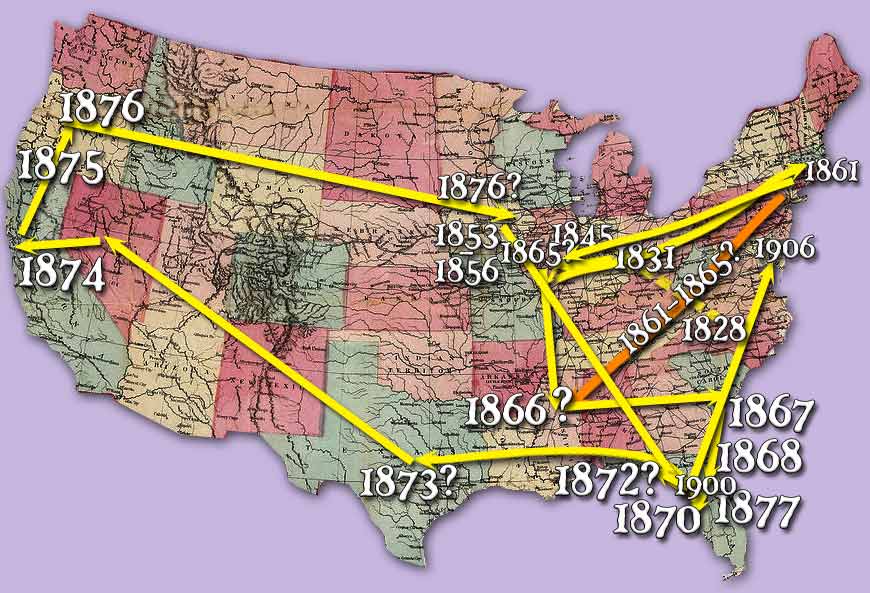
|
|
|
SCHOOL BOARD SETS TEACHER CERTIFICATION
REQUIREMENTS AND OTHER PROCEDURES
The County
School Board met on Sep. 17, 1877 and
set the school term for 1878 at four
months with a rate of funding of $1 per
pupil per month. It ordered that
all teachers must be examined before
teaching, and the necessary paperwork
turned in to the Superintendent for
teachers to be paid. Four teachers
were examined and given second class
certificates. For areas that wanted
a new school, parents and guardians had
to petition the board and include names
for Trustees to be reviewed and
appointed. Teachers were required
to sign a written contract with the county
superintendent before teaching, at which
time they would receive a register book
and necessary forms to fill out so they
could get paid. This would be
enforced more rigidly than it had been
in the past. If a school needed to
be suspended for a time, it was to be
mutually agreed on by the Trustees,
patrons, and and teachers, with time to
be made up at the end of the term.
SAUNDERS AND DUFFEE HIRED AS PRINCIPAL
AND ASSISTANT
It was also announced
in the same issue of the Tribune that
the Public School of Tampa would open on
Oct. 1st for the new school year.
The principal was to be C. A. Saunders,
a graduate of Emory College in Oxford,
GA and the "recipient of the first
honor" (class valedictorian.) The teacher
assisting him was to be
Mrs. Duffie, who had taught a private
school in Tampa during the previous
summer, "and the rapid advancement of
her pupils gave universal satisfaction
to the patrons of her school." She
also had high recommendations from
"distinguished gentlemen and classical
teachers in Virginia where she had been
teaching. The School Board
congratulated the school's trustees for
securing the services of such competent
teachers.
The Board also urged
the trustees to seriously consider
hiring a good music teacher as soon as
possible because it would not only bring
in "many girl pupils from the country,"
there were many girls in town whose
musical education should not be
neglected.
|
|
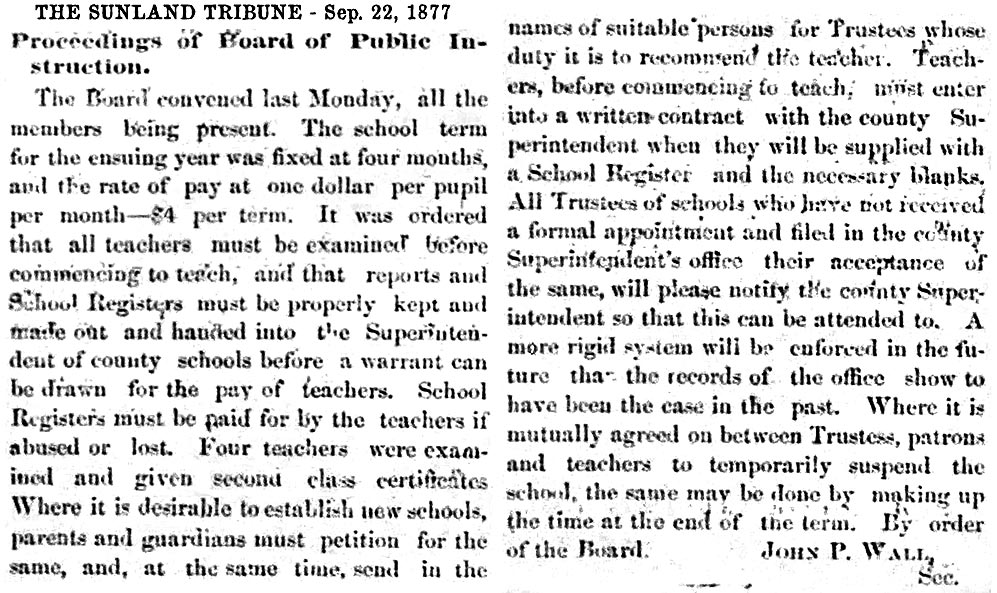 |
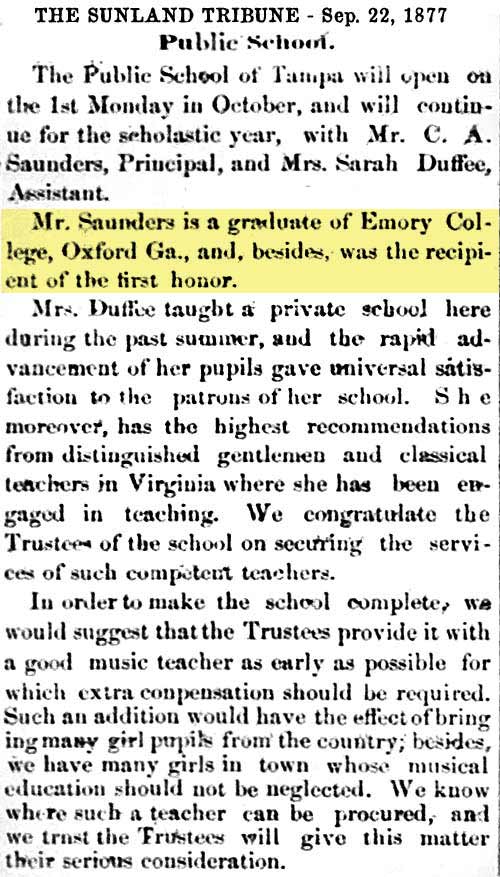 |
|
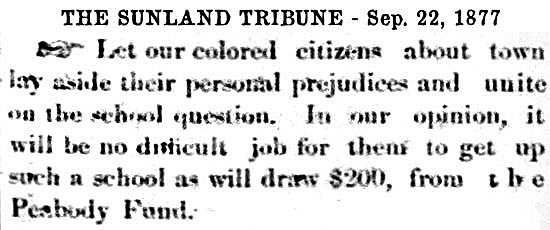
Even though
colored pupils were not allowed to
attend Tampa's schools, the Tribune
urged colored citizens in town to
lay aside their personal prejudices
and start their
own school! The editor considered
it "no difficult job to get up a school
that could be funded with $200 from the
Peabody Fund.
|
READ MORE ABOUT
CLAUDE SAUNDERS AND WHAT THE "RECIPIENT OF THE
FIRST HONOR" WAS.
Also see a photo of him, and find out what
college he became the first president of. All
at "Who was
Claude Saunders?"
|
|
|
|
FLORIDA PEABODY FUNDING CUT |
|
|
In the fall of 1877, a
Peabody Fund agent contacted State Schools
Superintendent W. P. Haisley to notify him of a pending
cut in funding.
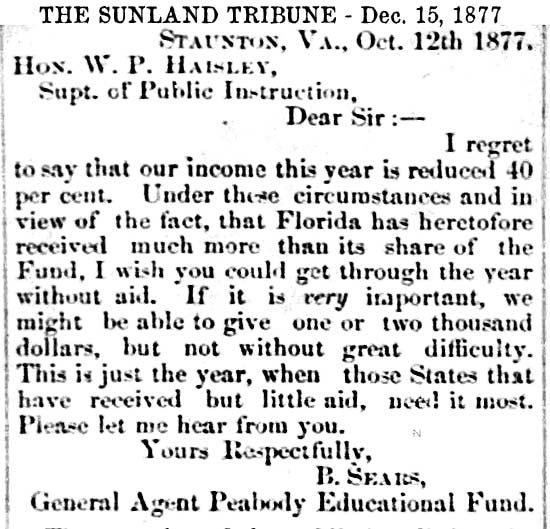
.
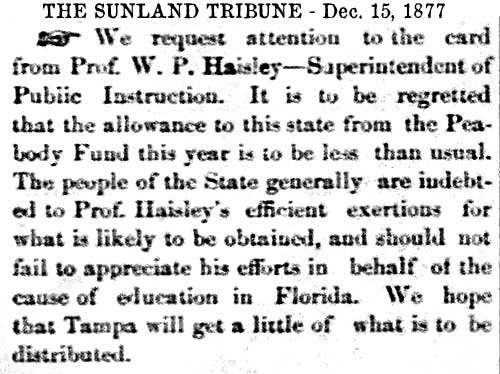
|
Haisley had actually asked for more funding for the
upcoming year, but in view of Mr. Sears's letter,
Haisley responded asking that Florida not be cut off
entirely, and be funded with enough so that schools
here which have not yet been benefited by the fund
could still be funded. He asked for about
one-half of the amount of funding from last
year--$3,000.
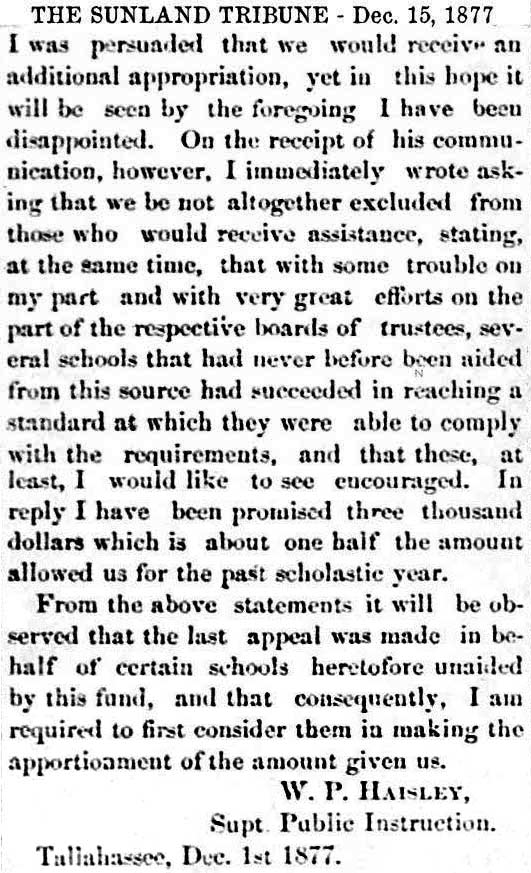
|
CONTINUING SUPPORT ENCOURAGED FOR THE NEWLY-BUILT SCHOOL
AND BOARD AUTHORITY TO HAVE FINANCED IT
Tuition payment
requested from those who could afford it, additional
funds coming from the Peabody Fund.
Tampa School to be moved into the new building today.
A Jan. 12,
1878 article (below) in the Sunland Tribune from the School Board encouraged Hillsborough County
citizens to maintain the progress of the school system
as it has been flourishing. It asked that they support
the new school for at least one quarter and they won't be disappointed.
The trustees of the school (W.B. Henderson, E.A. Clarke,
and J.T. Lesley) would accept payment of tuition from
those who felt they could afford it, so they could make
up the salaries of the teachers for one quarter.
They needed to keep up the high level of enrollment, but
those who could not pay should not keep their children
from attending, that "no false pride...will induce
them to keep their children from the school, for by
doing so they will be inflicting a serious injury on the
community by depriving it of the benefit of the Peabody
Fund." This subject ends with a plea to the
trustees and teachers to "spare no pains and efforts
to have things go on harmoniously" and if they could
get through the year, there should be no more problems.
It goes on
and speaks to the controversy created by some
believing that the school board had no authority to fund
the building of a new structure from county school
funds. It seems that opposition from outlying
areas, "in the country," questioning the
authority of the county-financed structure was due to
its location, in the heart of Tampa. The outer
areas wanted a building in their own areas, and with the
location selected, their tax dollars were spent where
they felt they weren't being benefited. To this
issue, the Attorney General of Florida was consulted and
ruled that the Board had the authority, not only to
finance the building of a school structure, but "to
do...almost anything else which in its judgment would
promote the educational interests of the country."
[sic] (probably "county.")
It ends
with the Board stating that they are authorized to say
(to put it bluntly,) when you are able to keep a large school going
for a whole scholastic year, the Board will build a
school for it. "This school (Tampa No. 1) is open
to pupils from every section of the county as much so as
it is to those of the town."
|
It
certainly sounds like they're
getting ready to start something
new, "...support the
new school for at least
one quarter..." The third
column begins with "the
school will be moved today into
the new school house, recently
erected by the Board of Public
Instruction of this county."
If
the building was completed in
1876, why now in 1878 would the
school board call it "the new
school house, recently erected?"
And the fact that the school was
moving in at this time means it
was NOT in there previously.
So did
the building sit vacant, unused for a
year and a half to two years?
Not likely. This is
evidence that the
building wasn't completed in
1876 and had just recently been
completed.
Regarding the
great controversy over whether
or not the County could legally
use the tax-generated funds to
build a school house, it is
highly unlikely they would have
proceeded with its construction
before the opinion of the
Attorney General was rendered. |
|
|
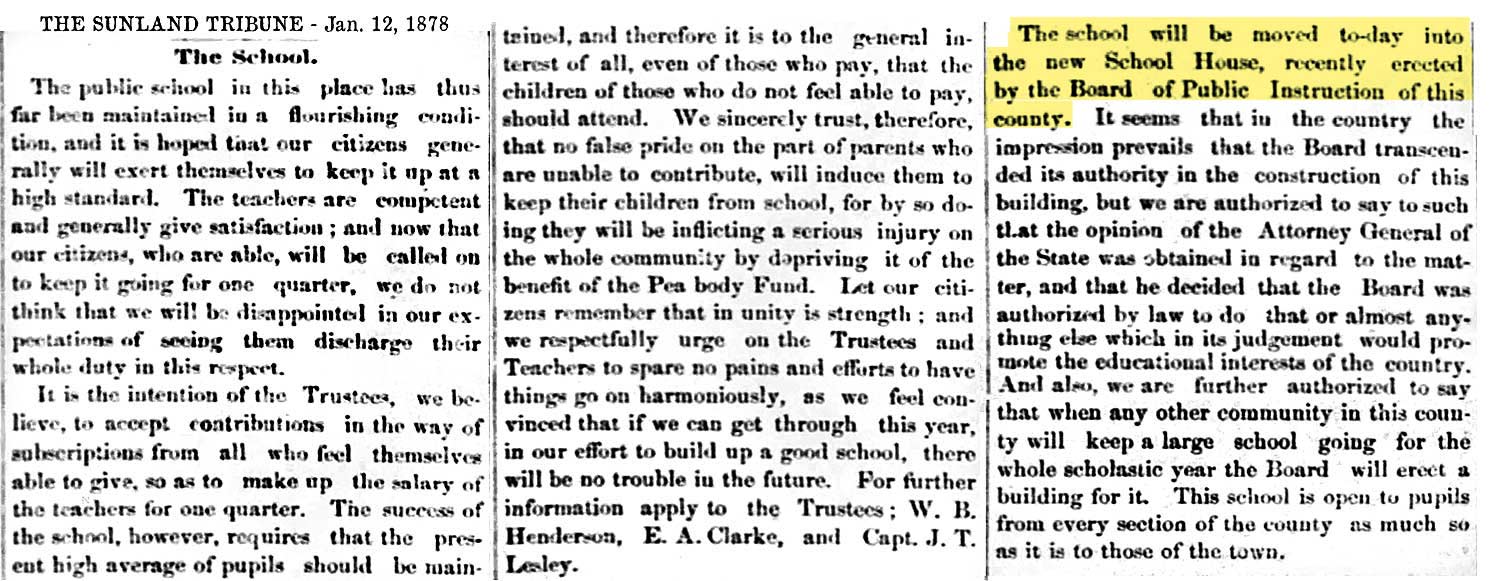
|
The article makes
no mention of the High School,
public or private, so in this
regard it is the opinion here
that this was a move of the
elementary or primary level
classes into the newly built
public school building.
|
In
1878, Tampa School, sometimes referred to as the "Tampa
Institute," was fully operational with three teachers.
These teachers and their salaries were as follows: Mr.
S. Sparkman ($166.66 per year) Miss M. Prevatt ($80 per
year) Mr. W. Hensley ($135.30 per year)
|
A RARE
DESCRIPTION OF THE COUNTY-FINANCED TAMPA SCHOOL No. 1
BUILDING
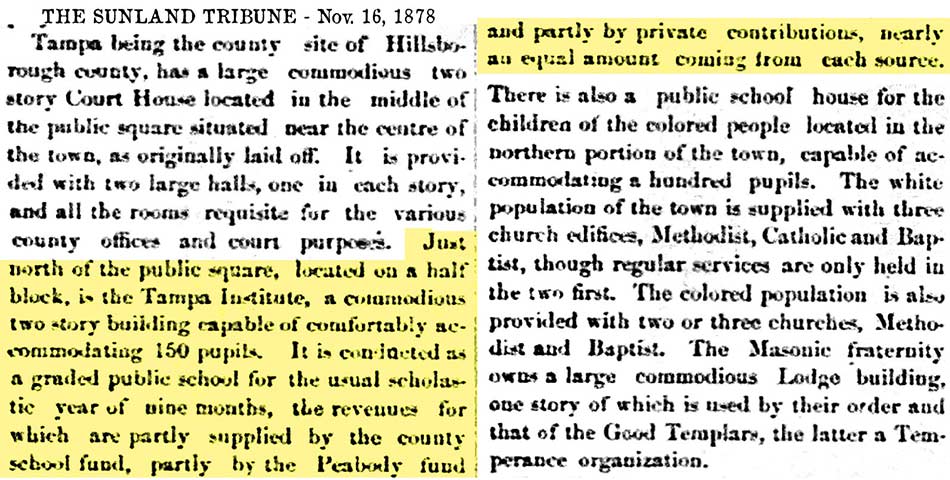
The building was
located on the block north of the courthouse square.
It was a 2-story building that could easily
accommodate 150 students. It was being used as
a graded public school for a scholastic year of nine
months (not yet), and it was being funded from three sources:
the County school fund, the Peabody fund, and
private contributions, nearly in equal amounts.
|
If the building
was being
used for the high school,
the editor of the Tribune most
likely would have taken
the opportunity to boast about
this great achievement. To
this point, no sources indicate
that the high school operated in
this building teaching a full
high school program. |
 THE
FIRST COUNTY-FINANCED & BUILT SCHOOLHOUSE THE
FIRST COUNTY-FINANCED & BUILT SCHOOLHOUSE |
|
The Tampa School No. 1 building was
located at what was in 1911 the 500 block of Franklin
Street,1
between Madison and Twiggs Streets. This is the block
just north of the county courthouse as Doris' history
states.
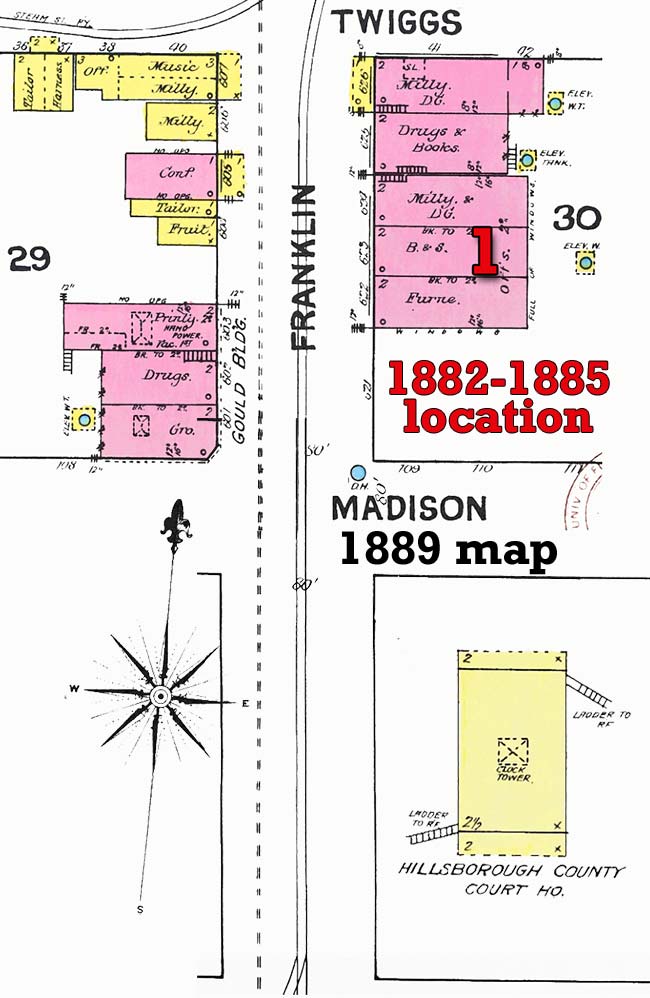
1889 Sanborn Fire Insurance Map from University of Florida
Digital Collections |
In E. L. Robinson's
"History of Hillsborough County" published in 1928, he states that
the schoolhouse was located "where the Shaw-Clayton bookstore
is now." Tampa's 1927 city directory shows this bookstore
was located at 509 Franklin St.
1Although
the 1889 map at left shows the block north of the
courthouse, between Madison and Twiggs, was the 600 block,
the 1892 map below shows the addresses along Franklin St.
were renumbered by 1892, and shows both the old 623 and the
new address 509 Franklin St. When Doris wrote her
history in 1911, that location was 509.
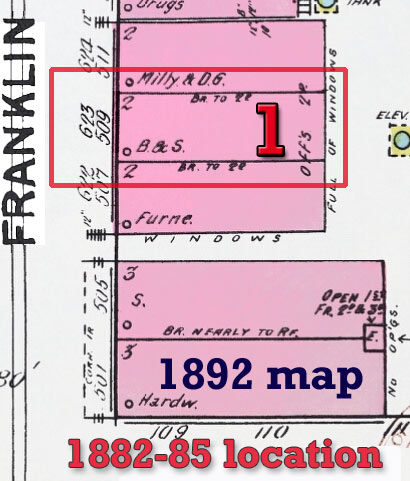
The school's location was at
the middle of the block of Franklin St., on the east side of
the street around where this map shows "B & S" (which could
stand for Books & Stationery.)
Since yellow structures were
wood frame buildings and the pink ones were brick, the
old wooden school building (everything was built from
wood in the 1870s) was apparently torn down and replaced by
the brick structures seen here in 1889. |
|
|
|
Present day
aerial view of this block.
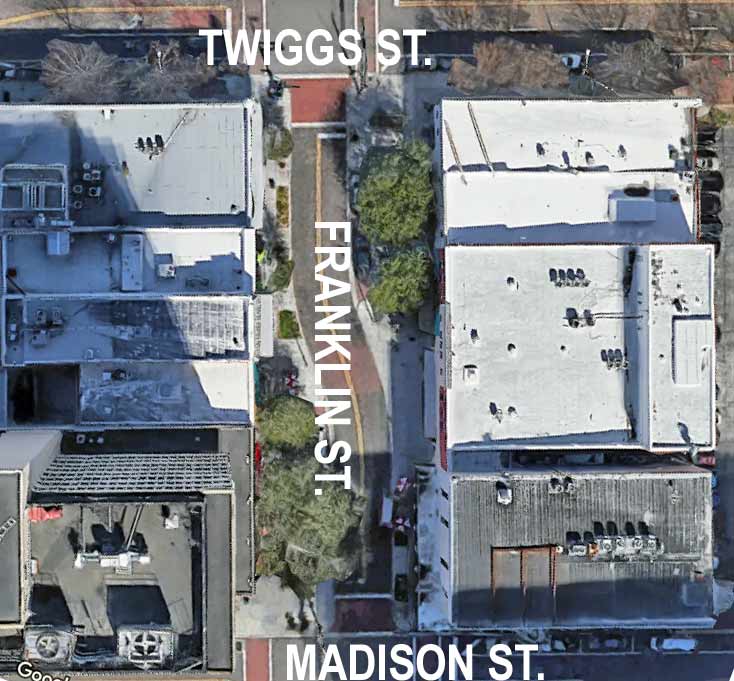
Recently, this address is
occupied by the CI Group.
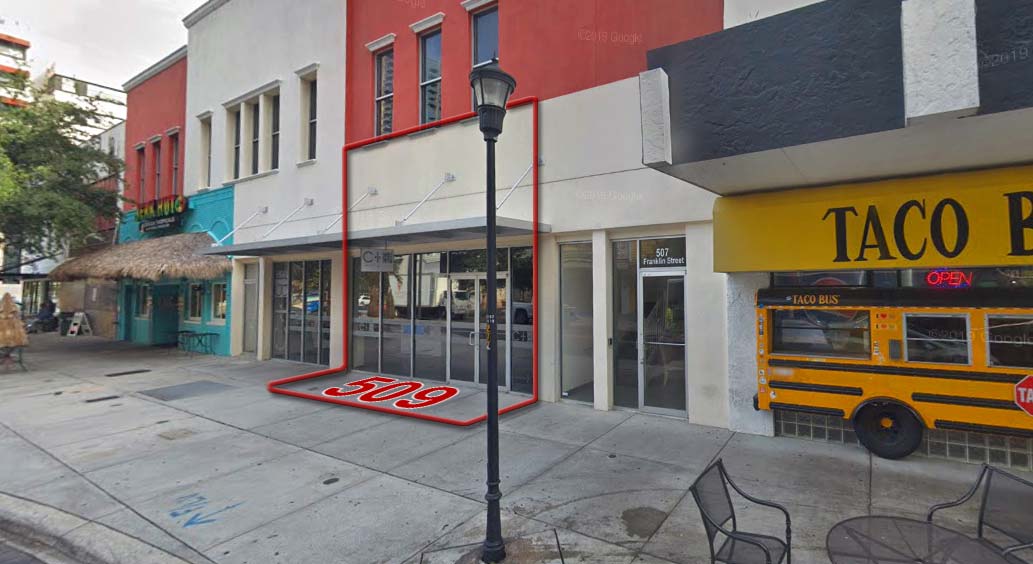
In 1929, E. L.
Robinson provided the early history of Hillsborough County's
education system in a Tribune article. Having just published
his book on the history of the county, the info would have been
fresh on his mind. This is an edited version with quite a bit
of the mid-section removed.
See the
WHOLE article here.
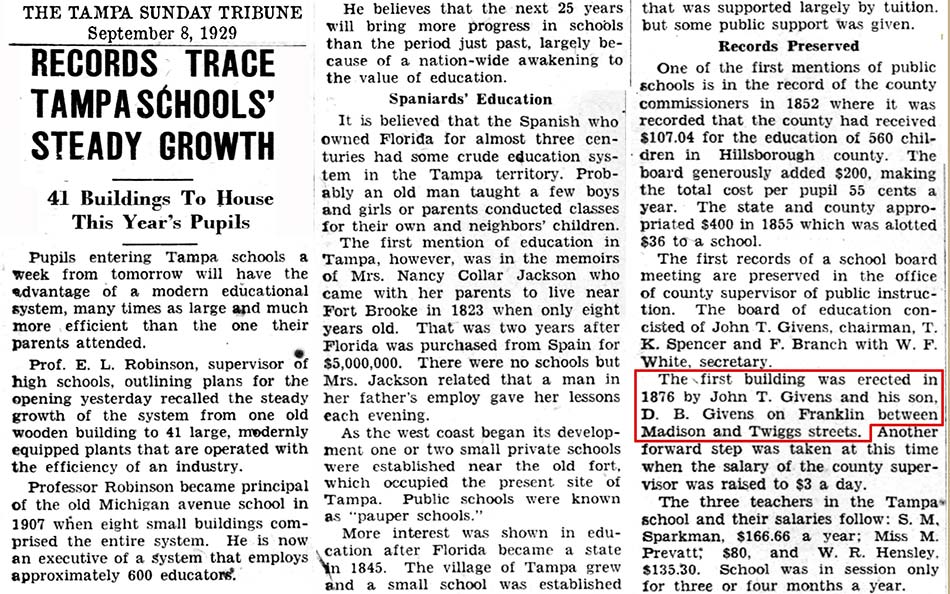
|
|
TAMPA INSTITUTE IS FLOURISHING,
BUT LACKS PROFESSIONAL CAREER
TEACHERS
Mar. 30, 1878 -
John P. Wall, editor of the
Tribune, physician & surgeon,
Mayor of Tampa and
Superintendent of County
Schools, praised the success of
the school, but indicated that
the present teachers and
principal were not people who
were pursuing education as their
career:
"Considering
that it is the first
successful attempt made in
Tampa to maintain a graded
school, the result so far is
very gratifying, indeed, and
speaks well for the public
spirit of our citizens...By
commencement of the next
scholastic year, the
Trustees of the school will
be able to provide the
Institute with experienced
teachers who have followed
teaching as a profession and
consequently feel more
identified with the success
of the school than those who
take such positions for
temporary employment without
expecting to follow it as a
life business...success must
depend on application and
devotion to the calling..."
|
|
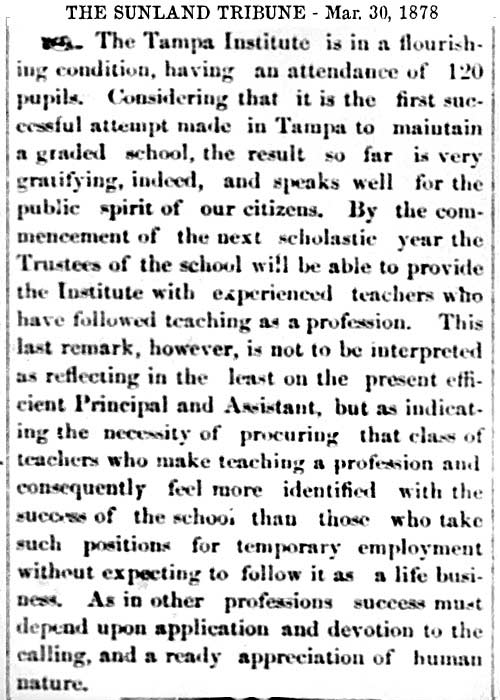
|
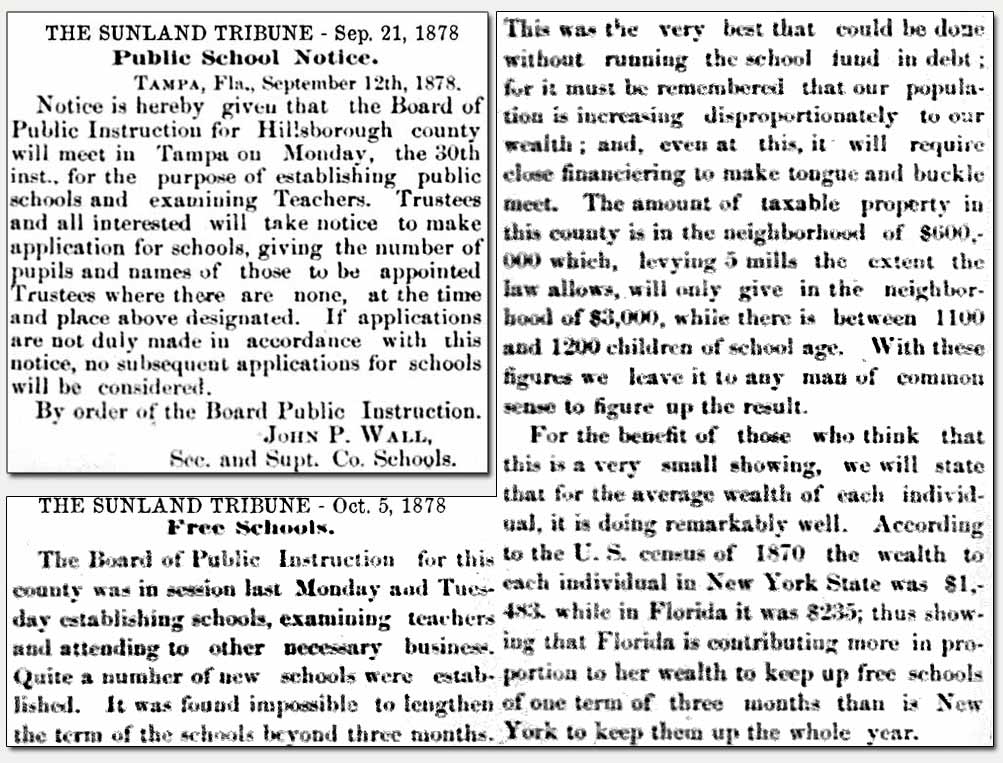
|
|
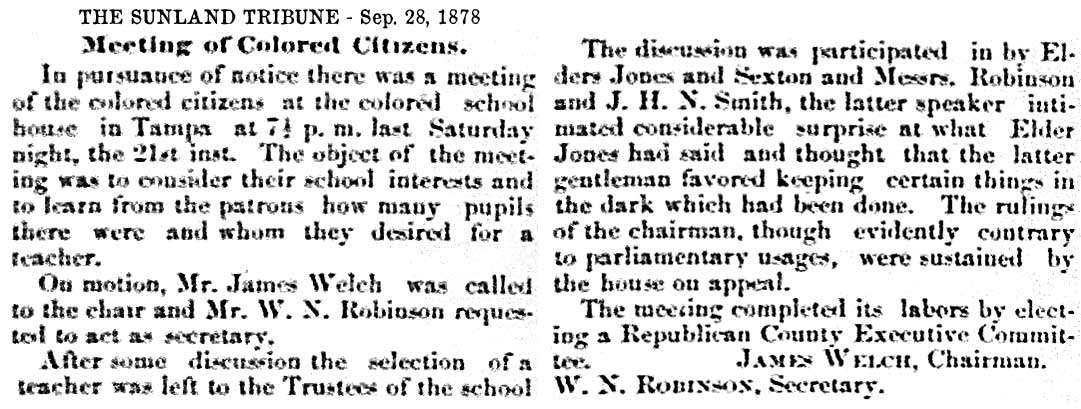
Oct. 5, 1878 -
REPORT OF THE Sep. 30/Oct. 1 SCHOOL BOARD MEETING
Teachers were examined and other business attended
to, including establishment of new schools. It
was found impossible to lengthen the term of the
schools beyond three months without running the
school fund into debt due to "our population
increasing disproportionately to our wealth."
The county taxable property was $600,000 and even
with a maximum tax rate allowed by law, 5 mils, it
would only yield around $3,000, yet there were
between 1,100 to 1,200 children of school age.
(Under $2 per child.) Citing 1870 Census
figures, Florida was contributing more to free
schools in 3 months than New York for the whole
year, in proportion to their wealth.
In 1878, the "Tampa Institute" or School #1 was
the first "graded" public school in the entire area
of southwestern Florida.
Soon after, other schools followed with the "grading
system," but most were private schools.
Schools' terms in the county were limited to three or
four months, except for Tampa School which provided
classes for 5 or 6 months. (Teachers were paid according
to their "class" (i.e., certification & experience). -
Class Two teachers received $30 per month. - Class Three
teachers received $25 per month. - Superintendent's
salary was set at $100 per year.
|
|
Although the
above articles speak of a "graded school" it doesn't
specifically mention a High School.
If the Tampa Institute had a
complete high school curriculum,
its population would likely have
been given in two groups,
primary and high school. A graded school is one where
students have been segregated
into various levels of learning
capability and achievement,
which generally advances with
age: 1st Grade, 2nd Grade,
etc. This is in
contrast to the old "Little Red
one-room Schoolhouse" where
students of all levels were
taught in one big class
simultaneously. The High
School was still being operated
independently of the County
School system, and therefore
would not have occupied the the
county-owned facility yet, as evidenced
below in the Dec. 6, 1879 Tampa
Journal. |
|
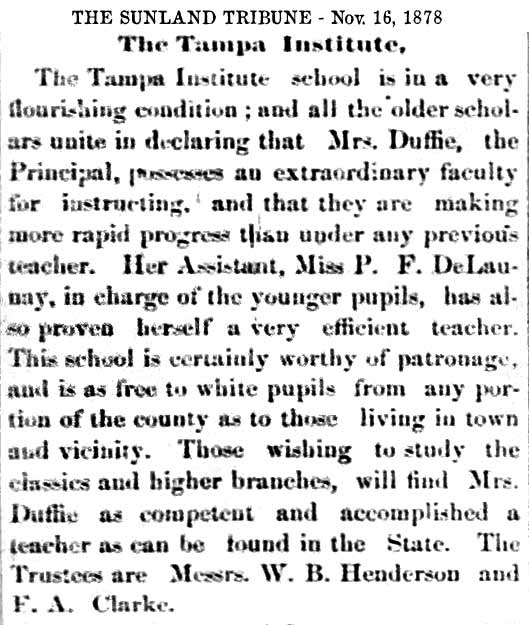
TAMPA INSTITUTE FLOURISHING
No article could be found in the
Sep. or Oct. 1878 Tribunes
regarding the start of the
school term, however this Nov.
16 article indicates it had
started with Mrs. Duffie as the
Principal and Miss P. F. DeLaunay as her assistant, in
charge of younger pupils.
Apparently Mr. C. A. Saunders,
the highly-touted principal the
previous year, was no longer a
consideration, and Mrs.
Duffie was promoted.
The article states the school
was free to all whites in any
portion of the county or living
in town.
There was an offering made
of "the classics and higher
branches" being taught by Mrs. Duffie, but no specific mention
was made as to what the classes
were.
The Trustees now were Wm. B.
Henderson and F. A. Clarke.
|
It would appear
that there still was no fully
organized or complete high
school curriculum, probably due
to the teachers still not being
professional, accredited career
instructors. This is evidenced
by the fact that every school
term that commences has a
different teacher and Principal
from the previous term.
The higher classes probably
still consisted of Latin, French
and Stenography. |
WHO WERE MRS. DUFFIE and P.
F. DELAUNAY?
A search of Hillsborough County
censuses for 1870, 1880 & 1885
finds no Duffies in 1870, and two Duffie families in 1880 living
in a rural area:
James M Duffie
and wife Mary. James is a
blacksmith, Mary is keeping
house.
George Duffie and
wife Julia M, George is a
farmer, Julia is keeping house.
Both Duffie families are on the 1885 census
with neither of the wives having
an occupation. It appears that
Principal Mrs. Duffie was
another non-career instructor
who had talent to teach or lead
a school.
P. F. DeLaunay
was Pauline DeLaunay, a daughter
of Tampa's 2nd Mayor and former
Postmaster of Tampa, Alphonso
DeLaunay, and his wife Victoria
(Montes de Oca) DeLaunay. (She
was his 2nd wife.)
They are on the 1860 Census of
Tampa with "Polene" age 5.
His son, John A. DeLaunay,
became the editor of the Tampa
Morning Tribune in the late
1890s.
1860 Census, Tampa

Widowed Victoria
and her children are on the 1880
Census of Tampa with Pauline's
occupation showing Teacher.
 |
|
PUBLIC APATHY
Even with the first
successful construction of
school buildings owned by
the Board, great resistance
continued from the public.
Enrollment and attendance
were disappointing,
especially at the secondary
level. A reporter for the
Sunland Tribune appeared to be
chastising the public when
he wrote, "We regret the
fact, but it seems
nevertheless so, that a
large majority of our
citizens do not appreciate
the advantage of education.
They seem to be careless as
to whether their children
attend school or not and
appear to leave it entirely
to the option of the child.
" In a later article, he
continued in his attempt to
convince the public by
stating, "All money expended
in educating our children is
the most profitable
investment that parents can
make for their children's
future."
|
The above portion
in bold comes from the Feb. 15,
1879 article below, which is
actually in praise of the public
for for taking more interest in
supporting the schools, citing
"a little upwards of 100 pupils
on the register of the high
school." This doesn't seem to be
an attempt to convince as much
as it does praise. The earlier
article alluded to above has not
been located, but the source of
the above cites the entire
paragraph as being from the Feb.
15, 1879 Tribune article. --TampaPix |
|
|
This article specifically speaks of the
success of the Tampa high
school, now in its 5th month,
which would indicate it started
in Oct. 1878. A page by
page inspection of all the
Sunland Tribunes finds no
mention of school starting in
Sep. or Oct. |
|
This article refers to the Tampa
High School as being independent
of the "present school system"
and expresses optimism in that
regard. Citizens of Tampa
were growing dissatisfied with
the present system of funding
the schools as one school
district. |
|
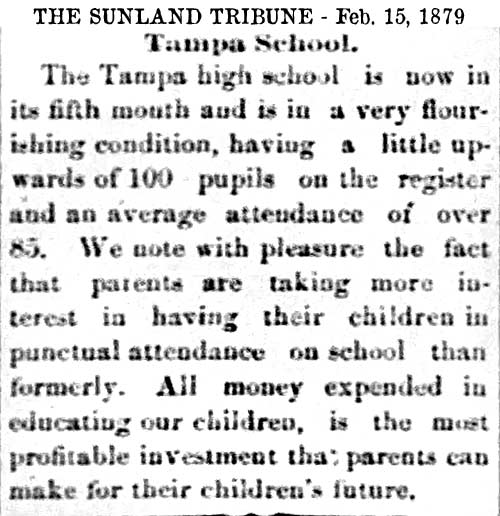 |
|
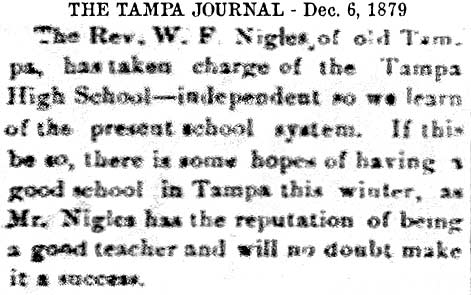
WHO WAS REV. W. F. NIGLES?
See his censuses below. |
|
1870 Census, Hillsborough
Co, Pct. 4
Although this census shows
his middle initial as "S,"
he was William F. Nigels as
seen on his 1900 Census.

William was a farmer, age
37, born in Prussia.
His wife was Harriet, age
23.
1880 Census, Hillsborough
Co., Pct. 4
William F. Nigles

Again, we see Mr. Nigles/Nigels
was a farmer, born in
Prussia (soon to become
united as Germany.)
He also appears on the State
of Fla. agricultural census.
1900 Census of William F.
Nigels, Pct. 4

Here Mr. Nigels had no
occupation, age 66, married
37 years to Harriet, born in
Germany, immigrated in 1850,
was a naturalized citizen.
His reputation as being a
"good teacher" was probably
in his church, but he was no
career educator with a
degree.
|
|
SUPERINTENDENT HENRY L. CRANE
Before 1877, the
school term was seldom more than three months,
except in Tampa School No. 1 where it was sometimes
five or six months. In 1877 the minimum school
term was fixed at four months and the teachers'
salaries at $30 per month for 2nd class teachers and
$25 for 3rd class teachers. The county
superintendent's salary was $100 per year.
In 1879 Henry L. Crane
became superintendent and secretary to the Board,
serving until 1881.
In 1880, Crane illustrated the problem faced by
the Board in NOT owning the facilities used for
public education. He stated to the Board,
"There are
but few permanent buildings over which the Board has
any control, and schools are often dependent and
subject to the will of those owning the buildings,
and are not always conveniently located. This makes
a necessity for two schools sometimes, where one
would be sufficient if the convenience of the whole
community was looked to by the trustees."
|
|
HENRY L.
CRANE -
TAMPA CITY
COUNCILMAN
-
Councilman,
August 11,
1873 –
August 1874
-
President,
August 14,
1877 –
August 14,
1878
-
President,
August 14,
1883 –
August 13,
1885
-
President,
August 13,
1886 – July
15, 1887
-
Councilman,
March 4,
1892 – March
10 – 1893
-
Councilman,
March 10,
1893 - March
9, 1894
Henry L. Crane's
father,
Henry A. Crane,
was born in New
Jersey in 1811
and worked as a
clerk in
Washington DC.
He came to
Florida during
the 2nd Seminole
War and had a
modest but
successful
military career
in the 2nd and
3rd Seminole
Wars.
H.A. Crane was a
man of moderate
means, but his
literary
abilities
provided him
with the
opportunity to
serve in many
minor political
positions. After
his enlistment
expired, he
settled in St.
Augustine where
he met and
married Sophia
Allen. Their
only son,
Henry Lafayette
Crane, was
born there on
Sept. 25, 1838.
In the 1840s the
Cranes settled
Orange County,
near Fort
Mellon, now part
of Sanford. H.
A. was a Clerk
of the Circuit
Court and in
1844, Gov.
Moseley
nominated him
for judge of
probate at
Orange Co.
In 1852 H.A.
Crane brought his
family to Tampa,
gave up farming,
and founded the
Tampa Herald
newspaper in
1852,
working full
time as its
printer and editor.
Later he was
editor of the
Florida
Peninsular
newspaper.
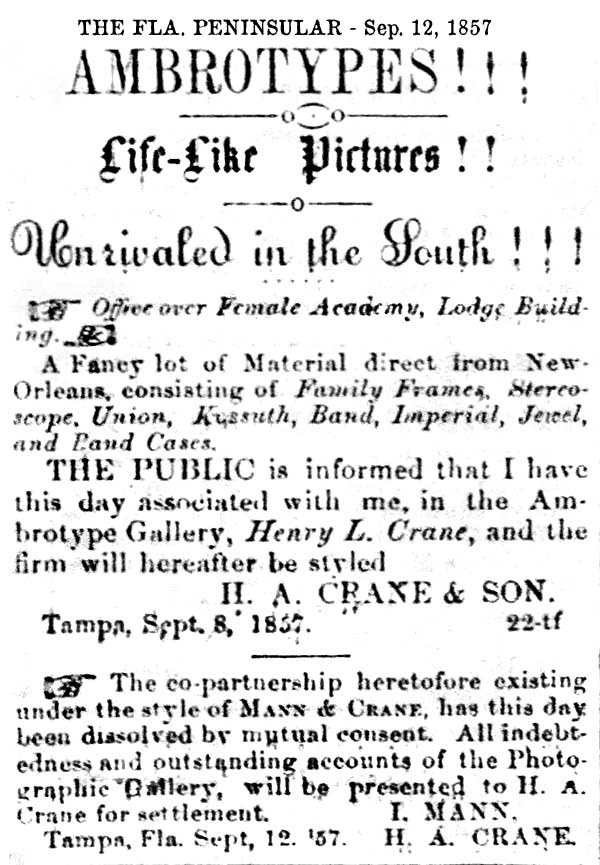
H. A Crane was
intelligent and
inquisitive
enough to profit
from his
readings about
new inventions
elsewhere in the
world. He became
interested in
photography
during its early
development, and
six years after ambrotype
photography was
introduced, he
listed his
occupation as an
ambrotype
artist.
During the Civil
War H.A. was a
Unionist, a
captain and
later a major in
the Second
Florida Cavalry,
U. S. Army. After the war,
the Republican
H.A. settled in
Key West where
he served as
clerk of the
circuit court
and as state
senator. He was
also editor of
the Key West
Dispatch and,
subsequently,
founder and
editor of the
Key of the Gulf.
But his son, H.
L. Crane joined
the Confederate
forces as Chief
Musician of the
Fourth Florida
Infantry, CSA.
H.L.
Crane and the
Ferris brothers,
Josiah and
William, had
been members of
the Tampa Brass
Cornet Band,
organized March
31, 1860, by J.
A. Butterfield. H.L. was captured
near Spring
Hill, Tennessee,
Dec. 21, 1864,
confined at Camp
Chase, Ohio, and
released Feb.
18, 1865.
H. L. Crane
later owned
and operated the
Orange Grove
Hotel with his
wife for many
years in the
1870s and 1880s.
It was located
near the present
day intersection
of Madison St.
& East St. There
is a historical
marker in
downtown Tampa
where hotel was
once located.
The hotel was
built in 1859
originally as
the home of
cattleman
William B.
Hooker,
Florida's
pre-Civil War
"cattle king."
During the Civil
War, it was used
as Tampa's
Confederate
Headquarters. It
is where Tampa
pioneer Joe
Robles marched
his captive
Union soldiers
in the winter of
1863.
|
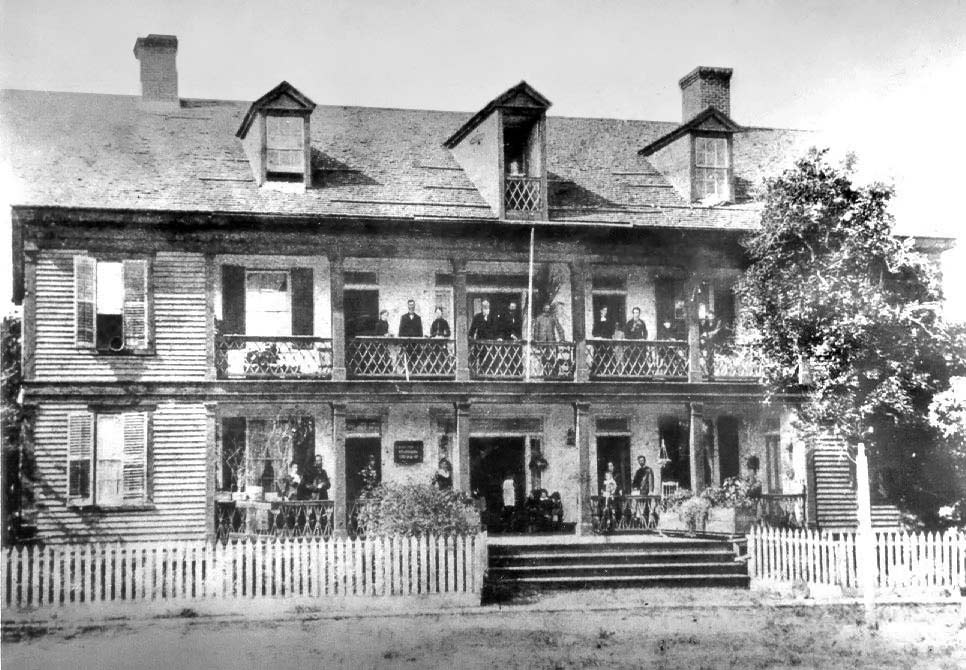
|
|
Judge Henry L.
Crane and his
wife, who
operated the
hotel in 1876,
are said to be
standing on the
left side of the
second floor
porch. Poet
Sidney Lanier
has been
identified by
contemporaries
as the man
standing on the
far right side
of the second
floor porch with
his leg propped
on the rail. But
D. B. McKay in
the Tampa
Tribune, March
6, 1955, said
Lanier is
standing at the
left end of the
first floor
veranda. Located
at 806 Madison
Street. The
original of this
photo was owned
by Mrs. Samuel
E. (Mary Hooker)
Hope, later Mrs.
Clara (Hope)
Baggett and then
by Mr. and Mrs. L.E. Vinson of
Tarpon Springs. |
|
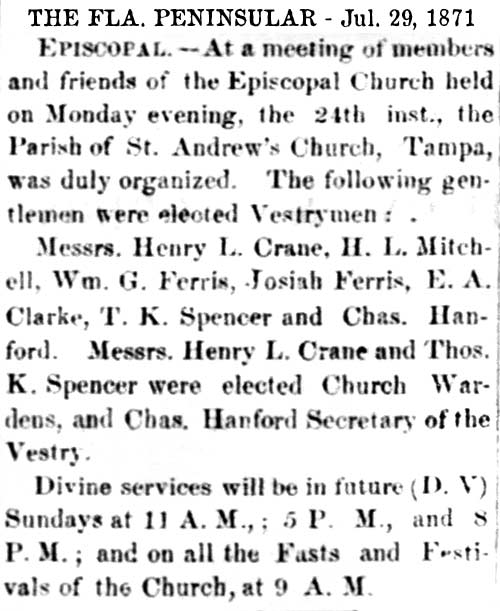 In 1866, Hooker
converted his
home into a
hotel and sold
it to D. Isaac
Craft, father of
Isaac S. Craft.
D.I Craft, who
at the time was
the Sheriff, was
in charge of the
jail.
While he tended
to the prisoners
in the jail, his
wife ran the
hotel.
Later, he sold
the hotel to
Judge Crane,
whose wife was
Meroba Hooker,
dau. of Wm. B.
Hooker.
Meroba was
widowed for
several years
from her first
marriage as Mrs.
Solon B. Turman.
Together, Henry
L. and Meroba
Crane
operated the
hotel for many
years into the
1880s. In 1866, Hooker
converted his
home into a
hotel and sold
it to D. Isaac
Craft, father of
Isaac S. Craft.
D.I Craft, who
at the time was
the Sheriff, was
in charge of the
jail.
While he tended
to the prisoners
in the jail, his
wife ran the
hotel.
Later, he sold
the hotel to
Judge Crane,
whose wife was
Meroba Hooker,
dau. of Wm. B.
Hooker.
Meroba was
widowed for
several years
from her first
marriage as Mrs.
Solon B. Turman.
Together, Henry
L. and Meroba
Crane
operated the
hotel for many
years into the
1880s.
H.L.
was
elected as
Tampa’s City
Clerk in 1869,
but like the
council members
who were elected
from 1869-1973,
he never served
due to the
dissolution of
the government
when the City of
Tampa
intentionally
let its City
Charter elapse.
Along with
fellow council
members Edward
A. Clarke and
Josiah Ferris as
well as former
council member
William Gould
Ferris, Sr.,
Judge Crane
was one of the
founders of St.
Andrew’s
Episcopal
Church.
|
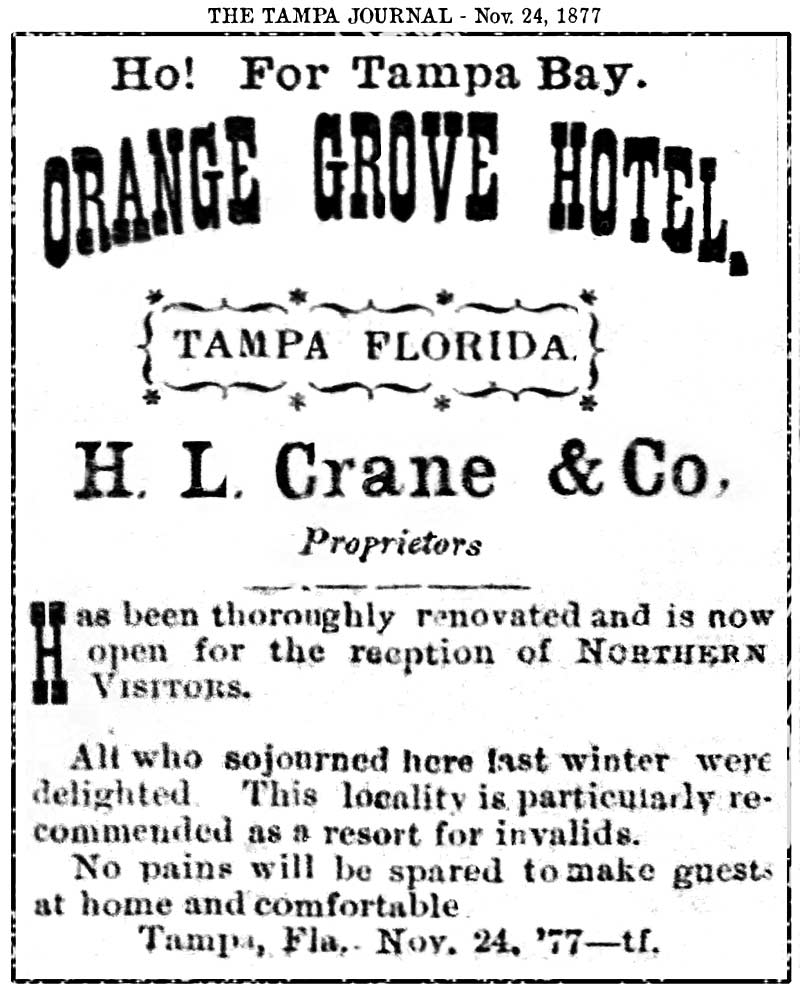 |
|
On Aug.
11, 1873, the
registered
voters in Tampa
held an election
and voted to
establish the
Town of Tampa.
Crane was
elected as one
of the new
council members
and go on to
serve a total of
six terms on
Tampa’s City
Council.
In 1879 Henry L.
Crane was
elected as
Superintendent
of Public
Education and
served until
1881. He was
also appointed
to U.S.
Commissioner in
the 1870s as
judge, a
position he held
for about 40
years.
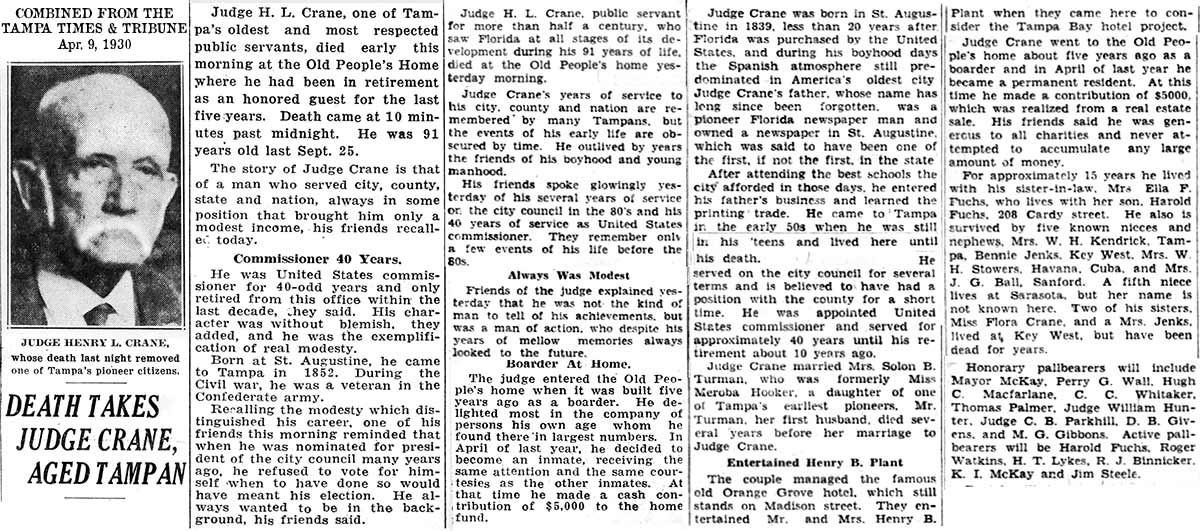 |
|
|
MORE COUNTY-OWNED BUILDINGS
AND BETTER PAY NEEDED TO ATTRACT
PROFESSIONAL TEACHERS
Throughout the late 1800's, the salary teachers received
from the Board remained very low. In most cases, these
wages were not sufficient for the living expenses of the
times. To compensate for this, teachers commonly
received a range of "fringe benefits" from the community
in which they taught. For example, in the rural areas of
the county, teachers commonly lived in a home of a
school trustee, or in the home of one of their students.
In many of these "living arrangements," teachers also
were provided with their meals. However, the problem of
this living arrangement was the lack of freedom and
privacy in the personal life of the teacher. In addition
to room and board, schools were still permitted to
charge some form of "tuition" even though they were
considered "public schools". It is likely that this
"tuition" varied greatly based on each family's
socioeconomic status. Tuition, along with other forms of
contributions from the participating families, was used
to supplement the meager salaries provided by the Board.
|
AN IMPASSIONED
PLEA FOR SCHOOL
BUILDING FUNDS -
May 3, 1879
A
Tribune reader
wrote the editor
of the Tribune
addressing the
need for funds
to build a
school house on
Nebraska Ave.
Apparently a
circular was
being passed
around
soliciting aid
for this
purpose.
There weren't
enough residents
in the area to
provide funding
themselves and
states that
everyone should
be interested in
the need, not
just the local
residents,
because it would
benefit the
community at
large.
The necessity
was made known
about a year
earlier, by the
women of the
community, and
"the wheel
revolved very
well until some
of the spokes
fell out and the
tire tired out."
Fearing a
complete
abandonment of
their need, they
had a meeting,
elected
officers, made
some rules and
regulations, and
prepared
themselves with
determination to
have a building
constructed
before half the
summer was over.
Joe Robles,
early Tampa
pioneer,
merchant, and
civic leader who
lived in the
area, donated
land for a
school building.
The writer
praises Robles,
and adds "long
may he live to
see his good
work increase
and 'flourish
like a green bay
tree.'"
He pleads for
support not just
in word, but to
"put your hands
in your pockets
giving us
liberally,
knowing after
many days it
will come back
to you ten-fold,
for this
building is
intended for all
purposes of
public benefit."
He apologizes
for asking the
Editor directly
in this way, and
adds "but you
may hear from us
gain."
|
|
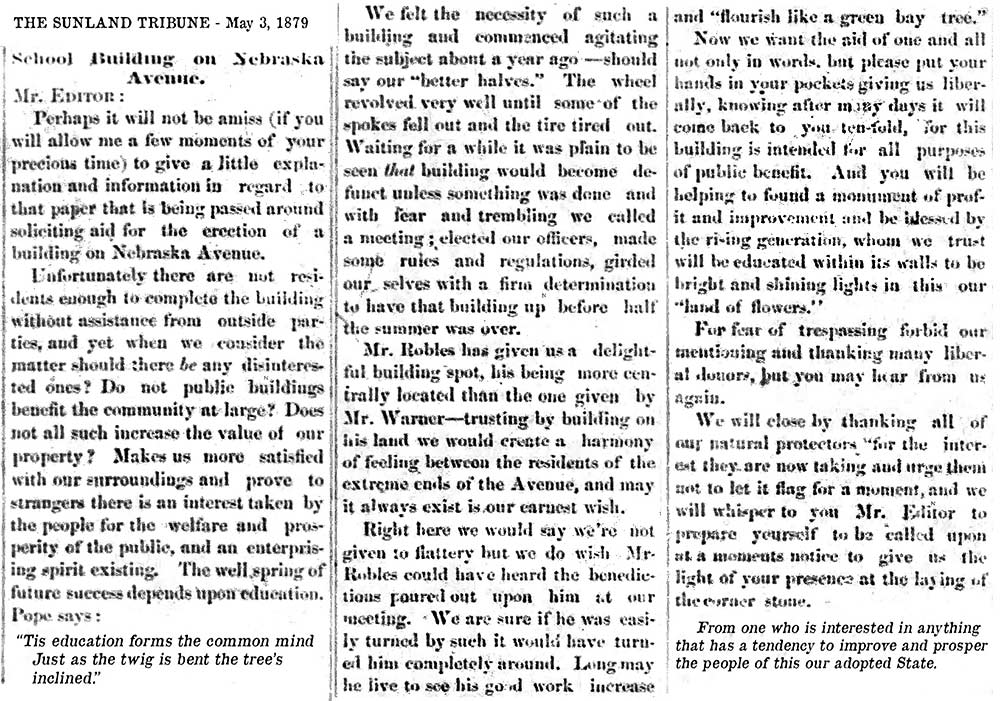 |
|
TRIBUNE EDITOR
CRITICIZES
MOTHERS FOR
OVERDRESSING
THEIR CHILDREN
FOR SCHOOL
Dr. John P.
Wall, Mayor of
Tampa and Editor
of the Tribune,
turns his sharp
tongue from
criticizing
political
opponents, to
criticizing
mothers who
"have been too
busy with their
[children's]
clothes, to pay
much attention
to their
[children's]
brains. He
says the purpose
children being
in school "...is
not the display
of the wealth or
tenderness of
their parents"
and that
anything that
diverts
attention from
learning is an
injury to the
student,
instead, working
against them.
Even teachers
would agree that
"fine clothes
oftener work
mischief to
their wearers
than mean
clothes do."
He believes
simplicity
should
characterize
their dress,
that the
"highest-minded
children are
oftenest found
in plain garb,
while these
be-ringed and
be-ruffled and
otherwise
showily attired
are generally
quite destitute
of intellectual
home culture."
He stresses
personal
cleanliness over
dress, and in
that regard he
suggests the
student have two
suits, "for in
the crowded
school-room the
clothing soon
becomes
saturated with
the exhalations
floating in the
atmosphere, and
an airing of the
clothes every
three days is
necessary to
keep them fresh
and sweet."
|
|

|
|
TEACHERS CHOSEN
FOR THE FALL
TERM OF 1880
The fall school
term for 1880
was to start on
Oct. 4 with Mrs.
Scull and Mrs.
Nunez as
teachers.
WHO
WAS MRS. SCULL?

Her obituary in
1904 would
reveal that she
was the widow of
Rev. William D.
Scull, and a
daughter of John
M. Verdier of
Beaufort, SC.
This means she
was a sister
of Miss Verdier,
the teacher in
charge of the
aforementioned
"Miss Verdier's
School."
The missing
Verdier "puzzle
pieces" linking
the two ladies
are found on the
separate page, "The
Search for Miss
Verdier" and
her school of
1876.
WHO WAS MRS.
NUNEZ?
The other
teacher was Arabella
Helen Nunez,
widow of early
Tampa settler
and merchant
Robert F. Nunez.
|
ROBERT F. NUNEZ
Robert Flournoy
Nunez was born
in 1826 in
Appling Co,
Georgia and came to
Florida during
the late 1840s. There
was a great
influx of
settlers
to Tampa just
after the
devastating
hurricane of
late Sept. 1848,
mostly because
of the need to
rebuild the
city. Many
were carpenters
and laborers.
Robert probably
came in the fall
of 1848 or in
1849.
According to his
1850 Census in
Hillsborough
County, Robert
was living in
the 19th
Division at the Manatee
settlement, which
was the area
around the
Manatee River,
now the
Bradenton/Palmetto
area. It
wasn't until
1855 that
Manatee County
was created from
the southern
part of
Hillsborough
County. On
his 1850 Census,
Robert was
24 and listed as
a laborer.
1850 Census
19th Division,
Manatee
Settlement
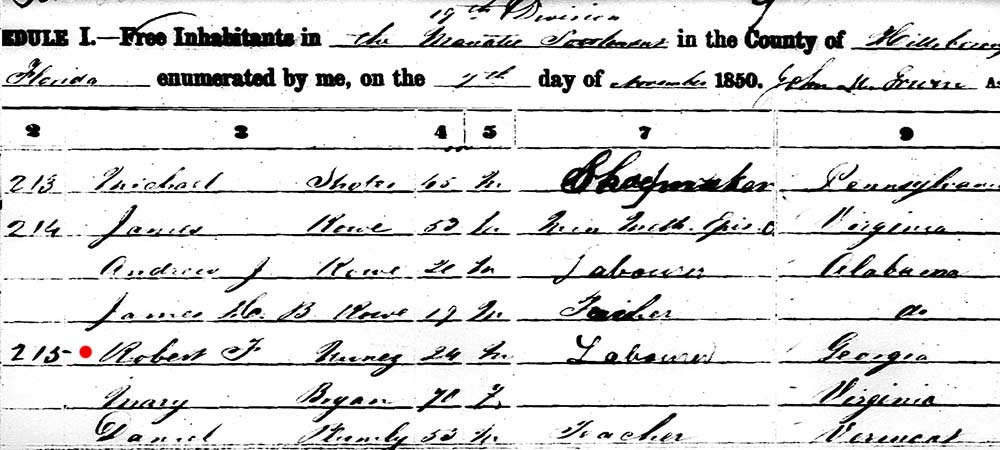
Robert
was
living
among
many
unrelated
persons
with
varied
occupations--shoemaker,
Methodist
minister,
laborers,
and
teachers.
In the 1850s
Robert came to
Tampa and was
working as a
clerk (in the
general store of
Kennedy &
Darling where he
was known to
have worked)
when listed on
the 1860 Tampa
census.
1860 Census,
Tampa
Robert, Nancy &
Emma Nunez

In Robert's home
was 40 year old
Nancy Nunez,
born in GA, and
14 year old Emma
Nunez, born in
LA.
This census
didn't list
relationships or
marital status,
but additional
research reveals
who Nancy and
Emma
Nunez were.
Find out how
they were related on
this separate
page,
Nancy & Emma
Nunez.
No family
connection to
the Irish
Methodist preacher
W. L. Murphy has
been made.
In 1860, after
the census,
Robert rented a
store room on
the ground floor
of John
Darling's new
building at Washington and
Tampa St. and started a
general store of his
own. He
offered
everything you
could imagine,
"ENTIRELY NEW
and WELL
SELECTED," "NO
OLD OR SHOP-WORN
STOCK ON HAND"
including goods
"never before
brought to this
market," but did
not sell liquor.
He even sold his
sundries "VERY
LOW for CASH" or
in trade for
country produce.
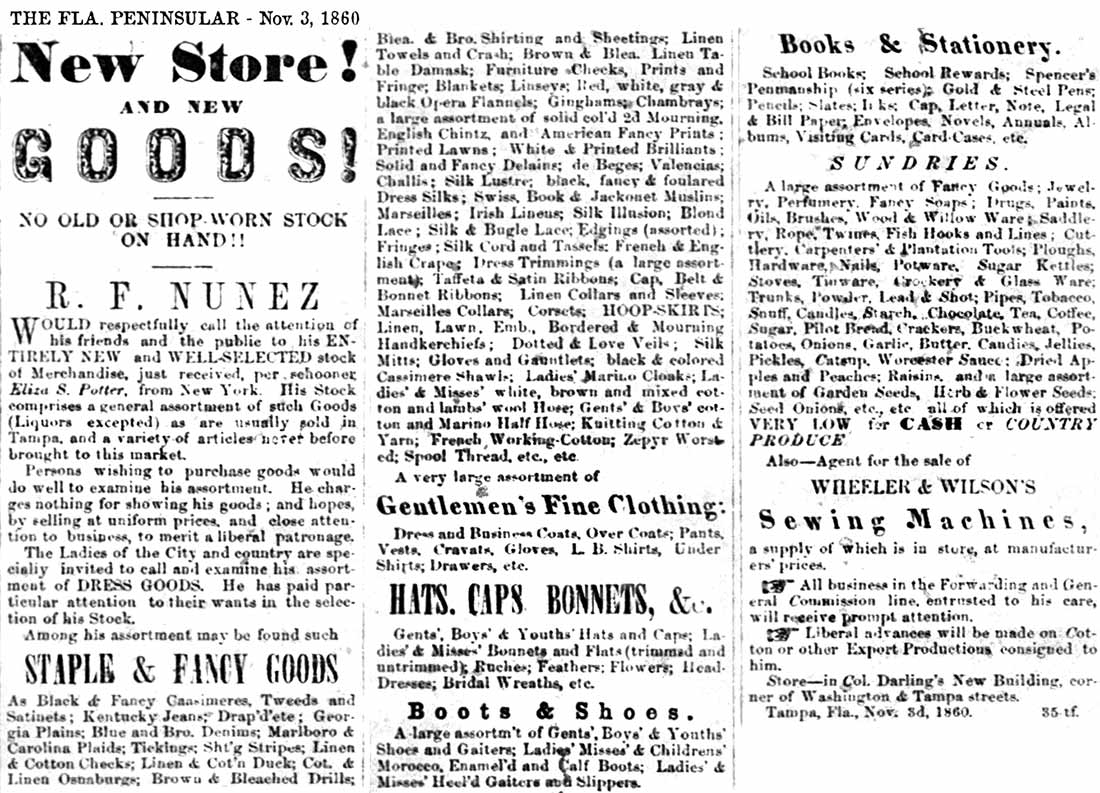
|
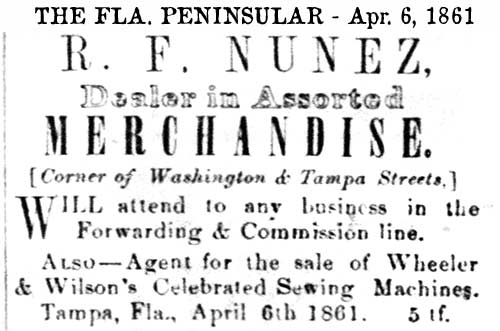 |
|
This
short
ad
indicates
he
was
still
in
business
in
April
1861.
|
The business
center of
Tampa back then was at
Washington and Tampa Streets where there was located
a number of
establishments. Among them, the general stores of John
Jackson, Christopher L. Friebele and Robert F.
Nunez, which carried all human needs from the cradle
to the grave. To supply the needs of settlers
in a greater surrounding area, Tampa boasted of having
seven more large general stores in those times: W.G.
Ferris & Son,
Capt. James
McKay, E. A. Clarke &
Co., Kennedy & Darling, Michael Wall, L. G.
Covacevich and Jose Vigil.
All these establishments advertised that they were
wholesale and retail dealers in fancy and staple dry
goods, hats and caps, boots and shoes, ready made
clothing for men and women, hardware and crockery,
plantation tools, Yankee notions, woodware and
hollowware, ship chandlery and paints, a complete line of provisions and fine
groceries, wines, and liquors (except Nunez).
Robert F. Nunez married
on July 26, 1862 to Arabella Helen Craft,
a daughter of Samuel Charles Craft and
Margaret S. Mathers. Samuel was pastor of the
First Baptist Church, private school teacher, editor
of the Fla. Peninsula in the early years, and later
a lawyer. .
Arabella was born Feb. 21, 1846 at Jefferson Co., Fla |
1850 Census,
Jefferson Co, FL
Sam Craft family
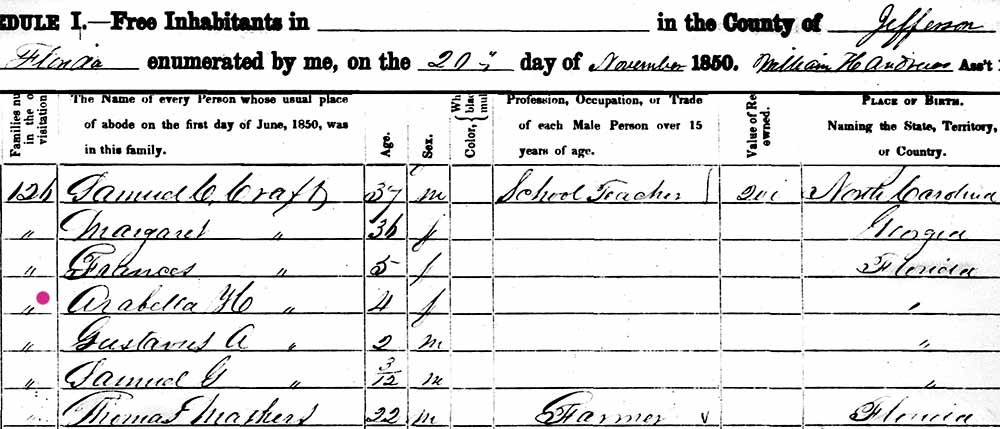
In 1850 Sam Craft was a school teacher.
Arabella was age 4 and the second of four children
listed here.
1860 Census,
Madison Co, FL
Sam Craft family
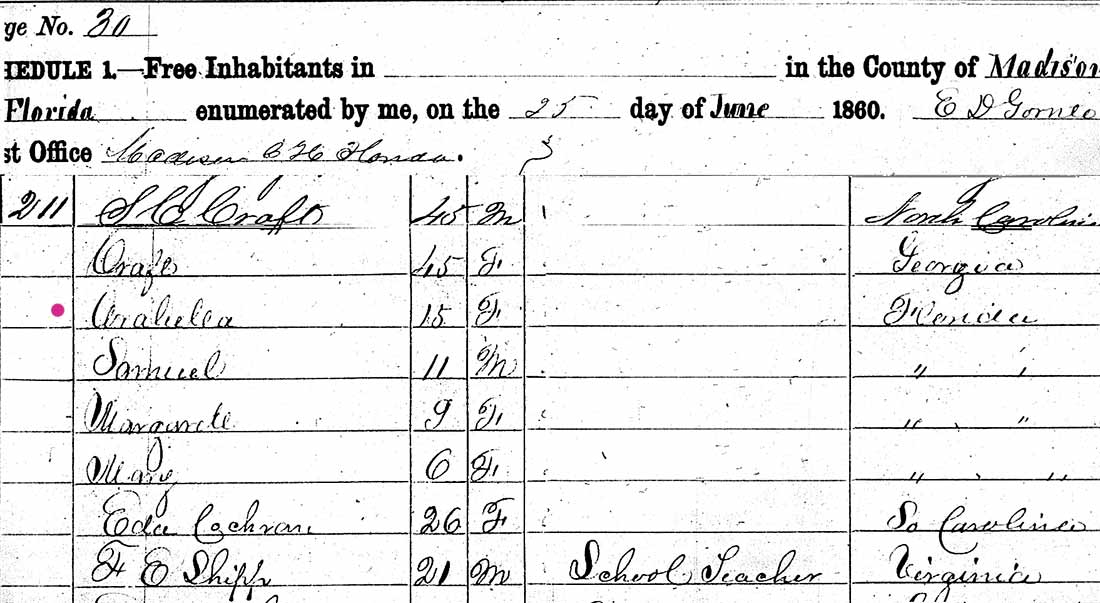
Now in 1860 the Craft
family was in Madison County. This record was
pieced together because Sam Craft was the last line
on the page
and the rest of his family on the top of the next
page. The enumerator wrote "Craft" for the
first entry on the next page, instead of Margaret, Sam's wife. Margarite, age 9 and May, age 6, were born between
the censuses so in all, Arabella one of six
children. |
Robert Nunez and Arabella Craft had two children,
Ruby, who was married to I. S. Giddens. a pioneer
grocer of Tampa, and Robert F. (Jr.), who was married to
Ellen Hale. Ruby Nunez and I.S. Giddens had three children:
Genevieve Giddens, who married Dr. Sheldon Stringer, Daisy
Giddens and Mary Giddens. The children of Robert
F. Nunez, Jr. and Ellen (Hale) Nunez were:
Robert (III), Mary, John
and Paul.
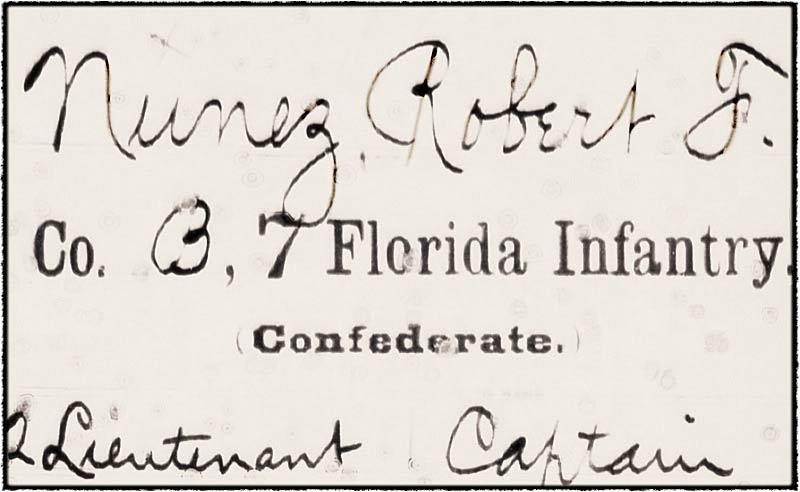 R.
F. NUNEZ JOINS THE CSA R.
F. NUNEZ JOINS THE CSA
Robert (I) joined the CSA on Mar. 10, 1862 in Tampa
as a 3rd Lieut. of Co. B,
7th Florida Regiment. A year later on Mar. 10, 1863
he was promoted to Captain. He fought in
Tennessee and Kentucky and was in Bragg's famous
march. Not accustomed to the colder climate, he contracted
pneumonia from which he never fully recovered.
Because of his illness he was released from the army
on Aug. 8, 1863 and returned to
Tampa.
**Grismer says that
R.F. Nunez sold his store and joined the Confederate
Army.
Image from Find-A-Grave by Jerry Barnard
|
MRS. NUNEZ'S SCHOOL
According to Education: From Its Beginnings in
the Territory To Present, by Norma Goolsby
Frazier, The Sunland Tribune, Vol. 19, Nov. 1993,
Journal of the Tampa Historical Society, Mrs.
Nunez opened
her school in 1862 shortly after marrying Robert F.
Nunez.
The year coincides with Robert's enlistment
with the Army, so this may have been Arabella's
means of support due to Robert selling his store. There
are no newspapers available from the Civil War
period 1862 to 1865 so any ads placed by Mrs. Nunez
during this period are unavailable.
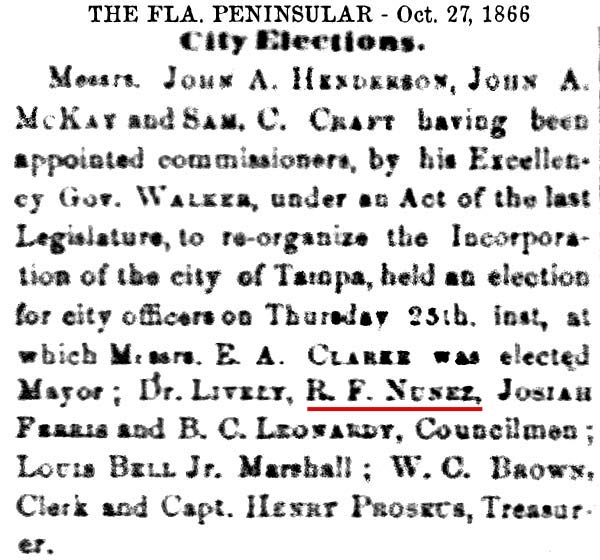 AFTER THE CIVIL WAR - A CIVILIAN NIGHT WATCH
ESTABLISHED AFTER THE CIVIL WAR - A CIVILIAN NIGHT WATCH
ESTABLISHED
In 1866, due to the
civil government having been dissolved during the
Civil War, the people decided that the city
government would have to be revived. This was
largely motivated by crime and disorder.
According to the Peninsular, freedmen with no means
of support were burglarizing homes and businesses at
all hours of the day and night, causing Tampans to
fear leaving their properties unguarded. (This
is putting it mildly.)
On October, 25
1866. Ed Austin
Clarke was
elected mayor
and Dr. L A.
Lively, R. F.
Nunez ,
Josiah Ferris
and B. C .
Leonardi,
councilmen. One
of the first
actions taken by
the city
officials was to
appoint Louis
Bell, Jr. as
City Marshall.
Below is a
portion of
Ordinance No. 5
authorizing a
citizens night
watch of the
city. All
white males over
18, regardless
of age, were
subject to be
chosen by the
City Council to
serve on a team
of four (or more
if needed) that
would "watch
over the safety
and good order
of the city"
within the city
limits from 9
p.m. to sunrise.
Those chosen
would be
notified
privately
between 9 a.m.
and 3 p.m. of
the day they had
to report for
duty, for three
designated but
separate days of
the week. There
would be no
exceptions to
serve except due
to sickness, and
at that, it had
to be certified
by a physician
within 6 hours
of duty time.
Sec. 5
authorized the
watch members to
be armed, at the
discretion of
the City
Marshall.
Due to its
length, much of
Sec. 2 and all
of Sec. 3 & 4
have been
deleted.
If you wish to
see all of
Ordinance No. 5,
click here,
then click the
image to see it
full size.
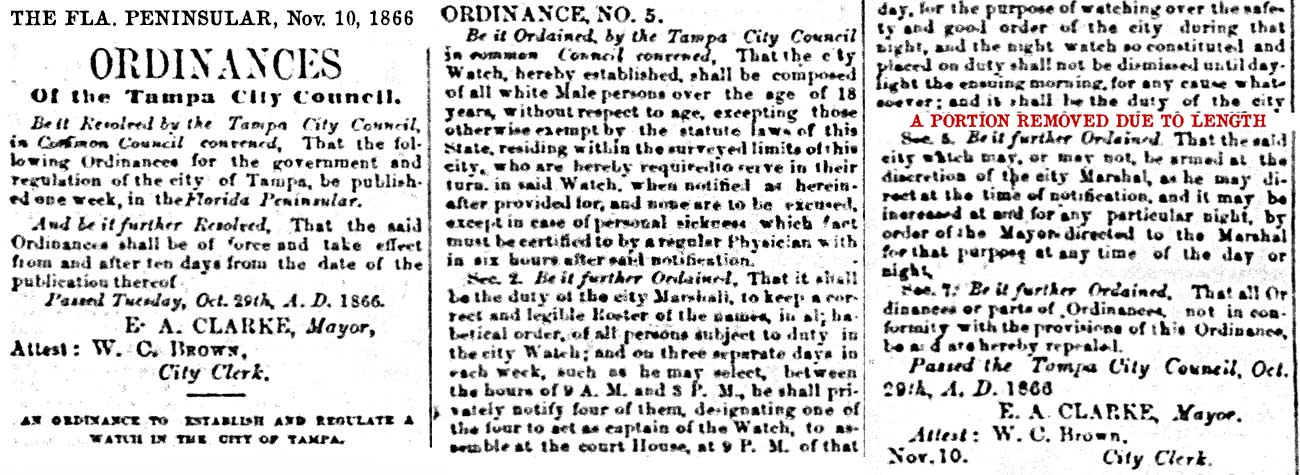
THE NUNEZ
FAMILY AFTER THE
CIVIL WAR

If Robert sold his store before the war, he must have started a new one because he continued to advertise and was listed among Tampa dry goods and grocery merchants after the war. |
|
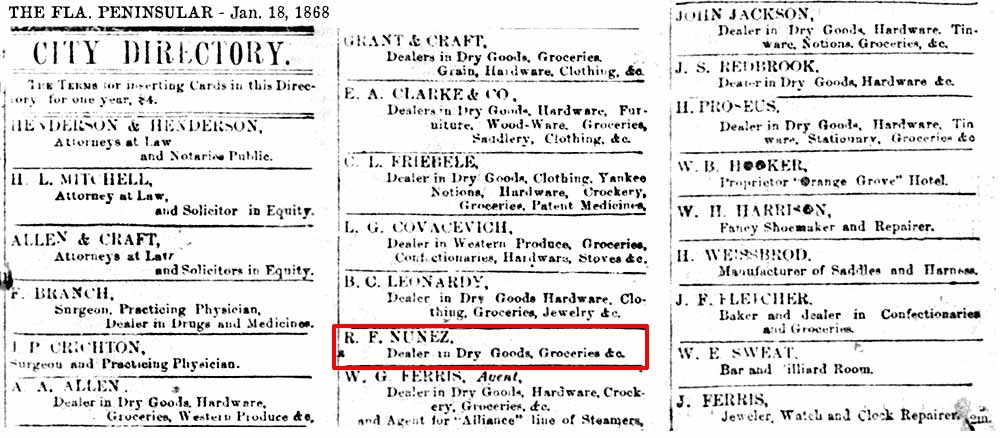
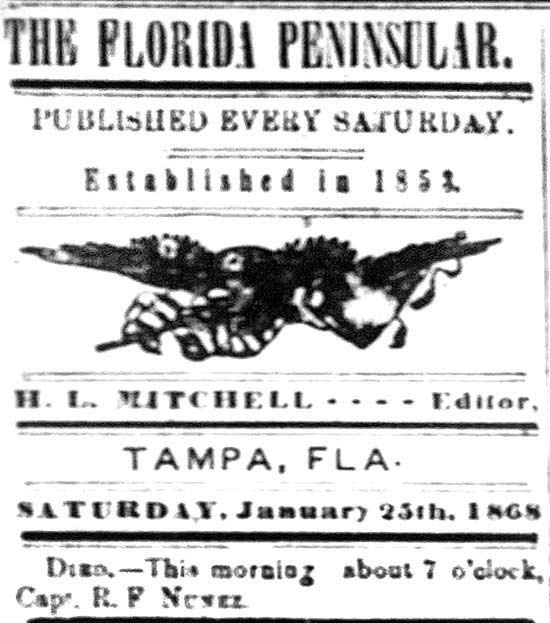
R. F. Nunez was listed in
the Peninsular's business directory for each issue through
Jan. 18, 1868. On the day of his death, his
listing did not appear.
DEATH OF ROBERT F. NUNEZ
Robert F. Nunez died on Jan.
25, 1868, leaving his 21 year old widow Arabella
and two children.
At right is all that
was printed in the PENINSULAR concerning his death.
(Three months of ensuing issues were inspected
carefully, page by page.) The brevity of this
announcement is highly unusual especially for Tampa
merchants and especially CSA veterans, who were
always given more than just one sentence.
|
One's first guess might be to say
that maybe Arabella couldn't afford an obituary.
But the Peninsular often included a news article
consisting of a paragraph of several lines
concerning the death of someone who lived in Tampa,
or even in a
distant county, and who had very little connection
to Tampa, if any at all, so it's very doubtful that
those were paid announcements. Also, Robert
was Rev. Samuel C. Craft's son-in-law, who at one
time was editor of the Peninsular, a private school
teacher, and attorney.
TampaPix has a theory. It
may have something to do with
Robert's possible heritage.
See more at the end of
Who were
Nancy and Emma Nunez? |
| |
|
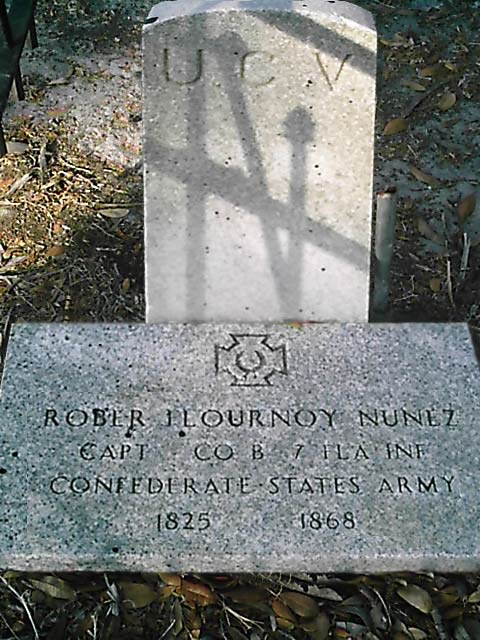
|
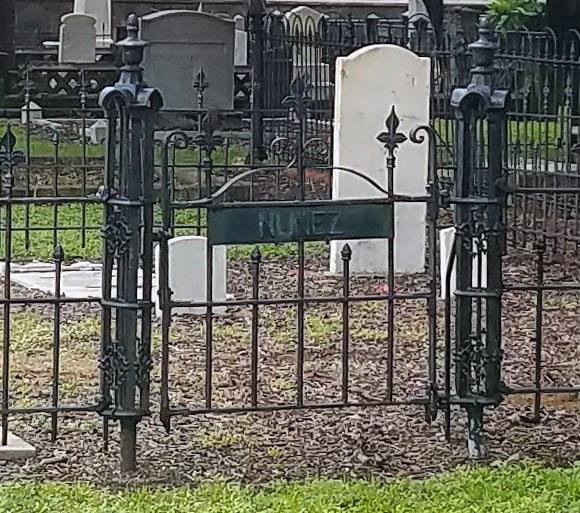 |
|
First rule of tombstone-making:
Spell the deceased's name correctly. |
OAKLAWN CEMETERY photos from Find-A-Grave
by Janet McCrary |
|
|
|
Two
months
after
her
husband's
death,
Arabella
had
some
women's
wear
to
sell.
It
appears
that
she
was
continuing
to
operate
Robert's
store.
She
ran
this
same
ad
again
on
Apr.
18,
1868. |
On
Aug.
1,
1868,
Arabella
advertised
more
new
merchandise
just
received;
this
time
in
addition
to
ladies
items,
some
dry
goods
and
staples
such
as
lard,
coffee,
rice
and
butter. |
|
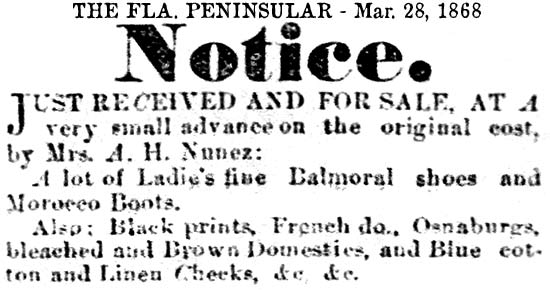
The first private school ads for Mrs. Nunez appeared in the Peninsular on Aug. 28, 1869, announcing her new school for small children opening on Sept. 6. She planned to teach in one room of her home. |
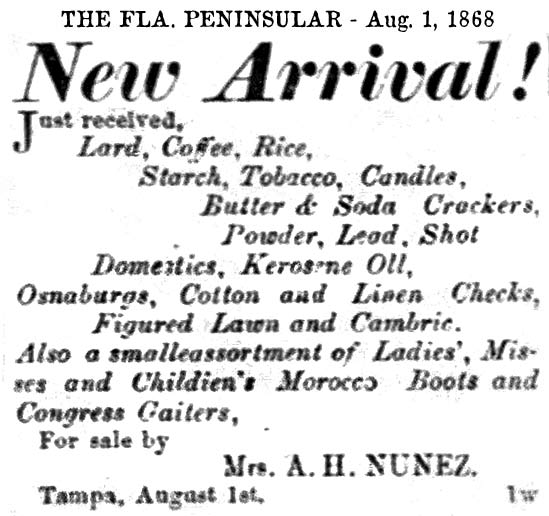 |
The Peninsular included their own
recommendation: "Mrs.
Nunez is in every respect well qualified to teach..."
Arabella was 23 years old at this time.


1870
Census, Tampa
Arabella Nunez and her children, Ruby & Robert
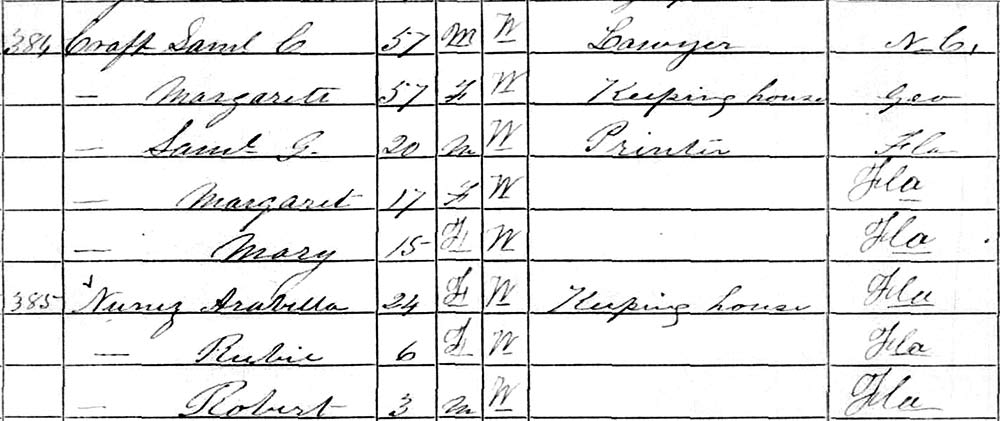
On this census, Arabella was living
next to her parents, Sam C. and Margaret Craft, and
some of Arabella's siblings.
Among other
occupations Sam Craft had (newspaper editor,
preacher, private school teacher,) Sam was also a
lawyer.
1880 Census, Tampa
Arabella Nunez and her children
-Teacher-b.jpg)
On the 1880 Census of Tampa, Arabella
was
listed as a teacher for the first time.
Arabella Helen Nunez
died Jan. 16, 1932 at age 85. She was living at 1707
N. Fla. Ave. at the time. Her obituaries in
the Tampa newspapers contained some historical
errors.
She didn't open the first private school in Tampa
and her husband wasn't killed in the Civil War.
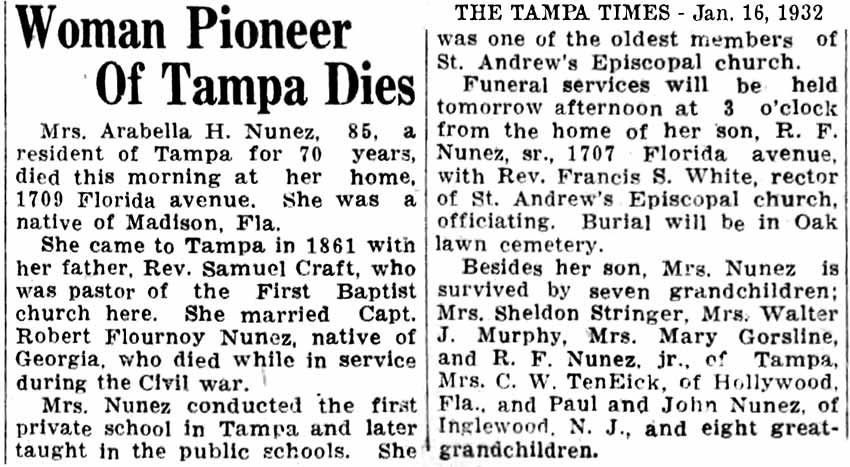
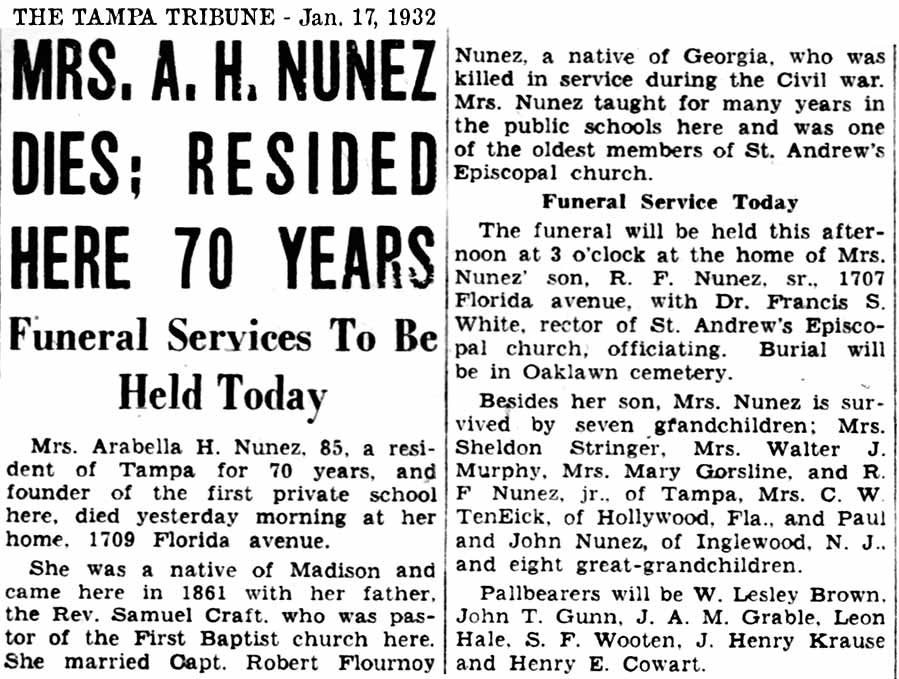
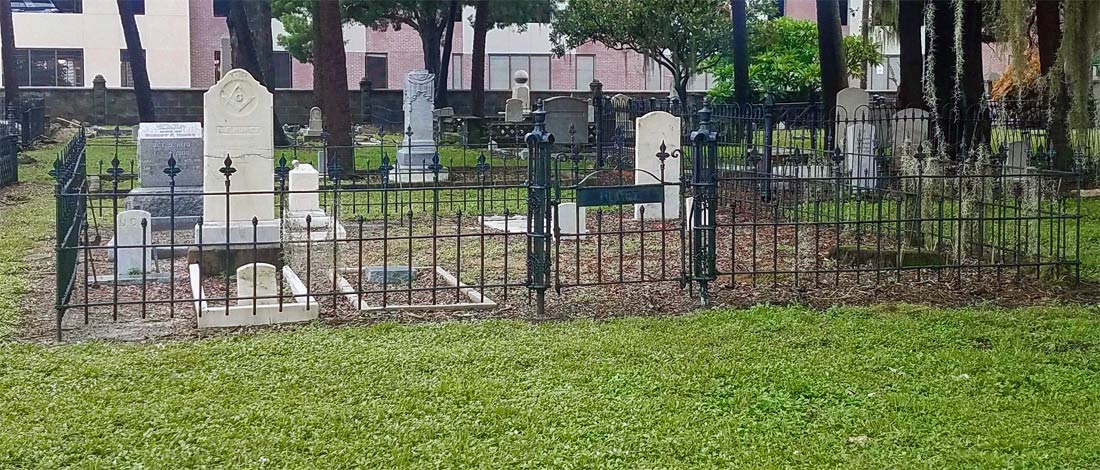
OAKLAWN CEMETERY
photo from
Find-A-Grave
by Janet McCrary
|
It
was the next superintendent, Wesley P. Henderson, who
began reaping the benefits of the strong arguments
that Crane presented for more facilities owned and
directed of the Hillsborough Board of Education.
 Wesley
P. Henderson was
elected
Superintendent
of Hillsborough
County Schools
in 1881
at the salary of
$150 per year.
Under W.P.
Henderson's
administration a
more
businesslike
management of
school finances
was established,
and there was
clear evidence
that he county
schools were
growing into a
real system. The
county
experienced
major growth and
expansion
including the
first
professional,
accredited
career
teacher/principal,
a full high
school
curriculum, the
purchase of
facilities for
schools and the
new construction
of school
buildings.
The Hillsborough County
public school system and
High School begins to take a
shape. Wesley
P. Henderson was
elected
Superintendent
of Hillsborough
County Schools
in 1881
at the salary of
$150 per year.
Under W.P.
Henderson's
administration a
more
businesslike
management of
school finances
was established,
and there was
clear evidence
that he county
schools were
growing into a
real system. The
county
experienced
major growth and
expansion
including the
first
professional,
accredited
career
teacher/principal,
a full high
school
curriculum, the
purchase of
facilities for
schools and the
new construction
of school
buildings.
The Hillsborough County
public school system and
High School begins to take a
shape.
In 1882
it was estimated that the cost of the 57 schools in
Hillsborough County would be $4,775. The
length of the term for these schools was fixed at
five months and in the Tampa schools at six months.
The
meager salaries of the teachers were paid at the end
of the year in one sum. An effort was made to
have monthly payments for the teachers but the Board
voted to continue yearly payments. It must
have been difficult for a teacher to work six months
with no pay and then at the end of the years' work
to receive as payment in full $150, or possibly $180
for the year. This made it necessary for the
teacher to have some other source of income or
occupation for the remainder of the year, and it
made it almost impossible to secure well-trained
teachers. Yet there were in those days men and
women who, as public school teachers, were a
splendidly constructive influence of training the
boys and girls who, partly because of that training,
were the leaders in the development of the sparsely
settled expanse of Hillsborough County into the
great center of agricultural, commercial and
industrial life of a great part of the state of
Florida.
We find
mere mention in these records of the names of a few
teachers, as Stephen M. Sparkman who for many years
afterwards was the chairman of the important Rivers
and Harbors Committee in Congress; William P.
Haisley, who in later years was a strong influence
in Florida as state school superintendent; Marietta
Cuscaden, Miss Prevatt and Mrs. A. H. Nunez, whom
great numbers of the leading citizens of the county
have remembered with gratitude and affection because
of their wise guidance during their childhood school
years. |
|
|
CONTINUED ON
NEXT PAGE
The First
County High School Curriculum at Tampa School No. 1 and its First
Six Locations
The Eight Homes of Hillsborough High School
TampaPix HOME
|
|
IRST
|
|
SOURCES
-
Florida Homes Magazine (M. Leo Elliott)
-
History of Hillsborough
County Public Schools, Compiled by the Department of Research
and Development: Judith Lombana Ed.D., Supervisor Richard Bair,
Ph.D. Jim Cain Author Graphics, Layout, June 2000, p. 42ff
(All
text in this feature presented in blue
italics is from this source.)
-
History of the City and the Tampa Bay Region of Florida,
by Karl H. Grismer, edited by D. B. McKay, 1950.
-
History of Hillsborough County, by E. L. Robinson, 1928
at the University of S. Florida Digital
Collections
-
History of Hillsborough High School,
by Lewis Rex Gordon, Class of
1984
-
Hillsborough High School, the First 100 Years 1885-1985, a
manuscript written by the faculty and alumni of Hillsborough
High School, 1985, published in the Sunland Tribune, Vol. 12,
Nov. 1986,
Journal of the
TAMPA HISTORICAL SOCIETY at the University of S. Florida Digital Collections
-
Hillsborough High School website
-
The Blue Book and History of Tampa Pioneers, by Pauline
Brown-Hazen, 1914
-
Wynelle Davis Gilbert,
Thomas Jefferson High School Alum & former curator of the
TJHS Museum in
the D. W. Waters Career Ctr.
-
Scanned newspaper images from
Newspapers.com - The Florida Peninsular, The Tampa
Herald, The Sunland Tribune, The Daily and Weekly Tampa Tribune,
The Tampa Times, The Charleston Mercury.
-
Various official records such as U.S. Censuses, Marriage
licenses & indexes, death & birth records at Familysearch.org.
-
Scanned newspaper images from Newspapers.com
The Florida Peninsular, The Tampa Herald, The Sunland
Tribune,
The Daily and Weekly Tampa Tribune.
|
| |
| |
|

